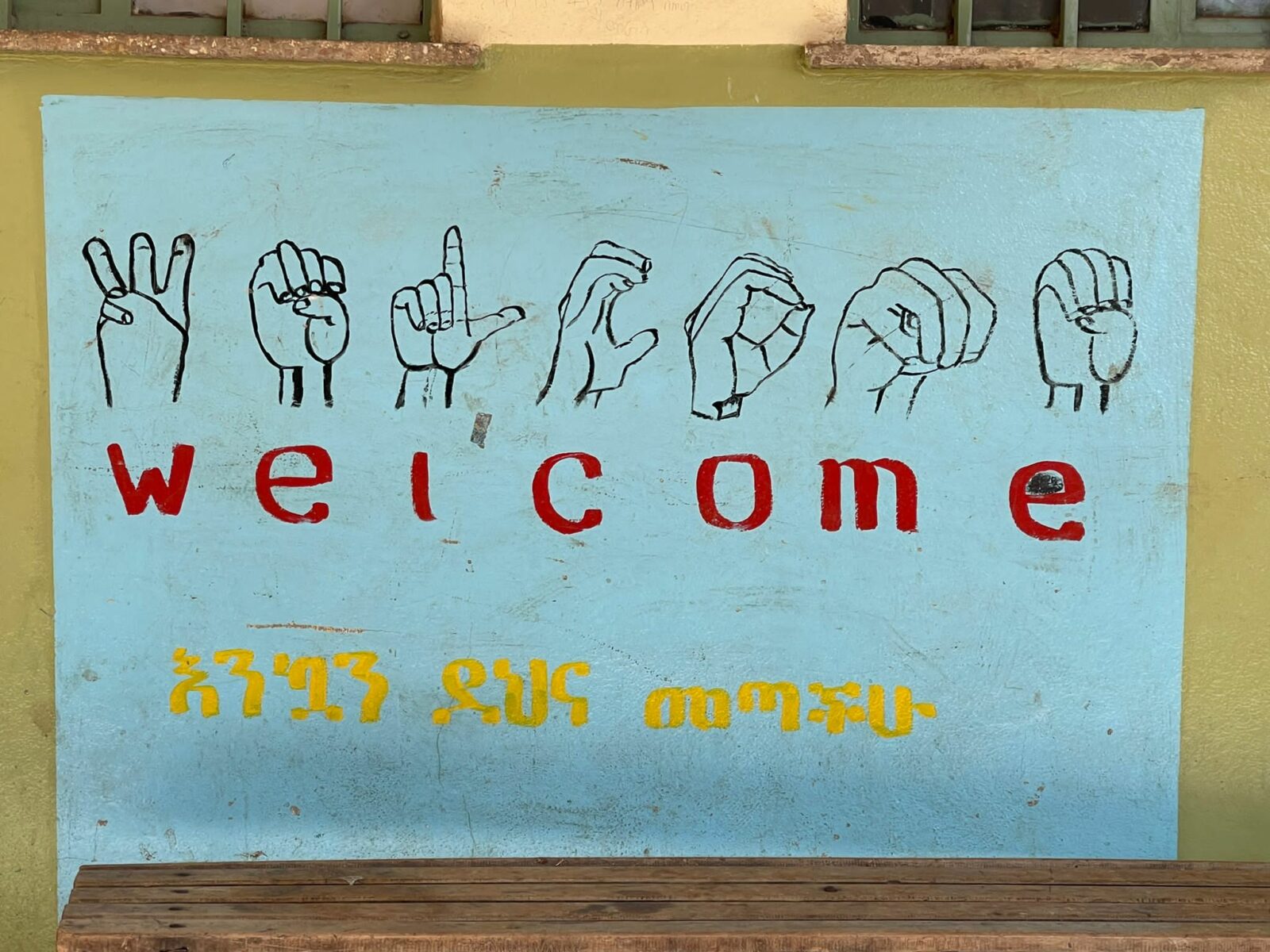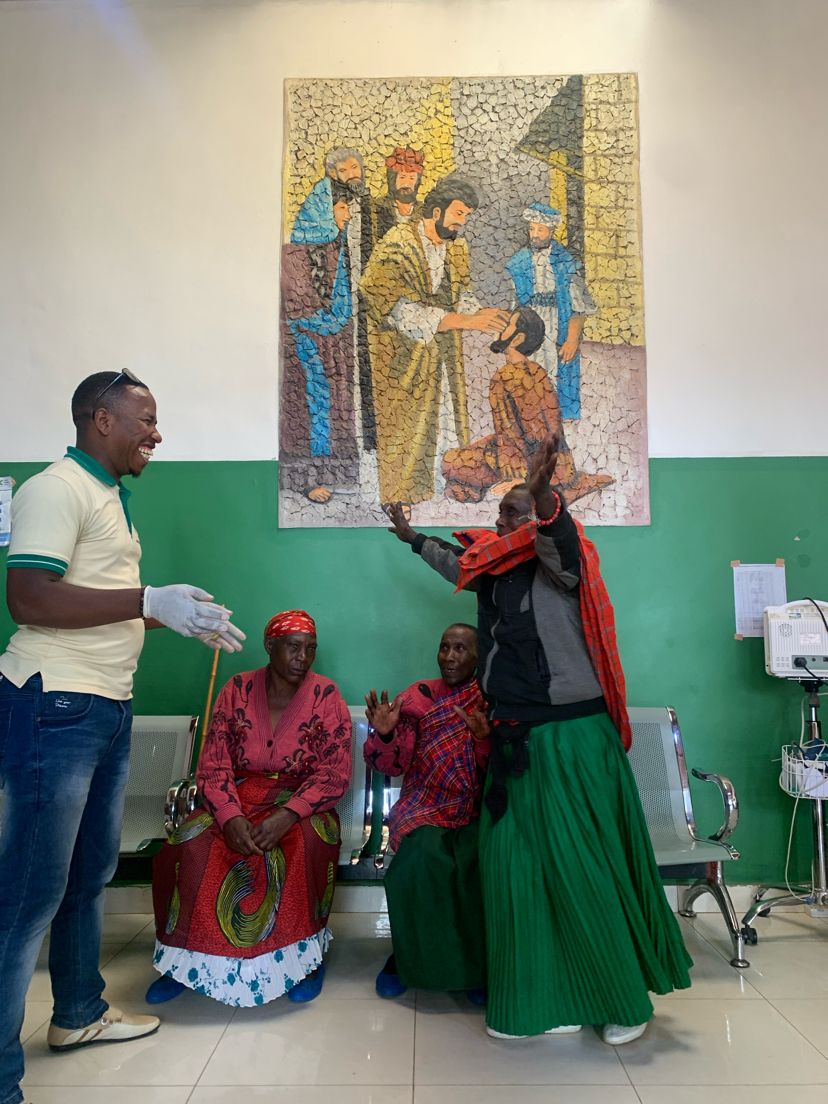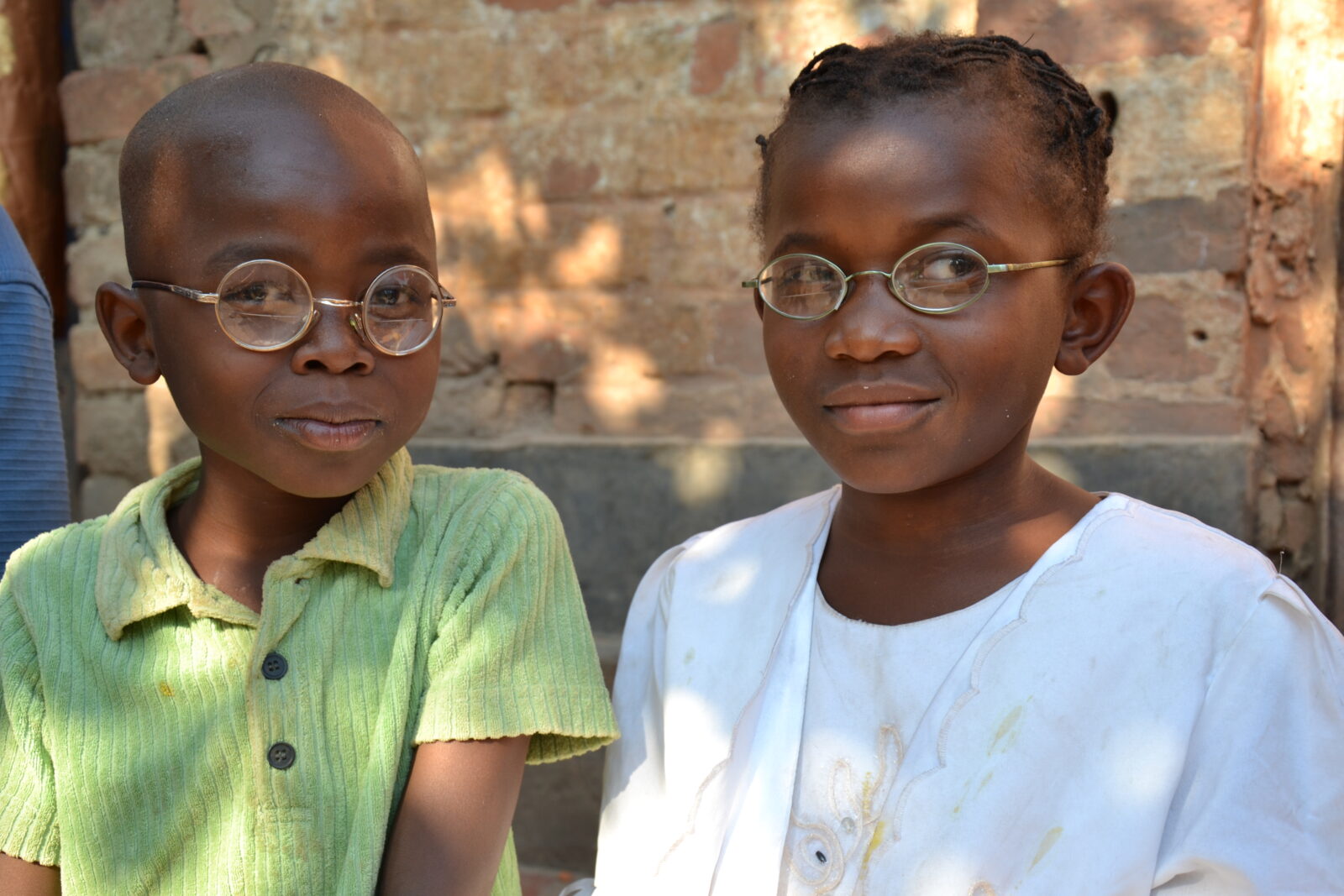
RESILIENCE
Annual Report SeeYou 2023

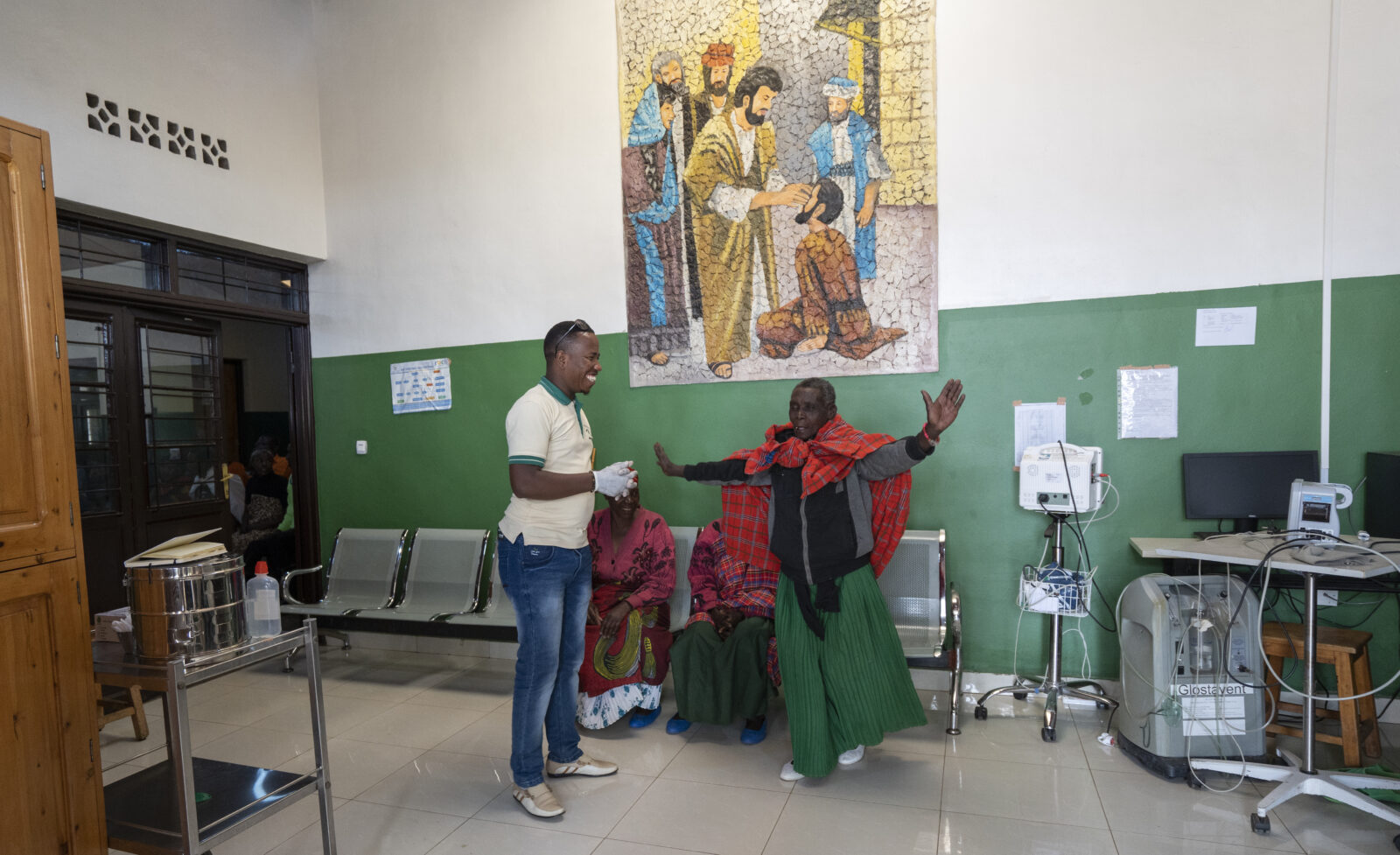
FOREWORD
Dicky Nieuwenhuis
FOREWORD
Confronting. Emotional. And sometimes discouraging. When I travel for SeeYou, ‘I often feel moved by the vast poverty, sorrow and pain in people’s lives, as well as the complexity of the problems they face. However, during the ambassadors’ trip to Rwanda, I had a completely different experience: celebration!
I can almost feel the explosion of joy again when I look at this picture. Here, I can see what makes the work of SeeYou so special for me. First of all, the joy about the tangible results. After years of blindness, two women can see again thanks to a cataract operation! Ardy and Regina, members of the same family, both have a sad story to tell. Ardy lost 5 of her 10 children during the genocide, and Regina had 12 children, but now only 4 of them are still alive. Inconceivable. And yet, I witnessed the joy these women are capable of feeling. They clearly possess incredible resilience.
I also see everything that is not visible in this photo. All of the steps that led up to this simple medical intervention. The local health workers who work in the smallest villages. The medical personnel in the district hospitals who were trained to recognise eye problems at an early stage.
There was a celebration in the eye clinic in Kebaya when the bandages were removed from the eyes of Randy and Regina. The eye clinic employees and our SeeYou team were wholeheartedly embraced. All of this joy occurred against the background of a painting of Jesus who placed his fingers on the eyes of a blind man. It could not have been more symbolic.
In 2023, we celebrated our 40th anniversary. For 40 years, we have been able to give many people – such as Regina and Randy – renewed hope, perspective for the future and joy. Forty years in which people like them have taught us what resilience means. We are grateful to everybody who has contributed to our work over the past 40 years, from eye operations to preventing blindness in areas with extreme poverty to strengthening the business skills of women with a disability.
In this annual report, you can read the for whom, how, and why we worked in 2023, and the results that yielded. I hope the stories you read will make you smile and, who knows, they may inspire you to live a resilient life too.


Dicky Nieuwenhuis
Executive Director SeeYou

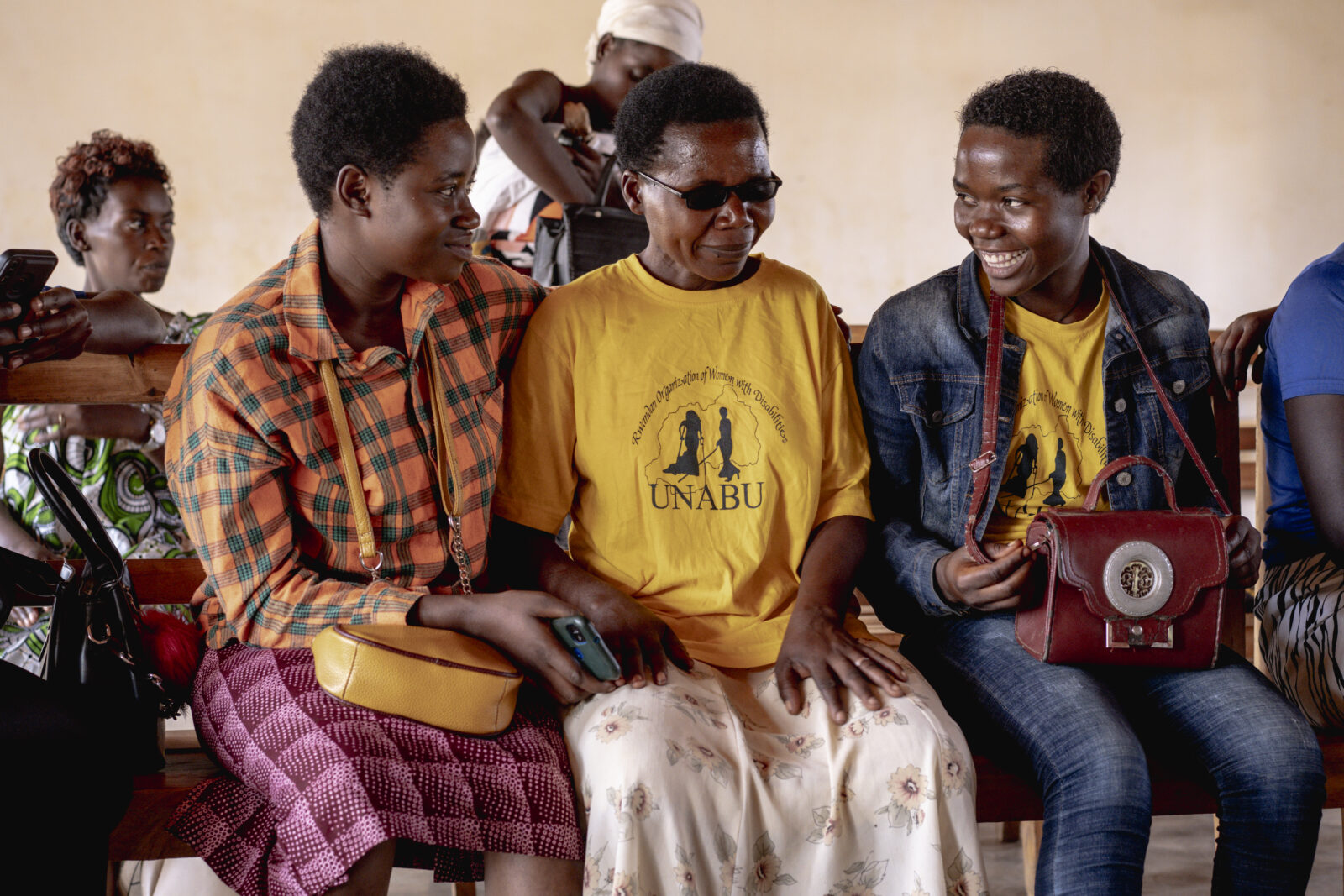
Vision and mission
Our motivation
Every human being is precious and valuable. So, we are deeply concerned when persons with disabilities lack access to essential facilities and suffer injustice due to their disability.
Our mission
Our mission is to achieve equal access to eye care, health care, education and livelihood for children and adults with a disability in Africa and Asia.
We work in seven countries – Ethiopia, Rwanda, South Sudan, Sudan, Uganda, Cambodia and Indonesia – to prevent blindness, provide qualitatively good eye care, food security and low-threshold education for persons with disabilities, and we aim to realise inclusive communities as well.
We help persons with a (visual) disability to stand up for equal rights and we assist advocacy groups to gain a voice in their dealings with their governments. In the Netherlands, we also lobby for an inclusive development cooperation policy.
Our strategy
3 themes
Inclusive eye care
We work towards preventing eye diseases, diagnosing and treating eye conditions, and realising rehabilitation. We mainly do this in the poorer areas of Ethiopia, Rwanda and Indonesia.
Access to care, education and employment
We want everybody to be fully integrated into society, and for persons with a visual or other disability to have equal access to healthcare, education and employment. We make sure that children with a disability can go to school and, after they finish school, we offer them guidance in finding employment.
Equal rights
We help and empower persons with disabilities and their advocacy organisations to stand up for their rights. And we challenge governments to meet the needs of persons with disabilities.
7 core elements
We have one single focus: persons with a (visual) disability
In Africa and Asia, persons with disabilities are almost always among the poorest of the poor. Within this group of people, we focus specifically on persons with a visual impairment, children, and girls and women.
We share our knowledge
We gladly share our 40 years of experience and expertise with other development organisations so they can help persons with a (visual) disability. We strengthen partners through capacity building and help local and international organisations with developments in the area of inclusion.
We ensure honest and ethical behaviour
Our target group is at greater risk of being treated unequally, which is why we pay close attention to integrity. We want to ensure the safety of everyone involved in our projects and our organisation.
We give 85% of our income to projects
We want 85% of every euro to go to projects for eyecare, inclusion and awareness. Then, each euro donated will have an even greater impact.
We work on the basis of equality with local organisations
We do not work alone and would not be able to achieve our goals if we did. We always work together with persons with disabilities, the organisations that represent them, and eye clinics and civil society organisations rooted in the local community.
We work on the basis of Christian values
We believe that every person is precious and valuable. These are values we see reflected in the Bible, and they form the basis for our work. And they are the reason why we are committed to all persons with disabilities, regardless of ethnicity, religion or other characteristics.
We see donors as our partners
We consider donors, charitable trusts, and other stakeholders to be strategic partners on a joint mission: to improve the quality of life of persons with disabilities.
We have one single focus: persons with a (visual) disability
In Africa and Asia, persons with disabilities are almost always among the poorest of the poor. Within this group of people, we focus specifically on persons with a visual impairment, children, and girls and women.
We work on the basis of equality with local organisations
We do not work alone and would not be able to achieve our goals if we did. We always work together with persons with disabilities, the organisations that represent them, and eye clinics and civil society organisations rooted in the local community.
We share our knowledge
We gladly share our 40 years of experience and expertise with other development organisations so they can help persons with a (visual) disability. We strengthen partners through capacity building and help local and international organisations with developments in the area of inclusion.
We work on the basis of Christian values
We believe that every person is precious and valuable. These are values we see reflected in the Bible, and they form the basis for our work. And they are the reason why we are committed to all persons with disabilities, regardless of ethnicity, religion or other characteristics.
We ensure honest and ethical behaviour
Our target group is at greater risk of being treated unequally, which is why we pay close attention to integrity. We want to ensure the safety of everyone involved in our projects and our organisation.
We see donors as our partners
We consider donors, charitable trusts, and other stakeholders to be strategic partners on a joint mission: to improve the quality of life of persons with disabilities.
We give 85% of our income to projects
We want 85% of every euro to go to projects for eyecare, inclusion and awareness. Then, each euro donated will have an even greater impact.
Read the full version of our strategy meerjarenstrategie.
Our pathway to change
If we
- support children and adults in Africa and Asia with a (visual) disability with (eye) care, education;
- make care institutions, schools, companies and governments more accessible;
- encourage persons with disabilities, their advocacy groups and their community to stand up for equal treatment;
then children and adults with a diability will
- be seen and heard by their family, community and the society they live in;
- have better and more equal access to essential facilities;
- experience fewer barriers in their lives;
so that
persons with (visual) disabilities in Africa and Asia receive equal treatment and experience a better quality of life.

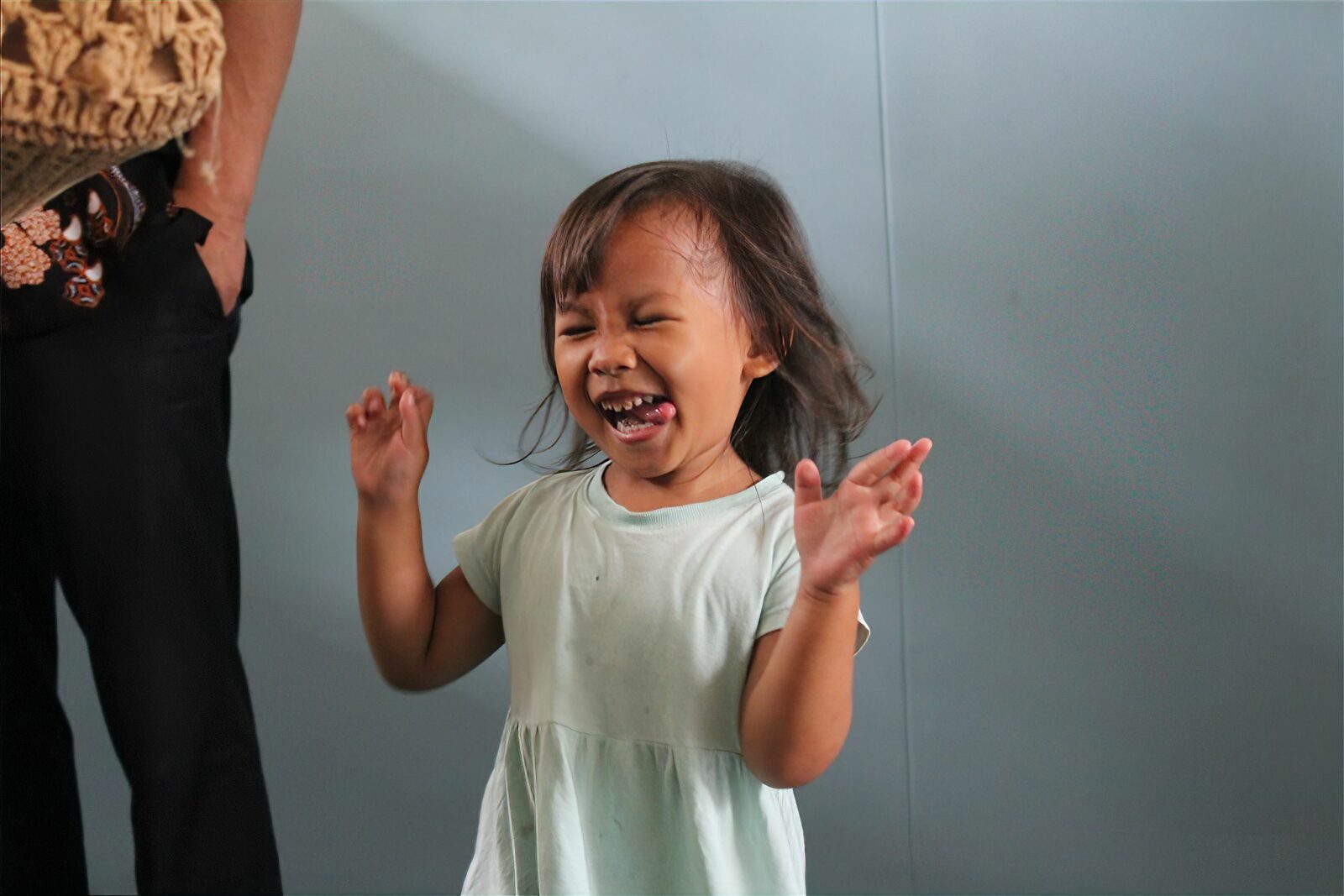
Impact
Together with you and our local partners, we have achieved the following in 2023:
127.063
eye tests
5.829
pairs of glasses issued
37.784
eye care treatments
7.390
eye operations
Access to:
Vocational education or training for
2.441
young persons with disabilities
Healthcare for
13.553
persons with disabilities
Inclusive education for
1.575
children with a disability
Disability Rights Advocacy training for
327
people
Overview of project countries and partner organizations
| Project | Land | Partner |
|---|---|---|
| Every Life Matters | Rwanda | The Umbrella of Organisations of Persons with Disabilities in the Fight against HIV/AIDS & for Health Promotion (UPHLS) |
| Every Life Matters | Ethiopia | Ethiopian Centre for Disability and Development (EDD) |
| EmployAble | Ethiopia | Ethiopian Centre for Disability and Development (EDD) |
| EmployAble | Rwanda | Umuryango Nyarwanda w’Abagore Bafite Ubumuga (ENABU) |
| Inclusive eye care | Rwanda | Kabgayi Eye Unit (KEU) |
| Inclusive eye care | Ethiopia | Grarbet Thehadiso Mahber GTM) |
| Digital access | Ethiopia | Ethiopian Centre for Disability and Development (ECDD) / Bartiméus |
| Inclusive education | Cambodia | People’s Action for Inclusive Development (Pafid) / Krousar Thmey (KT) |
| Capacity Development PAfID | Cambodia | People’s Action for Inclusive Development (Pafid) |
| Inclusive villages | Indonesia | People’s Action for Inclusive Development (Pafid) / Pusat Rehabilitasi YAKKUM (PRY) |
| Learning Unlocked | Indonesia | Pusat Rehabilitasi YAKKUM (PRY) |
| Into Business Rwanda | Rwanda | The Umbrella of Organisations of Persons with Disabilities in the Fight against HIV/AIDS & for Health Promotion (UPHLS |
| MUB-project (our health, our skills, our future) | Rwanda | The Umbrella of Organisations of Persons with Disabilities in the Fight against HIV/AIDS & for Health Promotion (UPHLS) / Rwanda National Union of the Deaf (RNUD) |
| We are Able! | Uganda | Light for the world Uganda |
| We are Able! | South Sudan | Light for the world South Sudan |
| We are Able! | Soedan | Action on Disability and Development (ADD) |
| We are Able! | Netherlands | Dutch Coalition on Disability and Development (DCDD) |

Inclusive eye care
49110
eye tests on schoolchildren
1581
families received financial support for treatment
5829
children and adults received a pair of glasses or other visual aid
We work on prevention of eye diseases, diagnosis and treatment of eye diseases and rehabilitation. We do this mainly in the poorer areas of Ethiopia, Rwanda and Indonesia.
THIS YEAR’S HIGHLIGHTED RESULTS:

Breaking the cycle of poverty with eye care
Rwanda
The consequences of losing your sight or living with a visual disability are immense for every adult and child. But that is certainly the case for children in Rwanda. Due to a visual disability, they have limited access to education and, therefore, a lower chance of obtaining employment later. Often, this is how a cycle of poverty and social isolation is set in motion.
The situation is particularly harrowing in the western province of Rwanda, where only very basic eye care is available. Therefore, we want to improve access to eye care and the quality of eye care at the local level. In 2023, we trained 4 ophthalmologists, 350 nurses from health centres, 450 local health workers and 450 teachers in eye care.
From the western province, 1,236 children were referred to the eye hospital of our partner Kebaya Eye Unit (KEU). There, they helped 4,476 children with eye conditions. For example, they helped 183 premature babies with a retinal defect or with retinoblastoma – a form of cancer. In addition, an experienced American ophthalmologist gave 25 children a cornea transplant.
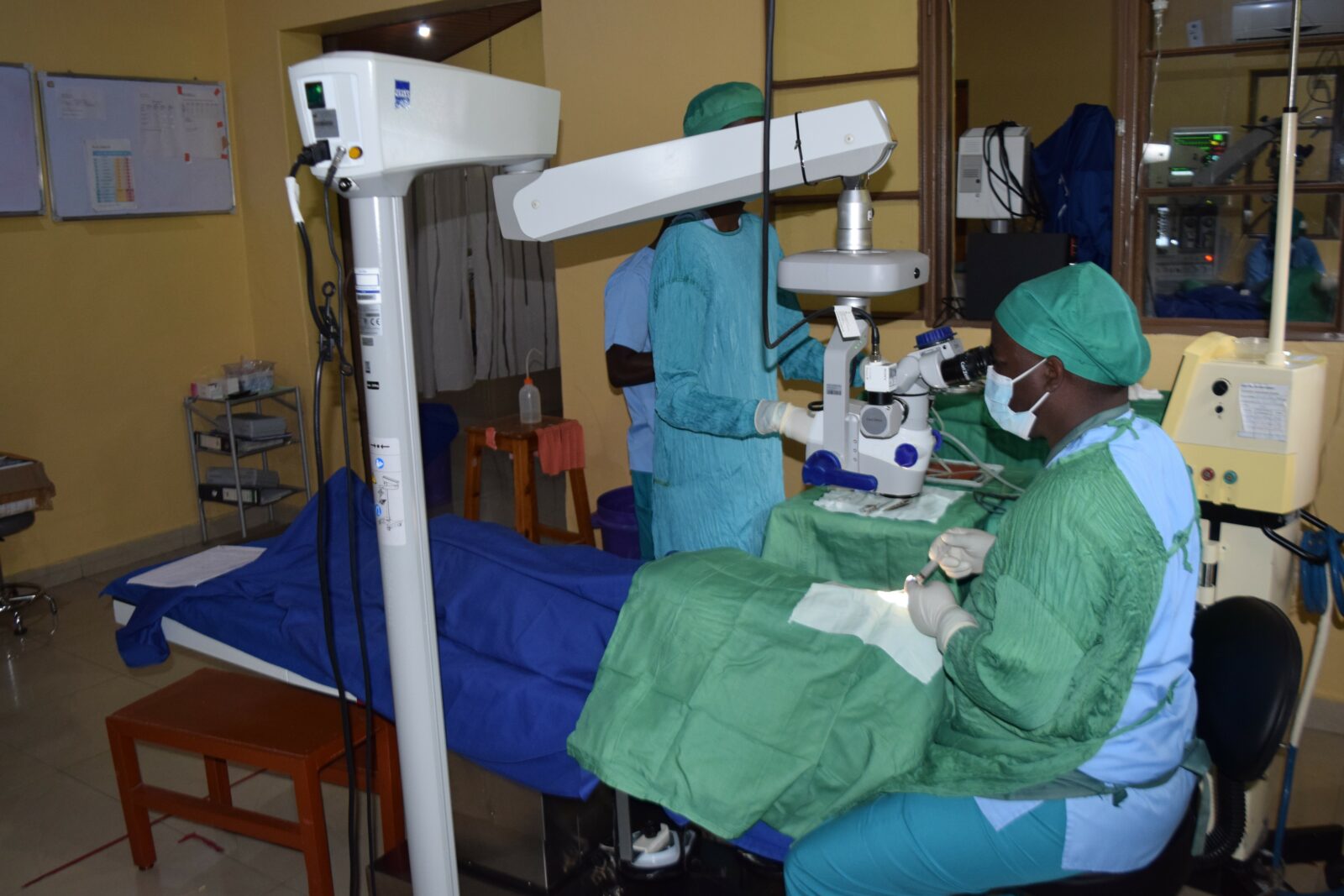
Preventing blindness and visual impairment in rural areas
Ethiopia
In large parts of Ethiopia, healthcare is difficult to access due to poor infrastructure, a lack of qualified medical personnel and an acute shortage of medicines. There is a major dearth of well-qualified ophthalmologists and optometrists. For example, there are just 1.4 ophthalmologists available per 1 million inhabitants. In the Netherlands, we have no less than 37.6 ophthalmologists for that same number of people.
There is a lot of blindness and visual impairment in four rural areas of Ethiopia, which could have been prevented with the right preventative measures and eye care. So, a large part of this project consists of awareness campaigns and eye tests. Last year, the mobile eye care teams visited rural areas on 158 occasions. During these visits, they screened a total of 43,000 people and performed 537 operations on location. Also, more than 2700 people have received cataract or eyelid operations in the eye hospital. In collaboration with the Ethiopian St. Paul’s Hospital Millennium Medical College, the hospital employed an experienced ophthalmologist to perform complicated operations and supervise trainee doctors.

Campaign for clean water
Ethiopia
There are strong links between poor hygiene and trachoma, an inflammatory eye disease that occurs a lot in Ethiopia. The inflammation gives rise to swollen eyelids and red and watering eyes. If this inflammation is not treated, it can lead to blindness. And yet, the disease can easily be prevented by simple hygiene measures, such as washing your hands with soap and washing your face with clean water.
We therefore raised funds for water pumps during a large campaign last year. These pumps will give people in central Ethiopia access to clean water and improved hygiene. Through this initiative, we can prevent blindness among children and adults. In 2024, two water pumps were placed by our partner Garret Tehadiso Mahber (GTM).
“Kabgayi was too far away and the treatment too expensive”
“In August 2023, I lost my sight, and it became almost impossible for me to carry out my daily tasks. My father had not paid our health insurance, and so I could not go to the hospital for medical help. Fortunately, one of my uncles knew how important it is to treat eye conditions at an early stage. My father decided to sell our cow so that I could receive help after all.
At the hospital, they suspected I had experienced a retinal detachment and that I would have to go to the Kabgayi Eye Unit for treatment. I explained to the healthcare workers that this was not an option, as Kabgayi was far away, the treatment very expensive, and we had used all the money from selling the cow to pay for the trip to the hospital. Then the social worker at the hospital told me I was eligible for the SeeYou Fund: they would pay the travel costs and treatment. I am very grateful for that because, as it turned out, I had indeed suffered a retinal detachment. Doctor Theophile from KEU performed the operation and gave me eyedrops and information to take home. Now I recognise my father again!”
Eric (15) from Nyabihu district in Rwanda
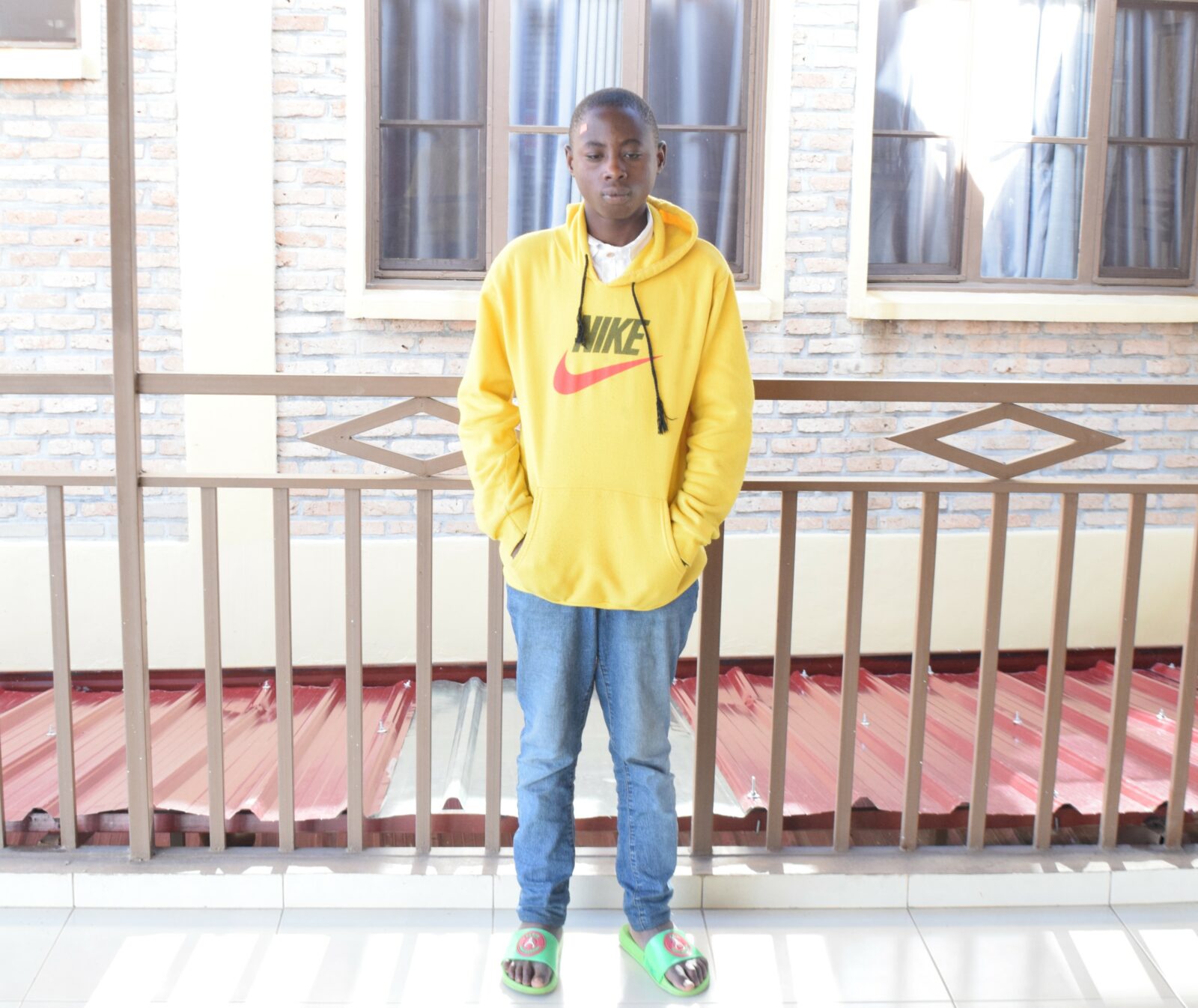
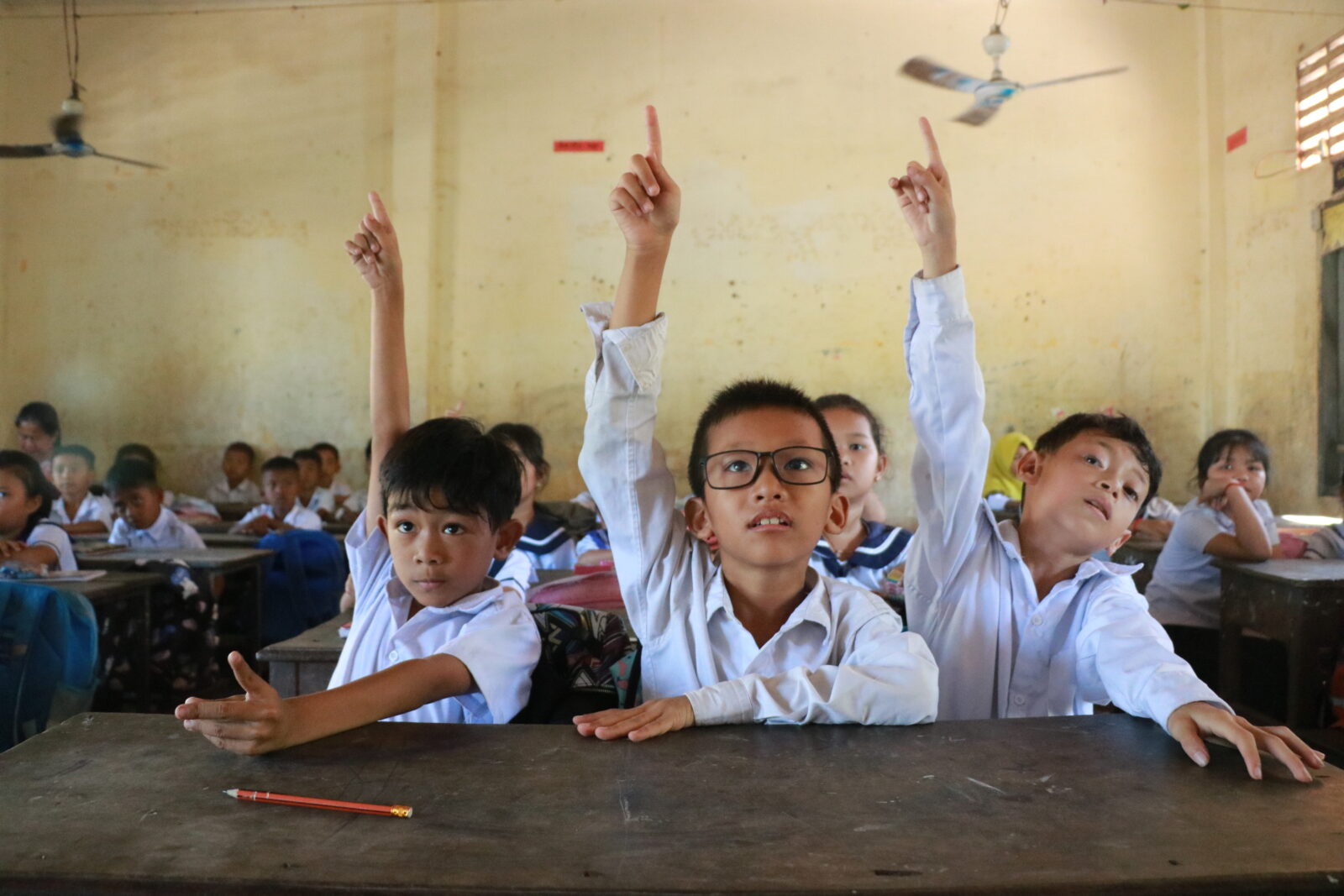
Access to care, education and employment
2441
young people in Ethiopia and Rwanda received vocational training and training in social skills
24
schools in Cambodia received resources
1730
elderly and people with disabilities in Indonesia had access to proper care
We want a full place in society for everyone. And equal access to care, education and work for people with a visual or other disability. We ensure that children with disabilities can go to school and then guide them towards work.
THIS YEAR’S HIGHLIGHTED RESULTS:
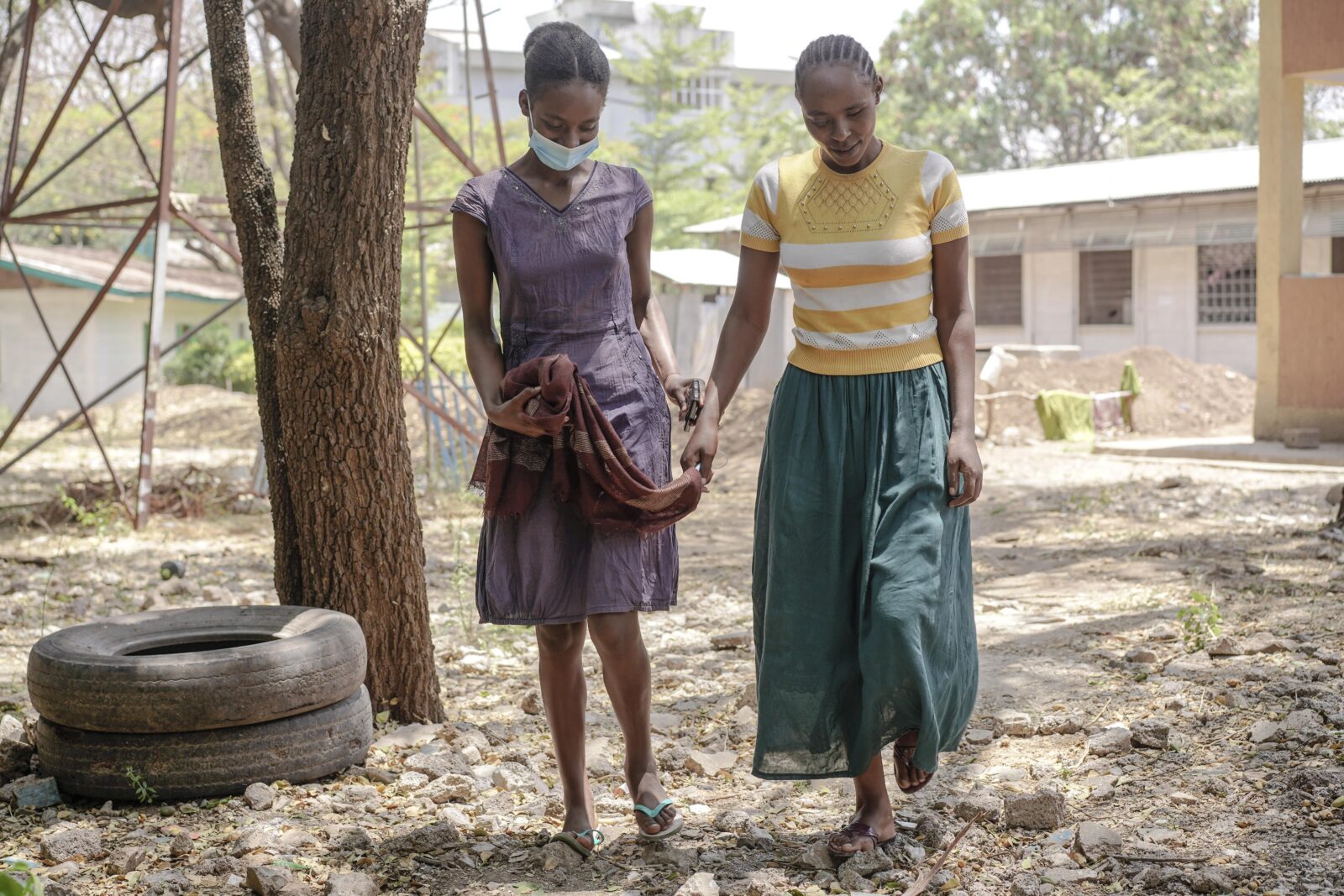
Success of Every Life Matters receives attention
Ethiopia en Rwanda
Persons with disabilities in Rwanda and Ethiopia experience many barriers in accessing care, which range from prejudices, difficult physical access and financial obstacles to a lack of knowledge among care employees. That is why we work towards inclusive and appropriate care.
Our approach is successful:
- The Missing Billion – an international initiative that addresses governments about the subject of inclusive healthcare and helps them to develop this – has recognised Every Life Matters as an example of good practice. That means this project serves as an example for NGOs and donor organisations that want to make their healthcare projects inclusive.
- Employees from hospitals and government healthcare departments are positive about how much our project contributes to the development of inclusive healthcare in Ethiopia. They explain why in a video from our partner organisation, the Ethiopian Center for Disability and Development (ECDD). In this video, persons with disabilities talk about the treatment or medical aids that have made a positive difference in their lives.
- EU-Cord published an article in English about Every Life Matters entitled: : Four factors to disability-inclusion in health projects.
Support for women who were the victim of sexual violence
Women and girls with a disability have a three times higher risk of being the victim of sexual violence. Our partners provide information and advice to healthcare employees and civil servants in order to prevent that. Last year, at two health centres, we started supporting girls and women who have become the victim of (sexual) violence.
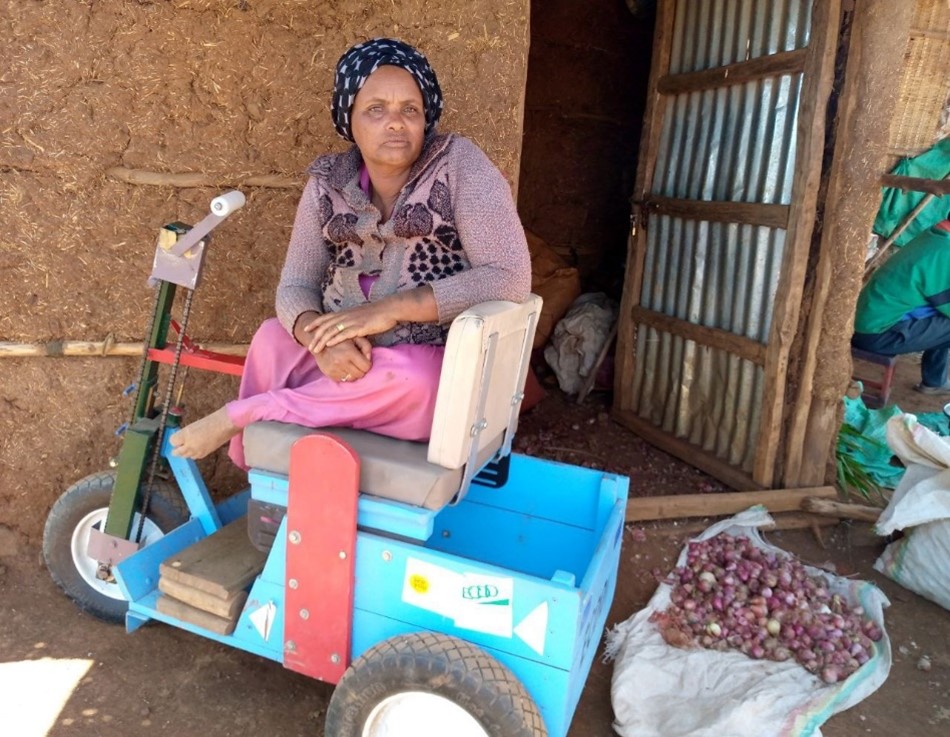
“I now know where I will be really listened to and seen”
“When I was a child, my lower legs became paralysed. That meant I could not attend school but I learned to accept that. With the help of my family, I was taken in a barrow to the market so that I could earn a modest income with a little business.
And then, one day, I developed a hip infection. Because of the hard metal floor of the barrow, the infection gradually worsened’. My family was afraid of being sent away by the health clinic, so we did not go there for assistance. I felt helpless. However, that changed when I received a wheelchair via the Every Life Matters project. My family and people in the market are surprised when they see how easily I can move myself around in that chair. We now know where I can go for accessible healthcare, a place where I am really listened to and seen.”
Aster (35) now enjoys good health again and has been brought into contact with the savings group of the local advocacy group for persons with disabilities.
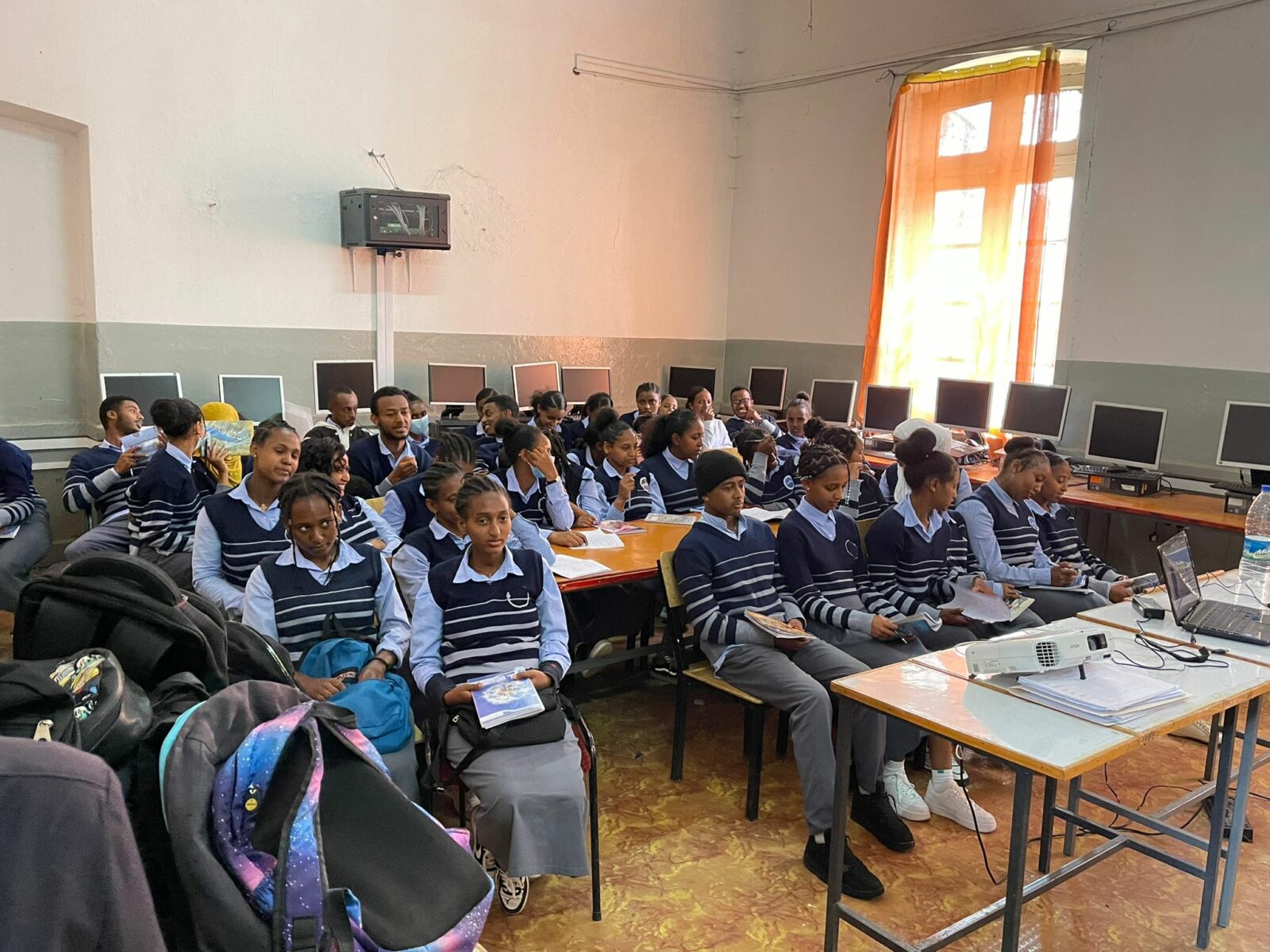
Digital access for pupils with a disability
Ethiopia
Last year, we started a fantastic pilot project. Together with Bartiméus Fund, we worked on improving digital access for pupils with a visual disability in Ethiopia. After visiting the project, we carried out a project analysis and drew up an action plan. We selected two schools in Addis Ababa to participate in the pilot, a primary school and a secondary school with 39 and 59 pupils, respectively, who have a visual disability. With the help of an expert from Bartiméus, we will coach teachers in 2024 so that digital education is also accessible for children with a visual disability.

EmployAble gives 2000 young persons with disabilities a chance
Ethiopia and Rwanda
In 2023, we completed three multiannual EmployAble projects. EmployAble works towards social inclusion of young persons with disabilities (especially women) through vocational training, awareness, advocacy campaigns and the creation of jobs so that these young people can participate on an equal footing in both education and on the employment market.
Across two projects in Rwanda and one in Ethiopia, 2,441 young people – most of whom have a disability – received vocational training and training in social skills. This gives them more self-confidence, greater motivation and a higher chance of employment and social participation in society. This is reflected in the results, which show that 73% of the participants found a job or started their own business.
Together with our partners, we are looking for donors to develop and implement the next phase of EmployAble. In this phase, we want to bring together the different partners and advocacy organisations so that we can jointly improve access to employment and income and increase mutual involvement.
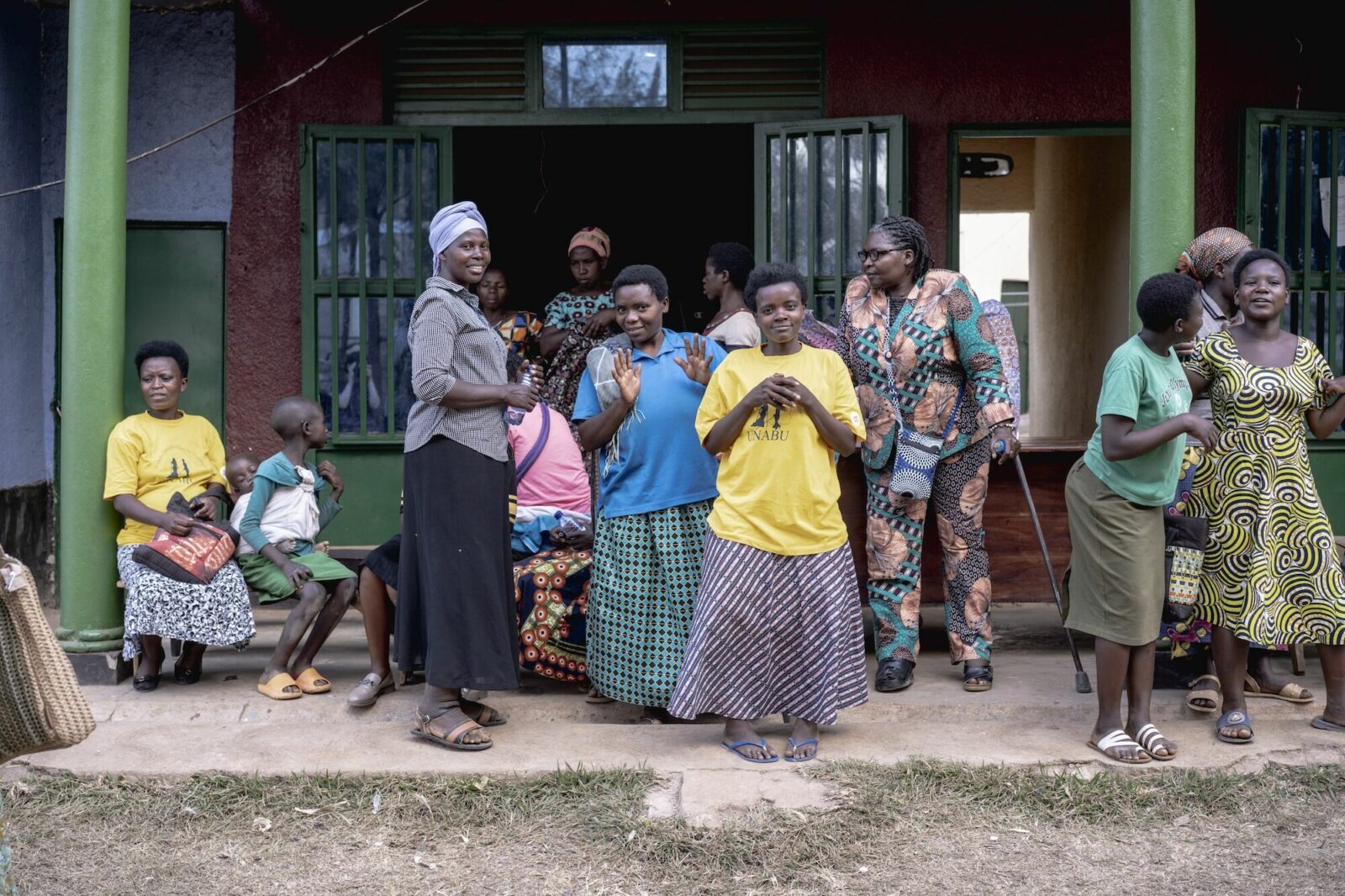
“You only have a say if you contribute money”
“During this project, the self-confidence of the participating women grew considerably. Here, you only have a say if you contribute money to the family, and that certainly applies to women with a disability. However, through this project they discovered that they could contribute something. For example, one of the groups came up with the idea in their business plan – which they wrote at the end of the training – to adapt to climate change by investing in fruit trees, the fruit of which will provide both food and income. It was really amazing and valuable that they thought about that!”
Gaudence Mushimiyimana, co-founder and director of Umuryango Nyarwanda w’Abagore Bafite Ubumuga (UNABU), which in English means the Rwandan Organisation for Women with a Disability.
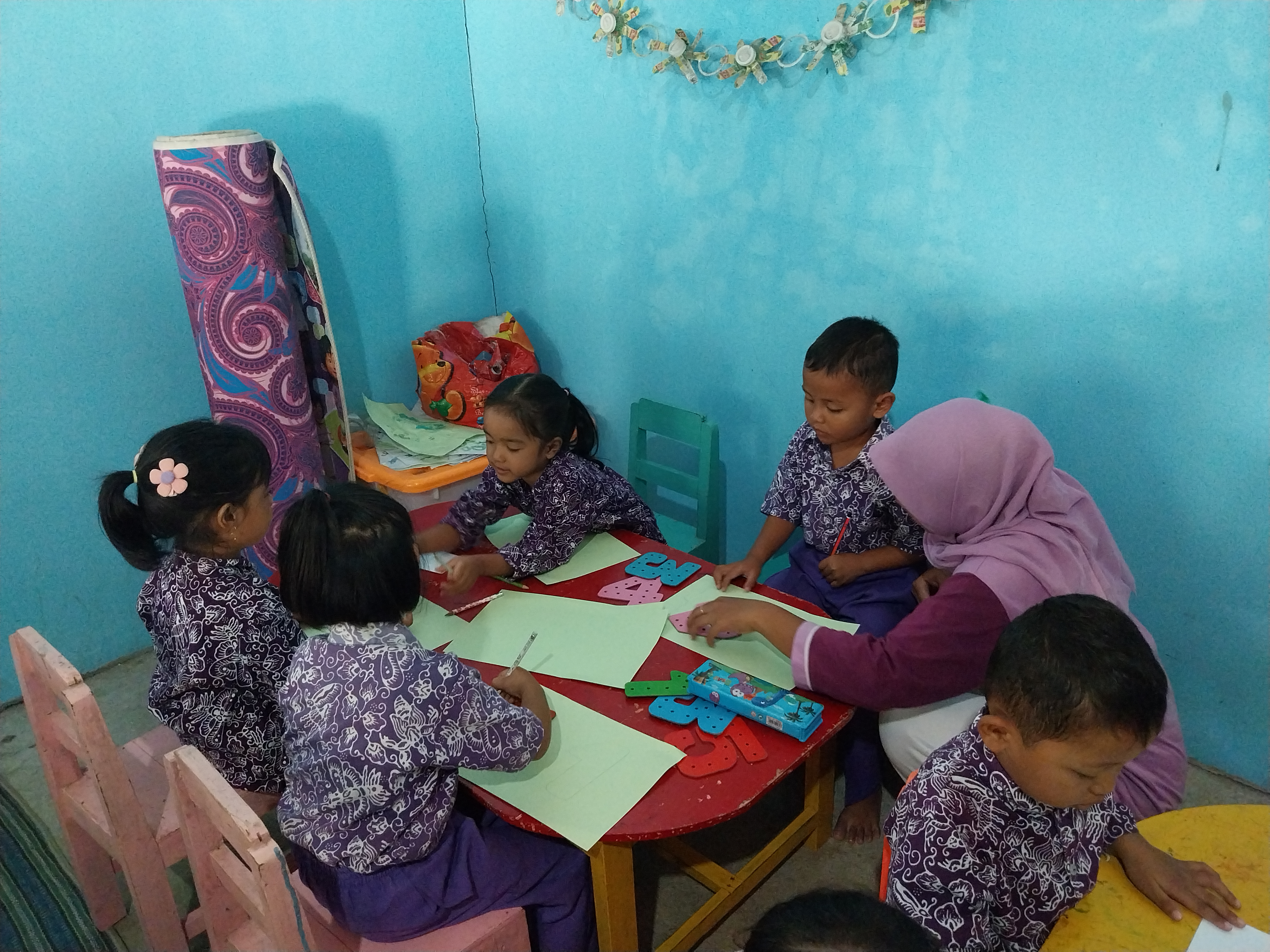
New! Learning Unlocked for inclusive preschool education
Indonesia
Learning Unlocked is our new three-year project for inclusive preschool education in central Java. For children with a disability, education at a young age is particularly important, not just for social interaction, but also for early diagnosis and supervision. Our partner organisation Pusat Rehabilitasi YAKKUM (PRY) trains parents, teachers and supervisors from seven nursery schools so that 40 children with a disability can be supervised from an early age onwards. Together with the local university, PRY has developed an inclusive curriculum. The teachers are trained in how these children can best be taught. Attention is also paid to raising awareness at local clinics and government bodies and increasing collaboration with them to ensure that the community supports this project.
We could start this project thanks to contributions from three Dutch equity funds. We are also investigating the possibility of developing this concept in several of our other project countries.

Inclusive education at 60 schools
Cambodia
With our project for inclusive education, we aim to provide equal learning opportunities for children with a visual disability at 60 primary schools in Cambodia by providing them with a qualitatively good education and better supervision. We will focus on direct care for pupils – for example, we tested the eyes of 585 pupils and gave 116 visually impaired children a pair of glasses – as well as on the training of teachers, parents and schools. Last year, 170 teachers received training about inclusive education trajectories and 24 schools received support materials, such as larger pens and exercise books with clearer lines.
We are working together with the Cambodian Ministry of Education, the National Institute for Special Education and other non-profit organisations. The government values this project and has asked our partners PAfID and Krousar Thmey to contribute to the national Cambodian policy plan for inclusion, and to help train teachers who can teach children with a disability.

Inclusive village groups work together and look out for each other
Indonesia
In Purworejo on Java, we are working on the empowerment of people with disabilities via the organisations PRY and PAfID. In 25 villages, village groups have been established in which young people, vulnerable older people and persons with disabilities take part. The activities of these cooperations include growing mushrooms, recycling paper, making brooms or producing prawn crackers that they can subsequently sell on the market or via a website built by the young participants.
Last year, 131 cooperation members participated in a training to run their group. In the village groups, which also receive practical financial support from the local government, working together and looking out for each other are important aspects. A case in point is the technical help received by persons with disabilities so that they can also participate. The feeding of chickens, for instance, takes place with a dynamo-driven device. In addition, 260 residents were trained to refer vulnerable village members to appropriate care in time, as a result of which 1730 older people and persons with disabilities gained access to the right care.
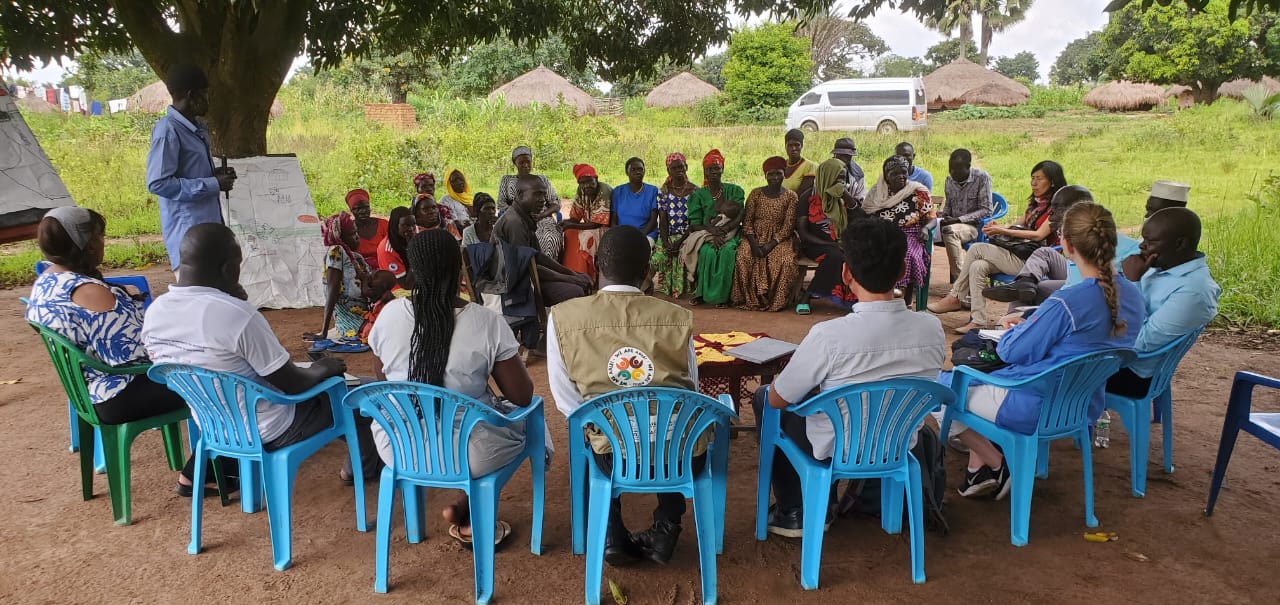
Equeal rights
2000
people with a disability were reached through new savings groups
200000
people heard about rights for people with disabilities through radio programs
776
new members joined interest groups for people with disabilities
We help and strengthen people with disabilities, and their interest groups, to stand up for their rights. And we challenge governments to work for people with disabilities.
THIS YEAR’S HIGHLIGHTED RESULTS:
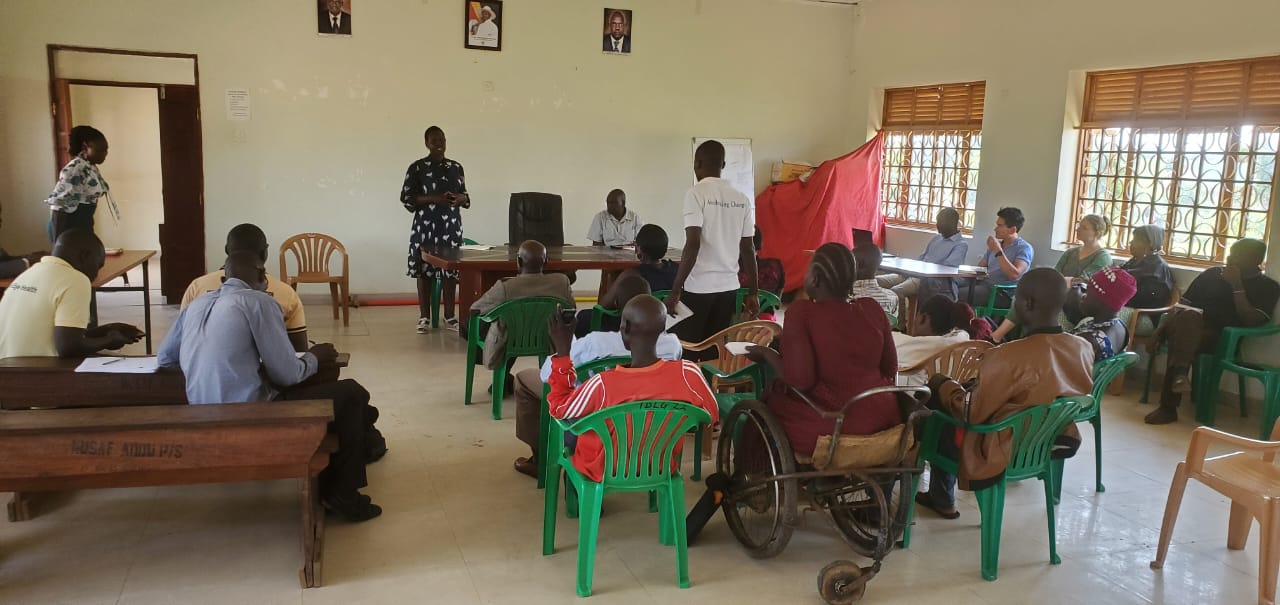
We Are Able! for inclusion and food security
Uganda, Sudan and South Sudan
In areas where considerable poverty prevails, such as in East Africa, persons with disabilities are hit particularly hard. They are often not seen in their communities and they have less access to existing food programmes. Together with the We are Able! consortium, we want to make persons with disabilities more resilient and work on food security for everybody as well.
In the first two years of We are Able!, the emphasis was on the inclusion of persons with disabilities. We have made good progress in raising awareness among local government bodies and NGOs, and in the development of advocacy organisations for persons with disabilities. This broad inclusion agenda has laid a proper foundation, and – as the interim evaluation also documented – we now need to pay more attention to food security in the second half of the programme.

Shift of power
Uganda
In Uganda, our partners Light for the World Uganda and NUDIPU took over the lobby and advocacy aspects of the work. This ‘Shift of Power’ is an important aspect and aim of the programme. Although this remains a joint programme, our partner is now in charge of this part of the project.
- In Arua City, the advocacy organisation supported 130 women with a disability who were the victim of gender-related violence. Also, 45 social workers were trained to recognise this violence and to help women to report this to the police.
- 105 new savings groups now total 2000 persons with disabilities.
- Two organisations for persons with disabilities could not find a location for their activities and were granted two hectares of land by the local government.
“My financial situation is now stable enough to enable me to meet my basic needs. I am very grateful to We are Able! Persons with disabilities – and especially widows like me – face many financial challenges and this project helps us with these.”
Jacklin (38), widow with a visual disability
Also attention for persons with disabilities, even during the war in Sudan
In April, a war broke out in Sudan, and as a result of this, large parts of the country have become unsafe. Our partner helped 100 persons with disabilities to flee the capital Khartoum. Staff members also fled to safer locations in the country. This war has many consequences for the residents and for the realisation of this project. We continually examine what can still be done for the food security of persons with disabilities in Sudan.
- Our partner organisation Action on Disability and Development (ADD) actively lobbied other organisations to include the rights of persons with disabilities in their programmes, strategies and emergency relief.
- Via radio programmes, 200,000 people have received information about disabilities and the rights of persons with disabilities.
We Are Able! is a five-year project funded by the Dutch Ministry of Foreign Affairs. In this project, we work together with five other organisations, persons with disabilities, their advocacy organisations and local governments to realise food security in Uganda, Sudan and South Sudan.
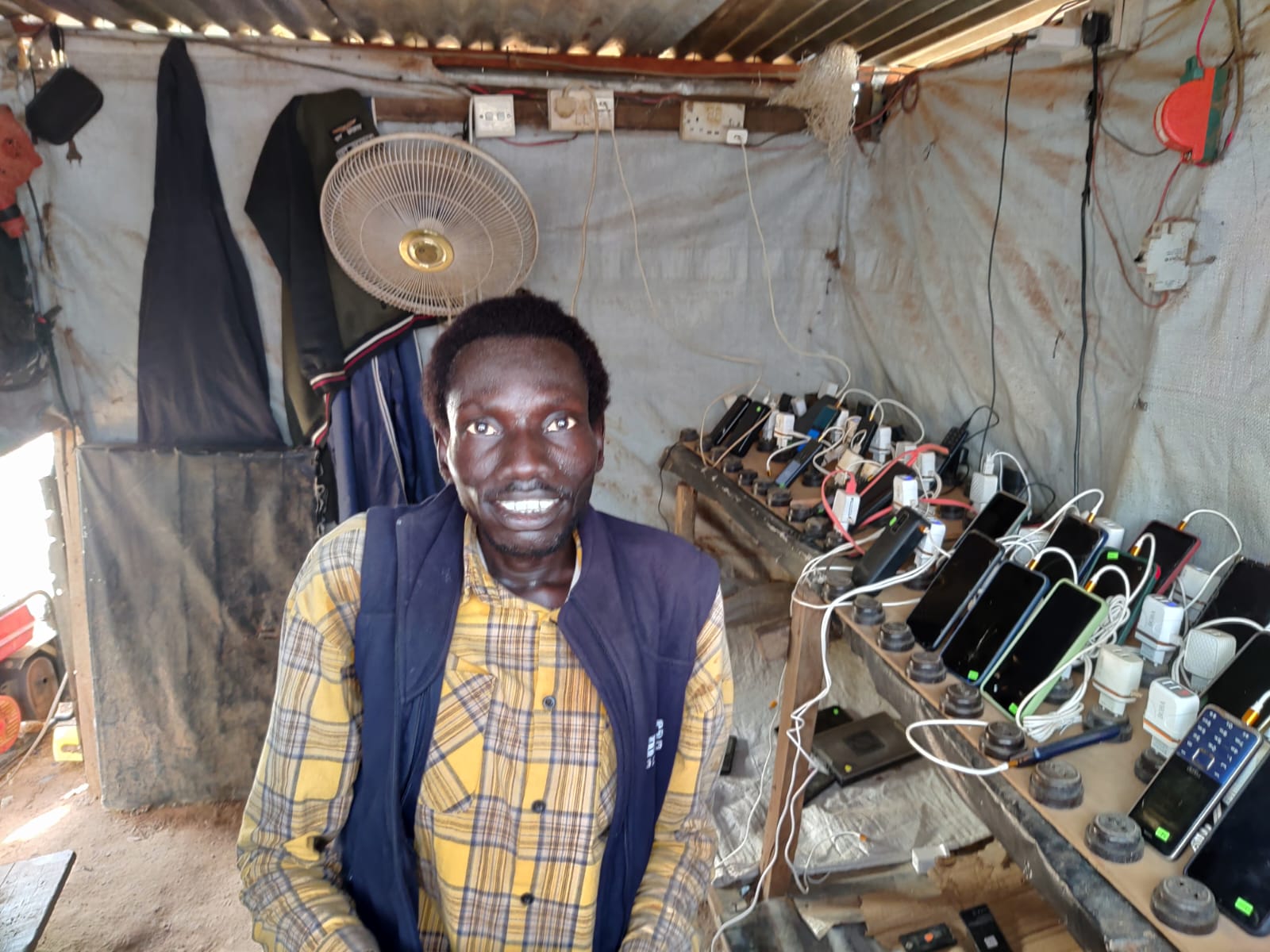
James has a shop thanks to start capital
With We are Able!, we support persons with disabilities to stand up for their rights, unite and improve their position. One such example is James in South Sudan, a young man with a physical disability. Thanks to a startup capital, he could open his own shop that provides various services. People can come to his shop to charge their phone (most houses have no electricity), purchase prepaid phone cards or make payments via their phone. James knows it is not wise to depend on a single service, so he also sells petrol for the many scooters in the area. His ambition is to expand his business to become a one-stop shop for groceries, fuel, and phone services.
We are Able! in the Netherlands
Within the WaA! programme, we work together with DCDD to advance the topic of inclusion within development cooperation. For example, DCDD organised a webinar entitled Power of Disability Inclusion, in which various Dutch and international organisations participated.

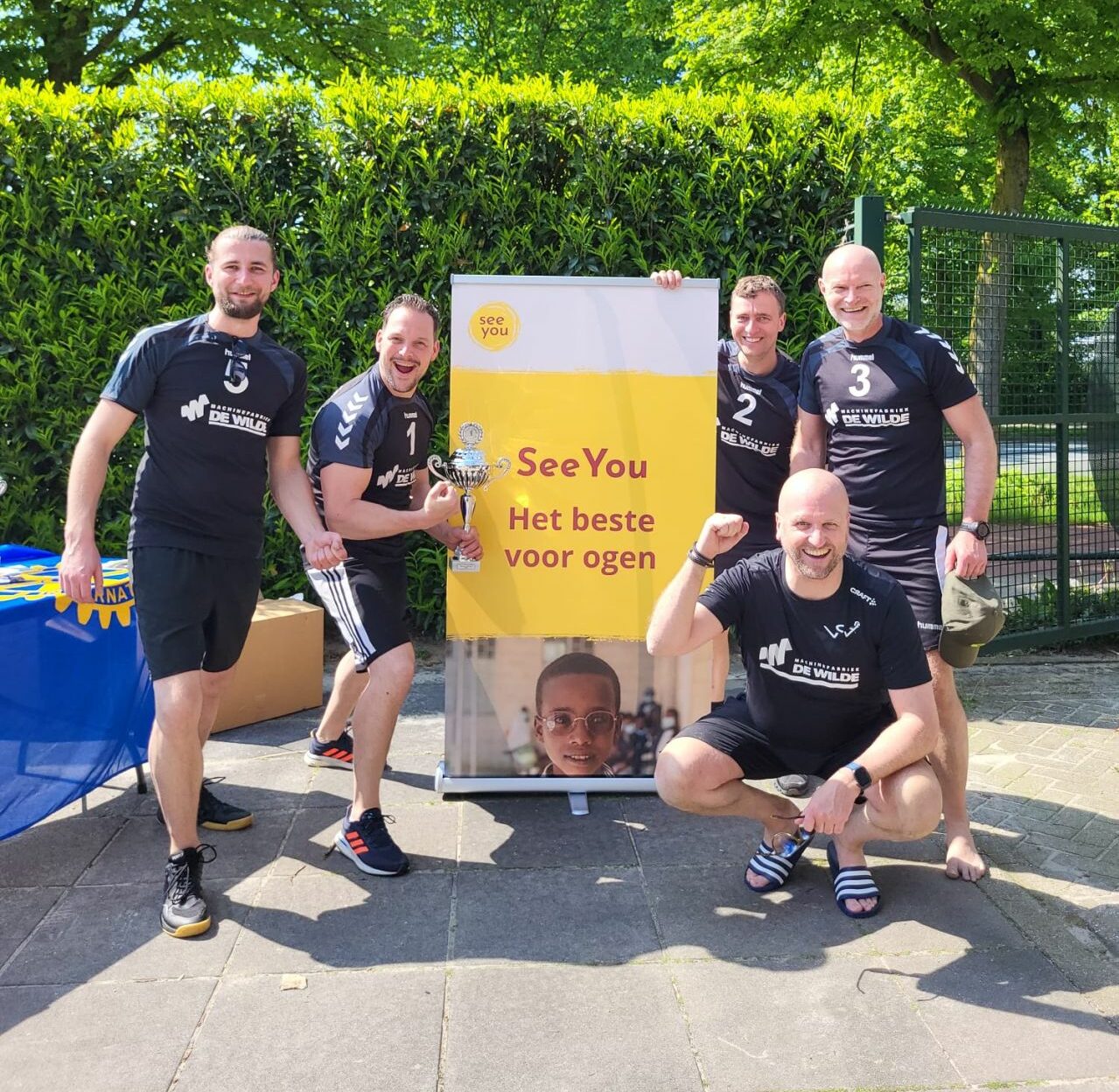
SeeYou in The Netherlands
SeeYou would like to share the story of people with disabilities in developing countries (awareness), involve others in the fight against injustice (fundraising) and encourage politicians to stand up for the rights of people with disabilities (advocacy).
HIGHLIGHTS OF OUR ANNIVERSARY YEAR:
Masterclass ‘Resilience’ for entrepreneurs
We look back at a fantastic masterclass about Resilience. More than 40 entrepreneurs were inspired by our ambassadors Jurjen van Houwelingen and Gert-Jan Segers and businessman Cees van Pelt. “It is your choice whether you focus on losses or on possibilities’, said Jurjen, who has personally experienced how life can change in a short period of time.
It was a valuable and inspiring evening at our office in Veenendaal, and it led to several more new entrepreneurs supporting our work. A new edition of the evening will be held in 2024.
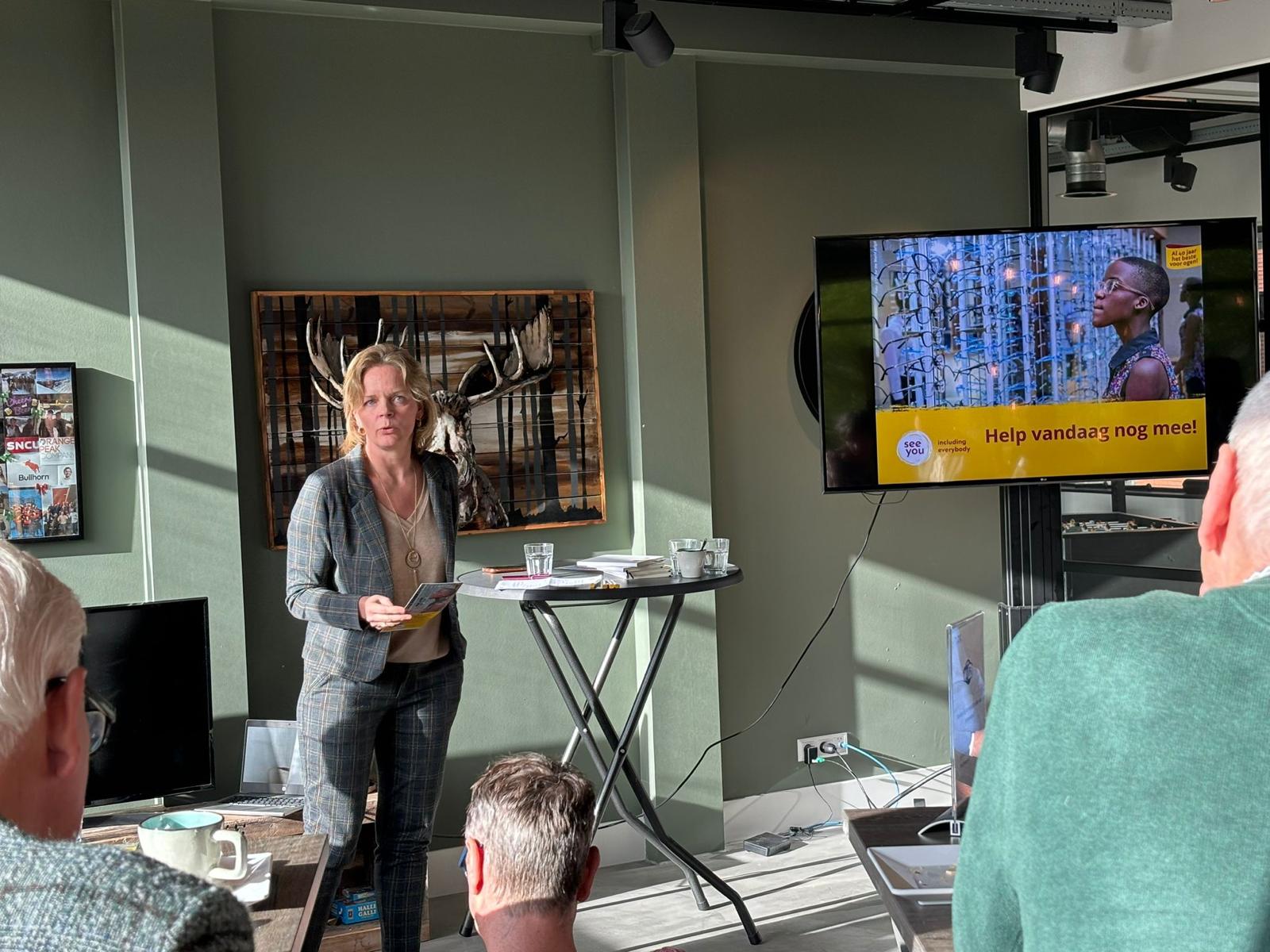
Ambassadors trip to Rwanda
Ambassadors Jurjen van Houwelingen and Gert-Jan en Rianne Segers travelled to Rwanda with SeeYou colleagues Dicky and Micha and journalist Jilke Tanis. The focus of the journey was: what can we learn from the resilience of Rwanda – a country that is scarred by the genocide of 1994 – and people with a disability, who basically face the same challenges as disabled people in the Netherlands, but in a completely different context. It was a trip full of beautiful conversations, moments of joy and heart-breaking stories. Our ambassadors are now using their experiences from this trip as an inspiration for the contributions they make at our events and in our publications and campaigns.
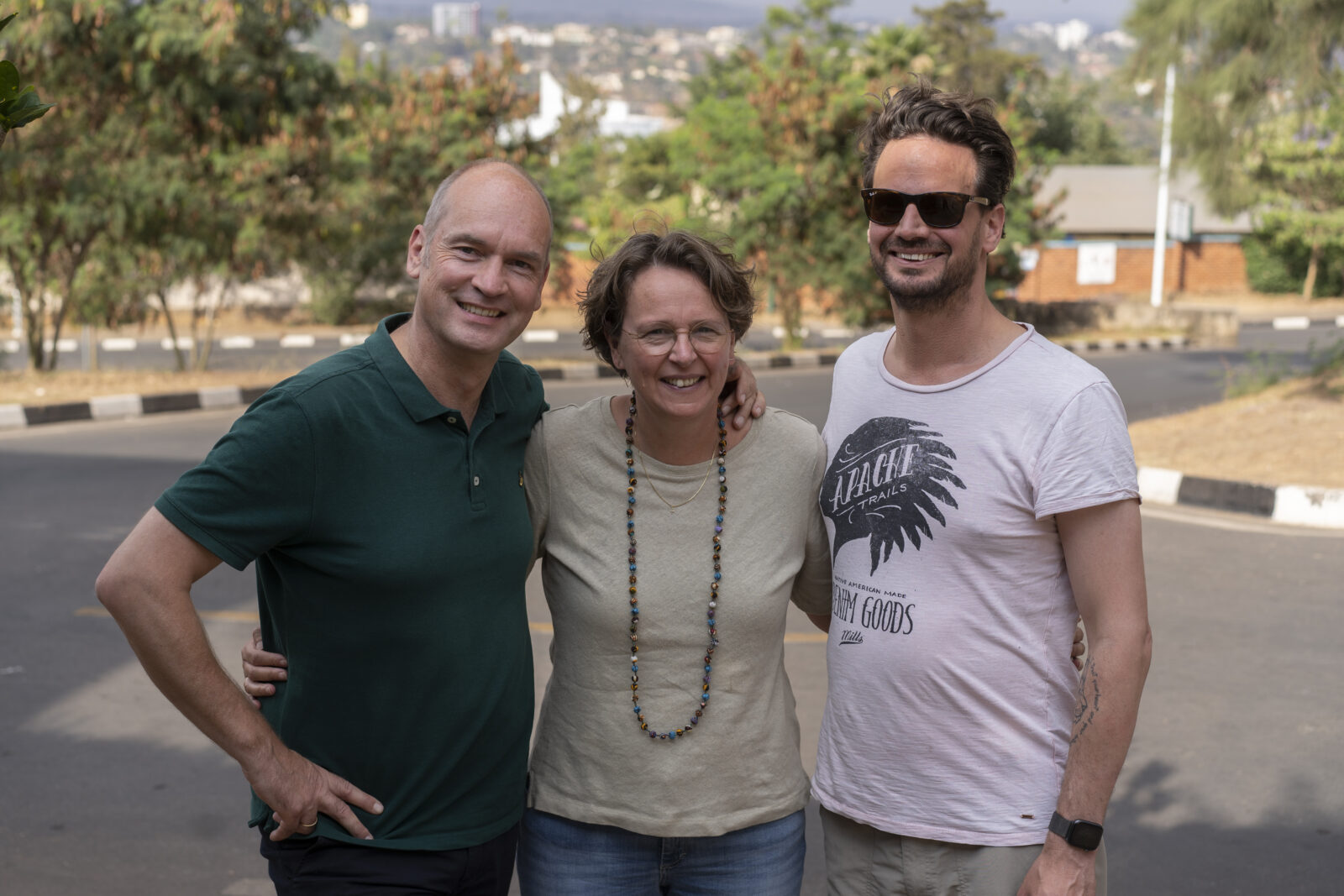
Sponsored sports events
- Seven Hills Night – Fanatic runners held a sponsor campaign during the Seven Hills Night. Ambassador Jurjen van Houwelingen and executive director Dicky Nieuwenhuis even took part in the duo run. Together, they raised almost € 6000 for our work.
- Cycling event – On Saturday, 1 July, the See You Soon team cycled from Hoek van Holland to Den Helder to collect money for our eye care project in Rwanda. On this rainy day, the 16 cyclists completed the distance of about 150 km and raised € 7,085!

Media
- Article in the Dutch newspaper Trouw calls for inclusive development aid Not even 2% of Dutch development aid includes people with a disability. That means that much of the aid fails to reach a large group of people with a visual, physical, learning or other disability. Our ambassador Gert-Jan Segers and executive director Dicky Nieuwenhuis want to change this and wrote an opinion article about the problem for the Dutch newspaper Trouw, which was even cited in the Dutch House of Representatives by the Minister for Development Cooperation.
- Interview about stigma and poverty on the Christian radio station Groot Nieuws Radio “Blind and visually impaired people are literally not seen in countries such as Rwanda”, said executive director Dicky Nieuwenhuis on Groot Nieuws Radio. On the occasion of our 40th anniversary, she was interviewed by radio presenter Ronald Koops about stigmas associated with having a disability, the deep poverty that often results from having a disability and the work that SeeYou has been doing for 40 years to prevent visual impairment and blindness.

Committed ambassadors and volunteers
Our volunteers and ambassadors were very active in 2023!
- Berdine Zwanepol started as a new ambassador. As an influencer, she, in a positive way, shares with her followers stories about life with a disability. She therefore makes a considerable contribution to our online presence.
- Volunteer Angelien became visually impaired herself a few years ago, as a result of which, she had to stop working in education. She demonstrated resilience and looked at what she could still do. Now, she translates picture books into Braille, and we could hand out 12 of these this year in our projects.
- Gert-Jan Segers devoted attention to SeeYou at his farewell party as leader of the ChristenUnie political party and requested people to make a donation to our charity.
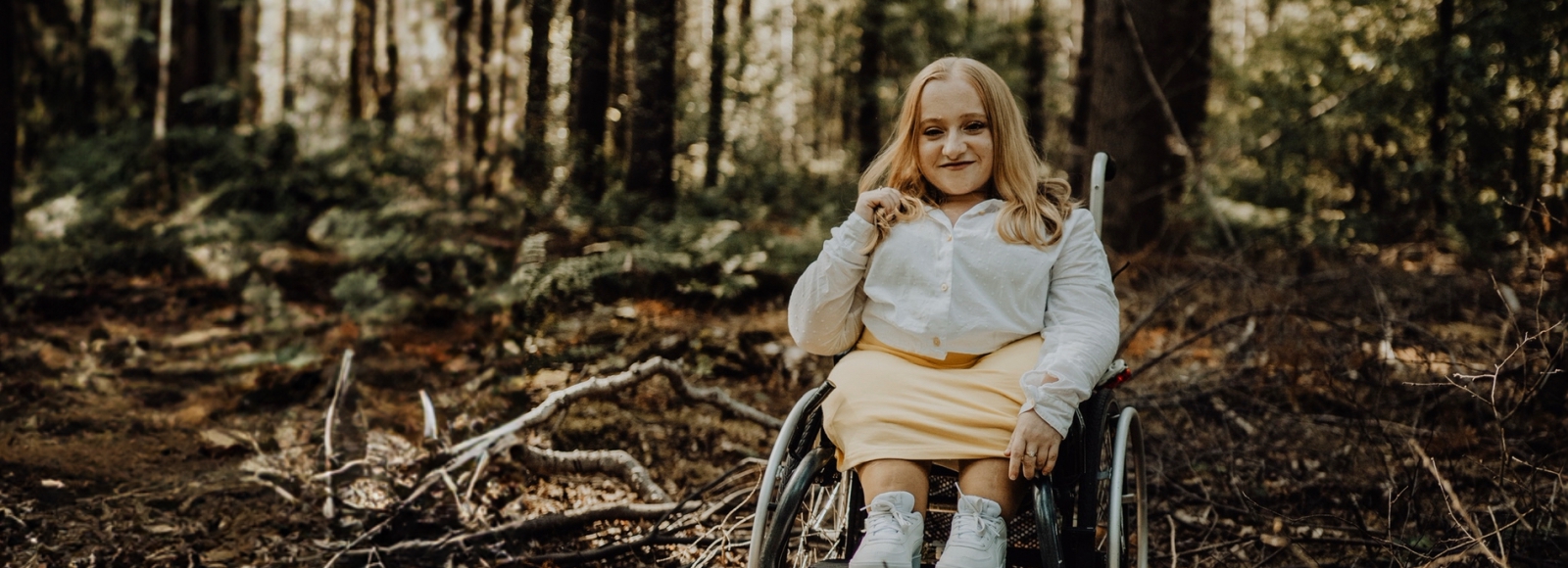
Masterclass ‘Resilience’ for entrepreneurs
We look back at a fantastic masterclass about Resilience. More than 40 entrepreneurs were inspired by our ambassadors Jurjen van Houwelingen and Gert-Jan Segers and businessman Cees van Pelt. “It is your choice whether you focus on losses or on possibilities’, said Jurjen, who has personally experienced how life can change in a short period of time.
It was a valuable and inspiring evening at our office in Veenendaal, and it led to several more new entrepreneurs supporting our work. A new edition of the evening will be held in 2024.

Media
- Article in the Dutch newspaper Trouw calls for inclusive development aid Not even 2% of Dutch development aid includes people with a disability. That means that much of the aid fails to reach a large group of people with a visual, physical, learning or other disability. Our ambassador Gert-Jan Segers and executive director Dicky Nieuwenhuis want to change this and wrote an opinion article about the problem for the Dutch newspaper Trouw, which was even cited in the Dutch House of Representatives by the Minister for Development Cooperation.
- Interview about stigma and poverty on the Christian radio station Groot Nieuws Radio “Blind and visually impaired people are literally not seen in countries such as Rwanda”, said executive director Dicky Nieuwenhuis on Groot Nieuws Radio. On the occasion of our 40th anniversary, she was interviewed by radio presenter Ronald Koops about stigmas associated with having a disability, the deep poverty that often results from having a disability and the work that SeeYou has been doing for 40 years to prevent visual impairment and blindness.

Ambassadors trip to Rwanda
Ambassadors Jurjen van Houwelingen and Gert-Jan en Rianne Segers travelled to Rwanda with SeeYou colleagues Dicky and Micha and journalist Jilke Tanis. The focus of the journey was: what can we learn from the resilience of Rwanda – a country that is scarred by the genocide of 1994 – and people with a disability, who basically face the same challenges as disabled people in the Netherlands, but in a completely different context. It was a trip full of beautiful conversations, moments of joy and heart-breaking stories. Our ambassadors are now using their experiences from this trip as an inspiration for the contributions they make at our events and in our publications and campaigns.

Committed ambassadors and volunteers
Our volunteers and ambassadors were very active in 2023!
- Berdine Zwanepol started as a new ambassador. As an influencer, she, in a positive way, shares with her followers stories about life with a disability. She therefore makes a considerable contribution to our online presence.
- Volunteer Angelien became visually impaired herself a few years ago, as a result of which, she had to stop working in education. She demonstrated resilience and looked at what she could still do. Now, she translates picture books into Braille, and we could hand out 12 of these this year in our projects.
- Gert-Jan Segers devoted attention to SeeYou at his farewell party as leader of the ChristenUnie political party and requested people to make a donation to our charity.

Sponsored sports events
- Seven Hills Night – Fanatic runners held a sponsor campaign during the Seven Hills Night. Ambassador Jurjen van Houwelingen and executive director Dicky Nieuwenhuis even took part in the duo run. Together, they raised almost € 6000 for our work.
- Cycling event – On Saturday, 1 July, the See You Soon team cycled from Hoek van Holland to Den Helder to collect money for our eye care project in Rwanda. On this rainy day, the 16 cyclists completed the distance of about 150 km and raised € 7,085!

“I convert every amount I raised into the number of cataract operations it can finance”
“With some breaks, I have been a SeeYou volunteer since 2004. My daughter died in that year, and following her death, I wanted to use my experience for a good cause. During 18 years of illness, my daughter could physically do less and less. However, I only saw tears in her eyes for the first time when she lost her sight. If, through my work for SeeYou, I can contribute to a child somewhere in the world not becoming blind, I know that my daughter would be pleased with me.
As a volunteer, I do many things, from selling stuff on a market to organising singing days and conducting choirs. Singing is one of my hobbies – a hobby which many blind people also enjoy – and I’ve been a conductor since the age of 25. I do not need to receive any money for conducting but if I receive a remuneration, I donate it to SeeYou. I convert every amount I raise into the number of cataract operations it can finance. Over the years, that has added to many operations!”
Nellie de Visser, volunteer at SeeYou

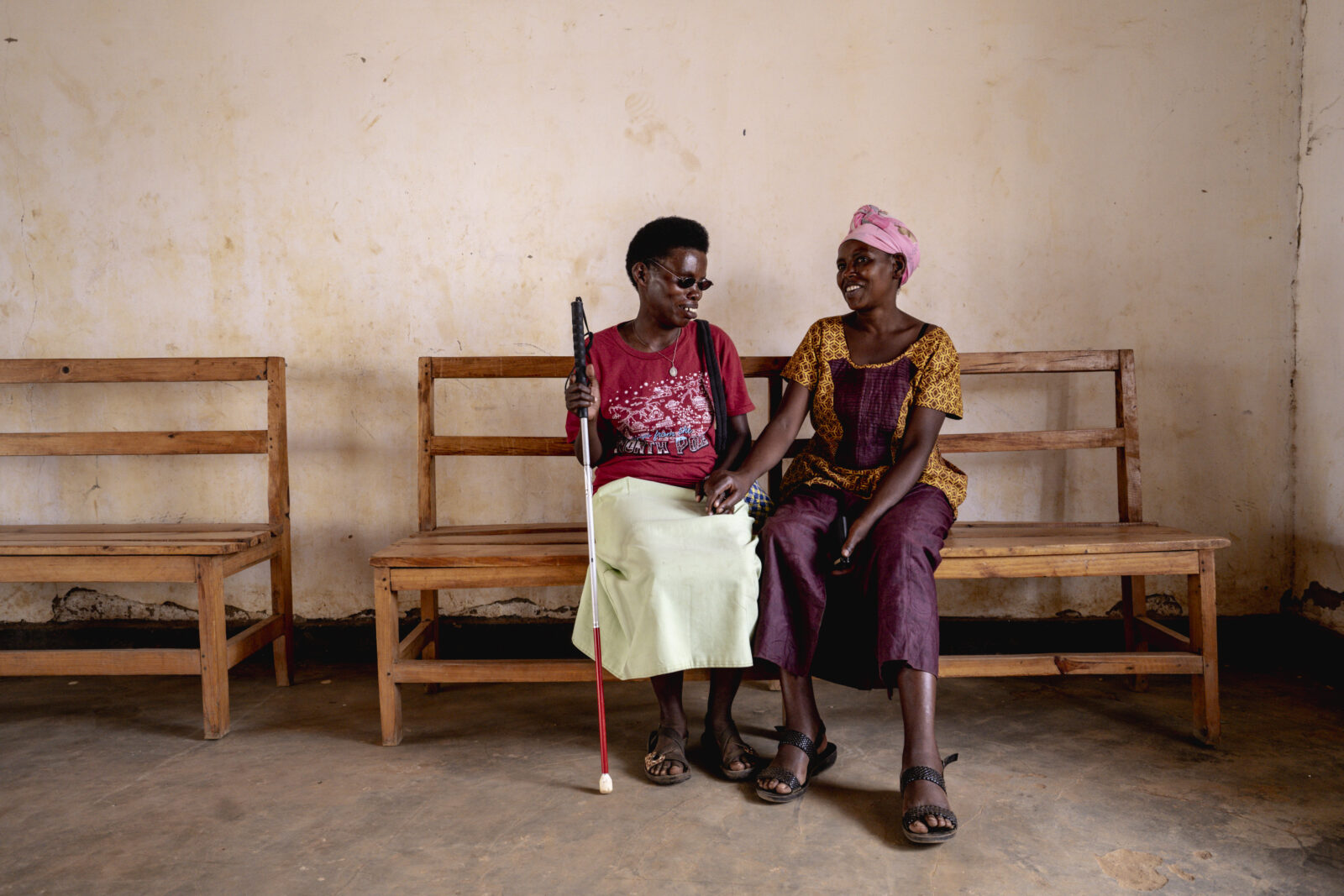
Collaboration
Together we achieve more
For all of our projects, we enter into partnerships with local organisations. We can achieve more impact together through equality, appreciation for each other’s work and sharing knowledge and expertise. Our partners know the situation, community and culture and have the required specific expertise about (eye) care, education or work. Depending on the project, we also work together with local schools, churches or companies.
In our projects, we believe it is important to increasingly bring together our three themes: inclusive eye care, access to care, education and employment, and equal rights. That requires mutual collaboration from the different local partners, each of whom contributes with their own knowledge and expertise. For example, in the new MUB project in Rwanda, we work together with various advocacy organisations towards better incomes and health for persons with disabilities.
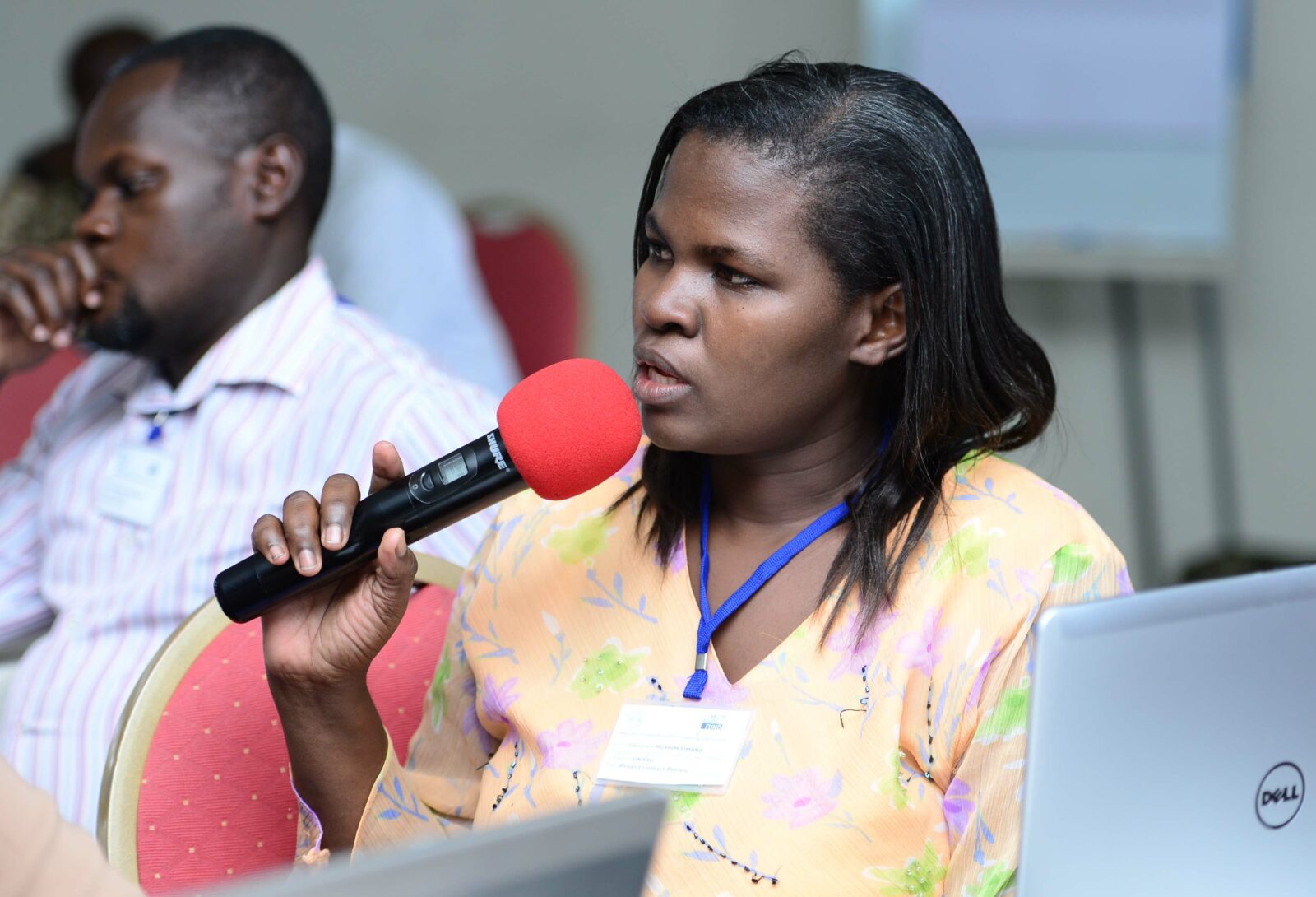
“Our partnership with SeeYou involved far more than receiving funding. We could share challenges and spar with each other about our approach, as a result of which this collaboration really motivated our team. We are very pleased with the trust that SeeYou has placed in us. Please continue with your work for a more inclusive world because it changes the lives of the most marginalised and underprivileged people.”
Gaudence Mushimiyimana, co-founder and director of Umuryango Nyarwanda w’Abagore Bafite Ubumuga (UNABU), which in English means the Rwandan Organisation for Women with a Disability.
Connecting organisations creates more impact
We connect knowledge and expertise from Dutch organisations with that of our partners in project countries, for example, in our collaboration with the Dutch charity organisations ZOA and Woord en Daad. We also strengthen the collaboration with organisations that provide specific expertise in the area of (visual) disabilities, such as Bartiméus Fund, Leprosy Mission Netherlands and CBM Global.
For example, in the past year, a pilot project started in which we link the expertise of Bartiméus (a Dutch care organisation for people with a visual disability) about digital accessibility with our partners in Ethiopia who work on inclusive education. We want to further develop and promote cooperations like these to achieve greater impact in our projects.
Partners jointly develop new project phase
At the end of October, our partners UPHLS from Rwanda and ECDD from Ethiopia visited our office in Veenendaal. Together, we developed the next project phase of Every Life Matters and, in the end, the partners presented this phase to the SeeYou team.
We discussed recommendations from the evaluation, examined which of these were feasible and held sessions about our SeeYou policy and strategy. And Dr Wim van Brakel, medical director of Leprosy Mission Netherlands, gave a training session about stigma; how does this affect persons with disabilities and how can we reduce that? Because we aim to establish a stigma-free environment in which persons with disabilities, and especially women and children, can access health centres when they need to and without any fear. The focus required to realise this differs somewhat between countries. In Rwanda, for instance, we will focus more on mother and child care, in Ethiopia, on sexual health and the care for women who became a victim of (sexual) violence, and in Indonesia, we will focus on people with mental health issues.
New collaboration with CBM Global
In 2023, we signed an agreement with CBM Global, an international organisation which, just like SeeYou, campaigns for access to eye care and for the inclusion of persons with disabilities. CBM Global possesses a lot of valuable expertise that SeeYou can use to improve the quality of its work, such as the evaluation of our eye care programme. In addition, we have taken initial steps to realise joint fundraising.
“I’m very enthusiastic about this collaboration with SeeYou. We have the same values and a shared commitment to support advocacy organisations and, in doing this, contribute to the Shift of Power. I look forward to all the possibilities that our new collaboration offers.”
David Bainbridge, Directeur CBM Global Disability Inclusion
Networking
We share our knowledge with various organisations and continue to learn about inclusion, eyecare, operations and fundraising. We do that within various networks and sector organisations. We consciously choose a limited number of networks and platforms in which we participate in a meaningful and committed manner.
Partos
Sector association that brings together more than 100 Dutch organisations for development cooperation and humanitarian relief.
Prisma
Association that focuses on the role of Christian organisations in international development cooperation.
Dutch Coalition on Disability and Development (DCDD)
The most important Dutch network for inclusion and representing the interests of persons with disabilities in developing countries. We create a strong lobby towards the Dutch government through a joint agenda with other participants.
EU-Cord
European network that focuses on collaboration and influencing policy in international development collaboration. As part of this network, we specifically focus on lobbying, advocacy, and institutional fundraising.
International Disability and Development Consortium (IDDC)
International platform for stakeholders in the area of disability and inclusion. Thanks to our membership, we are even better informed about international developments in inclusion.


Our organisation
Internal developments
Last year, we took great steps to organise our teams differently within our organisation. In the past, the support of our partners by the programme team was realised separately from the fundraising and finances for these projects, but now we will work in multidisciplinary teams. We have already been doing this for the We are Able! programme since 2021 and have had positive experiences with that. Colleagues with substantive expertise and the people concerned with fundraising for and financial control of our five core programmes will be brought together in teams. That will enable us to work more efficiently and will strengthen how we support our partners and interact with our donors.
Our team
In 2023, our team numbered an average of 12.75 FTE made up of 21 paid employees. We temporarily supplemented our team with five independent professionals because of (long-term) sick leave and the very tight labour market, which hampered our efforts to fill vacancies for the team fundraising and communication. In addition, like every year, we were supported by enthusiastic volunteers and interns.
The absence due to illness rate of 21.23% consisted largely of long-term and extra long-term absence due to illness. Over the year, we had to say farewell to three colleagues with long-term health conditions; therefore, this percentage dropped considerably by the end of the year. Now, it looks like a prolonged period of high absence due to illness – mainly related to COVID – is behind us.
In 2023, our employee representation met with the director on four occasions. These meetings were concerned, amongst other things, with the design and outcome of the employee satisfaction survey, the year plan and the budget. The annual employee satisfaction survey revealed an upward trend, just as in the previous three years. For nearly all areas, employees gave the score ‘satisfied’ to ‘very satisfied’. The outcome of the survey was managed by the employee representation and discussed with the entire team.
With our team, we visited MuZIEum in Nijmegen. This is a museum where you can experience what it is like to be blind or visually impaired. It was a pleasant but intense and educational experience because we could briefly imagine what life is like for people with a visual disability.
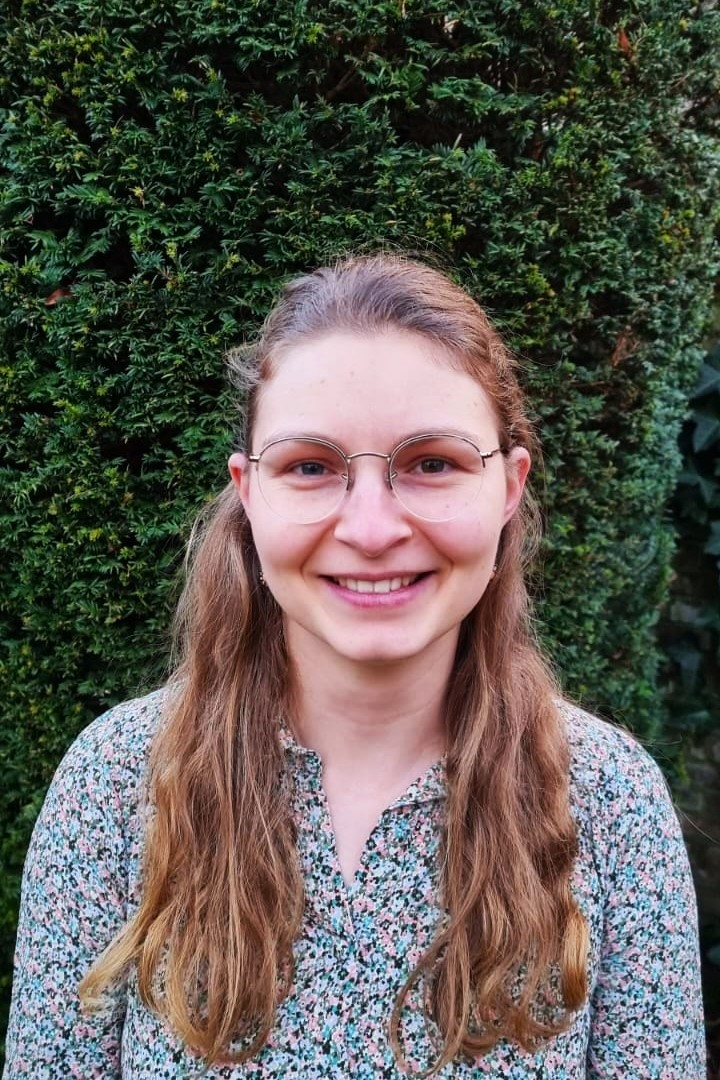
“SeeYou focus on inclusion instantly appealed to me”
“As a child, I lived in Sri Lanka and Cambodia. There, I was confronted by the inequality around me on a daily basis. I felt moved by it then and still feel moved by it now. It breaks my heart when I see a child begging on the street. I think it is vital to care for people who fall by the wayside, and that is why the SeeYou focus on inclusion instantly appealed to me. I think it is fantastic that SeeYou helps people with simple things we take for granted in the Netherlands, such as a pair of glasses, an eye operation or medicines. SeeYou projects give people a better future, more self-esteem and greater independence. I saw that in Uganda at one of the self-help groups of the We are Able! programme. Women who save together to invest in agricultural equipment. That sounds simple, but it changes their lives!”
Julia Jaspers Faijen started to work as a project assistant at SeeYou in 2023. It was a year during which she visited a project in Uganda, enjoyed contact with our partners from project countries and, as she puts it, learned an awful lot.
Quality
Thanks to previous investments in improving work processes and management information, we now have a good grip on the progress of both the financial and substantive results. In 2023, we evaluated several multiannual projects such as EmployAble and Every Life Matters.
Survey among donors and partners
The Dutch research organisation Christelijk Charitatief Peil (CCP) conducted a survey into the giving behaviour of Christians and the name recognition of charities. Although this survey established that our name recognition has decreased, we were nevertheless rated with a score of 8.3, the highest score of all participating organisations. People who know us describe us as ‘connecting’ and ‘effective’. At the end of 2023, we also carried out a survey amongst our supporters, but the results are not yet known.
Collaboration is always one of the subjects discussed during project visits. We paid extra attention to this last year by discussing with our partners the outcomes of a 2022 online questionnaire about collaboration. During these discussions, our partners indicated that they are positive about the supervision provided when realising projects. For example, we advised the partner UPHLS about the development of their multiannual strategy, we applied the Shift of Power in the We are Able! programme, and we strengthened the leadership of our partners in a new MUB project.
Quality management
A quality management system has been set up according to the ISO 9001 principles and the sector-specific ISO standard Partos 9001. The ISO/Partos certificate was extended for a period of three years in 2021. The external progress audit was positive in 2023. It just provided a few points for attention, which means that everything is shipshape.
Three quality marks
Thanks to quality marks and certifications, our donors can be sure that we contribute to a better world, manage every euro carefully, are accountable and have ourselves audited independently.
- Recognised as a charity by the Dutch Fundraising Regulator (CBF)
As a CBF-recognised charity, we meet the strict quality requirements that the CBF audits. This quality mark was extended for a period of three years in 2022.
- Public Benefit Organisation (Dutch abbreviation ANBI)
SeeYou has been classified as a Public Benefit Organisation by the Dutch Tax and Customs Administration. As a result, donations to the charity are deductible for persons paying Dutch income tax.
- ISO 9001 and Partos 9001
Our charity is ISO 9001 and Partos 9001 certified. This certification concerns internal and external processes, which are regularly assessed and adjusted.
Complaints
We registered three complaints in 2023. One complaint concerned the size of the payment for cataract operations, which we could explain on the basis of our policy. A strategic collaborative partner in the Netherlands informed us that the collaboration yielded insufficient results. We discussed the situation with each other, expressed our mutual expectations and adjusted these to a realistic level. Finally, there was a complaint from local partner organisations who did not feel properly heard within the consortium. As consortium partners, we dealt with this jointly and initiated a complaints procedure, which started with listening to the local partners. This procedure has not yet been completed due to the civil war that broke out shortly after the process started.
“It is fantastic that SeeYou connects with a group of people who, for no reason, are not seen as full members of society, and that SeeYou makes such a difference with pure motives and so few resources!”
One of our SeeYou donors
Integrity
Integrity is high on our agenda. We know from experience – and from countless studies – that persons with disabilities face a considerably higher risk of being abused. Safety, an open learning culture and a strong integrity policy are vital for preventing such abuse.
As we collaborate directly with local partner organisations in Africa and Asia, we must also ensure that our partners have a good integrity policy and safeguard the people we support with our work. In our integrity policy, we have laid down the distinction between our direct and indirect responsibility towards stakeholders and our target group, and the ethical conduct that we expect from ourselves and our partner.
The content of our integrity policy:
- statement of integrity
- code of conduct
- prevention policy
- reporting system
- references to underlying provisions: Transparency & Anti-Corruption Policy, Regulations for Confidential Advisers, Whistleblower Policy, and Complaints Procedure
Learning about ethical behaviour within the SeeYou team and with our partners
As part of our preventative measures, we continuously hold internal discussions concerning the importance of ethical behaviour and concrete moral dilemmas. So, in 2023, we also discussed several cases that we could learn from as a team.
Partner organisations must demonstrate that they pursue an active integrity policy and underwrite the basic principles with respect to integrity in contracts. The subject of integrity is always on the agenda during the various contact moments with partner organisations and during work visits. We ask our partner organisations about their integrity (also called safeguarding policy), how they implement this, and the issues they come up against. In the collaboration with our partners, we discuss how attention is paid to integrity in practice. We ask whether employees have received training and whether the target groups know how to report incidents. During our project visits and discussions, we noted that partners informed us about behaviour that is and is not desirable.
Code of conduct
All of our employees and volunteers have signed a code of conduct. This is based on our core values – every person is valuable, there is room for everyone, Christian charity, and justice – and forms the basis for all of our actions. We also endorse the 2019 Partos Code of Conduct with guidelines on cooperation with civil society organisations in project countries, setting up a professional organisation, and agreements on communication and fundraising.
We fully realise that we always work with financial resources entrusted to us by others, such as donors, financers and foundations. We therefore follow the guidelines expressed in our Transparency & Anti-Corruption Policy to minimise the risk of these resources being misused.
Corporate Social Responsibility (CSR)
Our new CSR policy statement is based on three principles:
- Working fairly and honestly
The previous sections on Quality and Integrity describe how we shape this.
- Respect for our stakeholders, work and organisation
In addition to regular satisfaction surveys, the various stakeholders are annually consulted on strategic decisions. These include volunteers, ambassadors, family of the founders, committed donors, representatives of equity funds, and strategic partners in our project countries and the Netherlands.
- Respect for the environment and society
We are committed to protecting the environment and we want to conserve natural resources. That is why we choose to pay CO2 compensation for our air travel by making a donation to the A Rocha foundation via the ‘Climate Stewards’ programme. Working from home has now become an integral part of our work. Our starting point is that employees work at the office 50% of the time and 50% from home. Also, our office building is closed one day per week, and we heat our office in a climate-aware manner. In this way, we use less energy at our office and we reduce CO2 emissions due to commuting.
Risk management
Our work often involves risks and uncertainties. Through our risk management, we prevent risks from becoming a reality and limit any potential impact they may have. We work on structured risk management with a quarterly risk analysis by the management team, and a sound policy on project expenditure, reporting, monitoring and integrity.
We see five main potential risks for the next five years.
1. Uncertain external conditions as a result of conflicts and political unrest
Probability: high
Potential impact: high
As SeeYou, we work in various countries where the political environment is fragile and conflicts can suddenly flare up. For example, a civil war erupted in Sudan in 2023, which had direct consequences for local partners and for carrying out the programme. Persons with disabilities are always hardest hit during war and conflict situations because care, education and work become even less accessible for them.
Our measures:
- continue to invest in projects that promote economic independence and food security;
- ask governments to make (emergency) aid inclusive for persons with disabilities;
- realise extra emergency response campaigns where necessary.
2. Rising costs as a result of inflation
Probability: high
Potential impact: high
Costs are rising both internationally and in the Netherlands. This affects the realisation of our projects as well as our activities in the Netherlands: we can do less against the same costs.
Our measures:
- look even more critically than before at what is really needed with respect to our organisation costs, such as limiting the use of independent professionals and reducing the size of our organisation insofar as this is possible;
- discuss with partners in the project countries the priorities in realising projects;
- investigate possibilities to reduce costs by working together with other organisations.
3. Limited team capacity
Probability: high
Potential impact: high
Due to shortages on the Dutch labour market, it has become increasingly difficult to find qualified staff. The consequences of COVID-19 – such as long COVID – can give rise to relatively long periods of absence due to illness.
Our measures:
- organise the work as effectively as possible in multidisciplinary teams;
- pay attention to preventing absence due to illness and provide good supervision for colleagues who are on sick leave;
- pay continual attention to an attractive work environment and work satisfaction.
4. Loss of income
Probability: medium
Potential impact: high
The current inflation, rising energy costs, and uncertainty around the world are causing our donors to become more cautious.
Our measures:
- closely monitor income developments and invest in attracting new donors;
- focus relations management on target groups with which we have a strong connection;
- make clear choices in what we do and do not do and, where necessary, change course, such as the adjusted focus on fundraising;
- only award expenditure if the income is guaranteed.
5. Integrity violations and fraud
Probability: medium
Potential impact: high
In a time when (sexually) undesirable behaviour makes the news headlines, we are aware that this risk is present in all companies and organisations and that our target group is particularly vulnerable. Possible violations of integrity not only result in a considerable loss of reputation but, more importantly, in permanent damage to somebody’s life.
Our measures:
- a strong integrity policy;
- continue internal discussions about integrity within our organisation and partner organisations;
- internal processes aimed at preventing fraud are monitored both internally and externally.

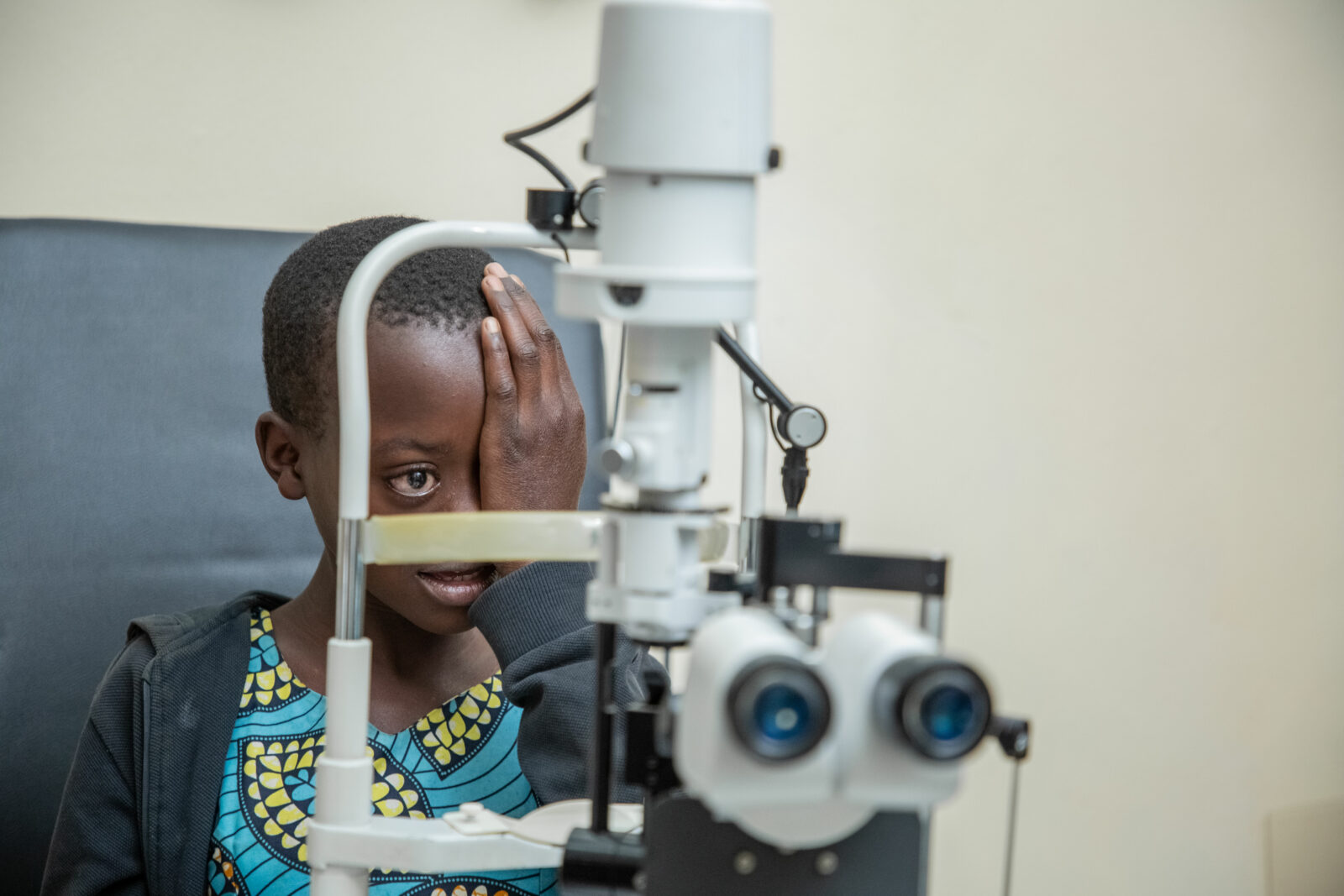
Board and supervision
Change of governance model
In 2023, we changed our model for governance and supervision. In the last board meeting of 2023 – held on 13 December 2023 – the board made the switch to a supervisory board and transferred its governance task to the executive director. All new roles and responsibilities have been recorded in the statutes and in a new regulation concerning the governance and the supervisory board. With this step, we align ourselves better with the supervisory model, which is standard practice in the charitable sector.
Remuneration executive director
The supervisory board has determined the remuneration policy, the level of the remuneration of the executive director and the size of other remuneration components. This policy is updated regularly. For this, we follow the Dutch regulation for salaries for directors of charitable organisations as drawn up by the sector organisation Goede Doelen Nederland. The supervisory board awarded our executive director Dicky Nieuwenhuis a so-called BSD score of 380 points with a maximum annual income of € 120,741. Her actual annual income, including holiday pay, year-end bonus and pension contribution was € 108,795 in 2023.
As a result, the annual income, the taxed allowances and additions, the employer’s pension contribution and, in the long term, the other remunerations remained well within the maximum norm stated in the above-mentioned regulation. In the annual accounts under ‘Explanation stated income and expenses’, the size and composition of the remuneration are explained in greater detail.
Our supervisory board
The supervisory board safeguards the mission and identity of our organisation. It also supervises the executive director and the SeeYou policy and plans. Members of the supervisory board receive no financial remuneration for their work. They can, however, declare costs they have incurred to carry out their work as a supervisory board member.
Members of the supervisory board
| Naam & functie | (Neven)functies | Lid sinds | Herbenoembaar | Aftredend |
|---|---|---|---|---|
| Sander van Bellen, chair | Chief Financial and Risk Officer at insurance compnay a.s.r., unit income | 2018 | n.a. | 2026 |
| Erik Werkman, vice-chair | Coach, trusted advisor | 2021 | 2025-2027 | 2029 |
| Annet Lukkien, member | Manager Partnerships Dorcas, Consultant Inclusion Matters | 2018 | n.a. | 2026 |
| Job de Wit, member | Team leader at law firm ARAG, unit Real Estate | 2019 | 2023-2025 | 2027 |
| Marlies van der Kroft, member | Disability and Development Consultant | 2022 | 2026-2028 | 2030 |
After six years of being a board member, Stephan Bol stepped down in December 2023. We are grateful for his work over the past years. The vacancy will not be filled because the new supervisory board considers its current composition appropriate for the organisation’s new structure.
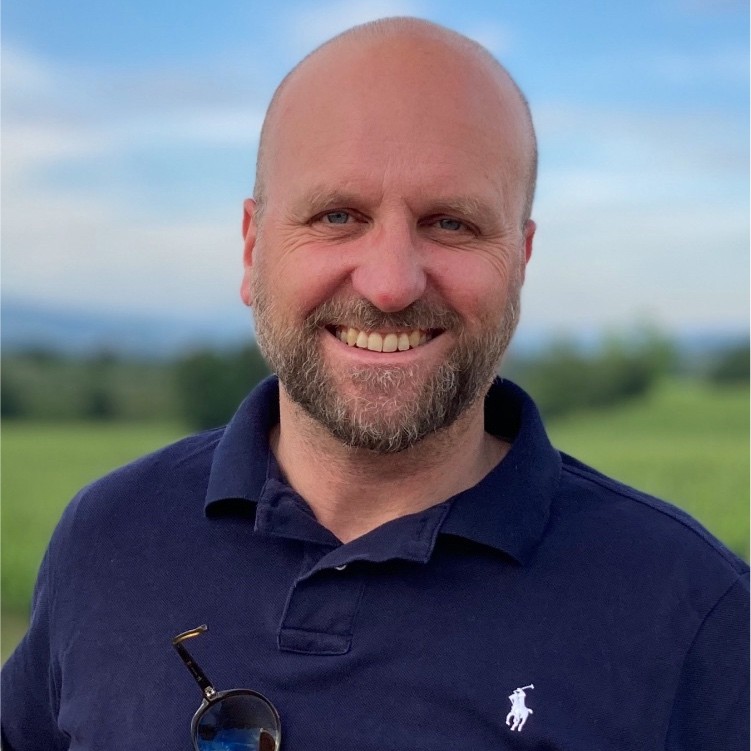
‘The projects have a genuine impact on people’s lives’
“As a result of my involvement with SeeYou, I discovered that the most vulnerable people need the most support. SeeYou makes this happen: their projects genuinely impact people’s lives. And they manage to do so through equal cooperation with partner organisations in the project countries. I really like making a small contribution to that.
Last year our board was formally changed into a supervisory board but the work we do remains the same. We supervise and provide both solicited and unsolicited advice. For example, Dicky and I meet every month to brainstorm about strategic cooperation with partners, the personnel and financial developments as well as the important milestones within programmes.
Looking ahead, I do see challenges due to the rate of inflation, but I also foresee many opportunities to collaborate. I believe, for instance, that we could turn every donated euro into ten euros if we work together more with equity funds and the government. And I see a lot of potential in collaborating with other Dutch Christian organisations because we can achieve even more together.”
Sander van Bellen, Chair Supervisory Board
Meetings and decision-making in 2023
The supervisory board met on five occasions in 2023. This concerned four regular meetings and one strategic session about the impact of our programmes and strategic collaboration with other humanitarian organisations.
The following decisions were taken:
- approval of the annual report and financial statements 2022;
- approval of the year plan and budget 2024;
- approval of the new statutes and regulations concerning the governance and supervisory board of SeeYou.
Evaluation of the supervisory board’s functioning
The supervisory board evaluates its own functioning every year. In 2023, the supervisory board members concluded that the task allocation between the governance and supervision functioned well. It was also noted that to properly carry out the supervisory role, more insight into strategic choices regarding fundraising and programmes is required. In addition, progress in searching for a collaborative partner for SeeYou in the long term has priority.

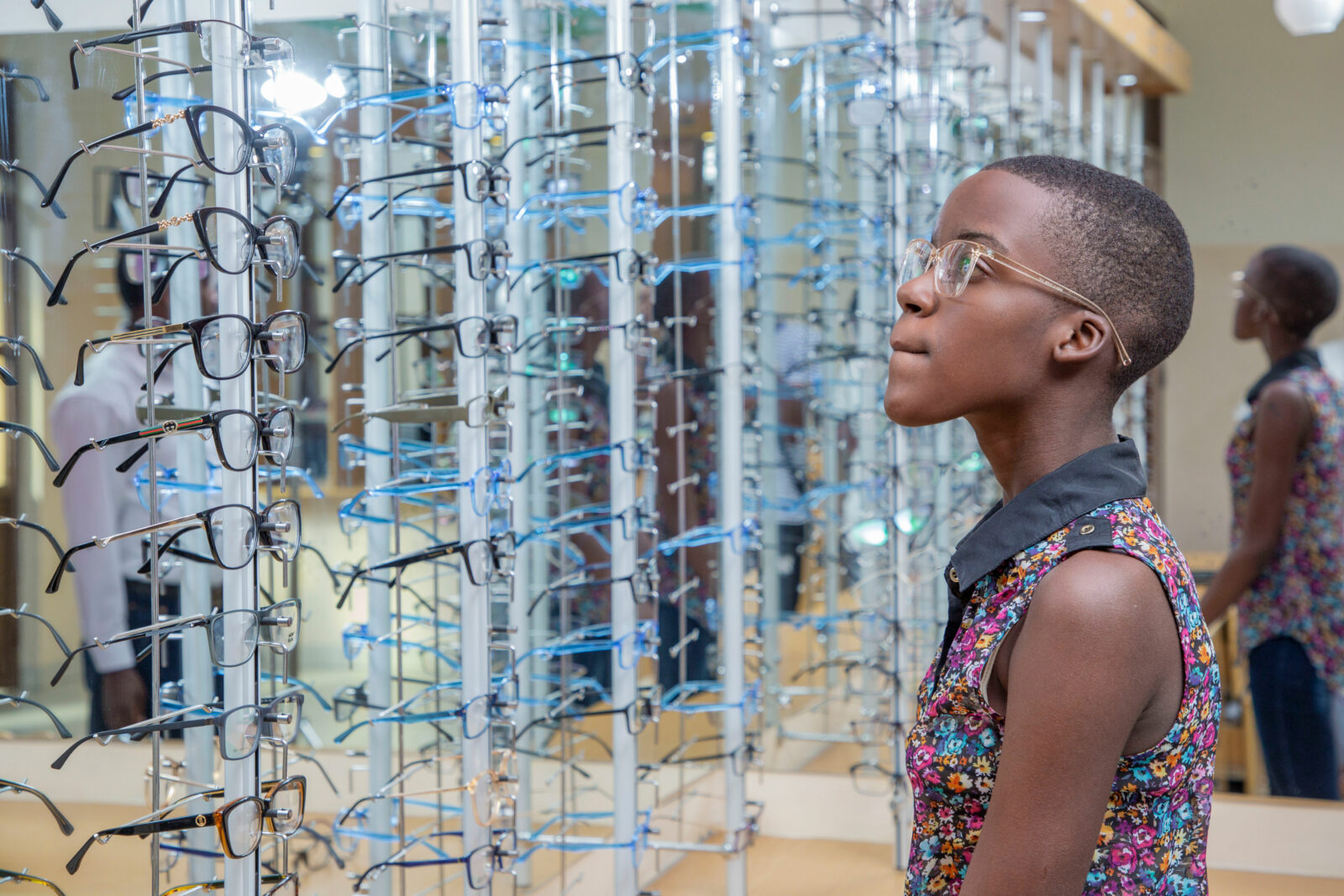
Finances
Financial results 2023
Thanks to the contributions from funds, governments and donors, we could also make a difference in thousands of lives in 2023. This chapter provides you with an explanation of the most important results and the main points of our financial policy.
In 2023, we spent 83% of our income on implementing our objective. This means that we spent more than 2.9 million euros on our projects for eye care and inclusion in the project countries. Of the total costs, 3.2 million (82.5%) could be devoted to our objective, whereby part of the expenditure was funded from our reserves.
The total spending and costs were in 2023 €3,910,193
These expenses can be divided as follows:
In 2023, SeeYou received a total amount of €3,840,148
This revenue was received from the following sources:
Expenditure
Income
| Spent on objectives | |
|---|---|
| € | |
| (Eye)care and inclusion for persons with disabilities in project countries | 2,927,740 |
| Awareness raising | 299,519 |
| Other expenses | |
| Fundraising | 454,619 |
| Management and administration | 228,315 |
| 3,910,193 |
| 2023 sources of income by origin | |
|---|---|
| € | |
| Income from individuals | 1,169,003 |
| Income from businesses | 87,565 |
| Grants from governments | 1,105,184 |
| Income from other not-for-profit organisations | 1,477,272 |
| Other sources of income | 1,124 |
| 3,840,148 |
Income
In 2023, we received a total of € 3,840,148, which was almost the same amount as in 2022. We are very pleased with this result, especially as 2023 was an uncertain year in the area of fundraising. International crises, such as the war in Ukraine, inflation and higher costs influenced the giving behaviour of donors. The abolition of the giro cheque also had a negative impact. Additionally, several equity funds were hesitant to make new commitments due to the new tax legislation. We are therefore grateful that we could maintain the total income at a comparable level to the previous year.
Income from individuals
Income from individuals was on balance higher than budgeted, and also higher than in 2022. This was due to a legacy of € 359,000 that we received at the end of 2023. This legacy, earmarked for eye care, will be spent in the coming years. Apart from the legacy, we saw a downward trend in income from individual donors. However, there was a clear growth in income from companies. From 2024 onwards, we will therefore invest more in the relationship with companies, and tone down our efforts to raise funds among private individuals. That will allow us to devote more funds to our projects against lower costs.
Grants from governments
The government grants cover the We are Able! programme. Expenditure for this programme in Uganda, Sudan and South Sudan was 98% of the budgeted amount. The revenues were linked to this. Due to the war in Sudan, our partner ADD had to carry out the programme under difficult and sometimes dangerous conditions. That was not completely successful, and as a result, the spending level was less than planned.
Income from not-for-profit organisations
The income from other not-for-profit organisations remained slightly under the budgeted amount, and decreased compared to 2022, partly because several projects and the associated funding were finalised in 2023, whereas those projects were still fully operational in 2022. From the funds received, we could, amongst other things, fund the Every Life Matters programme, the EmployAble programme and eye care programmes in Ethiopia and Rwanda. In the long term, we would like to focus on further growth in this segment. In 2023, we made long-term agreements with various funds to support our work, as can be read from the budget for 2024 as well.
From the total income, we were able to spend 84% on our objective. This is in accordance with the goal of our strategy, which is to spend at least 85% of the available funds on our objective in 2024. The three-year average is 87%.
spe
You can find more detailed income figures in the financial statements.
Expenditure
In 2023, the total expenditure was € 3,910,193, of which 82.5% was spent on the objective of our organisation versus a budgeted percentage of 77.8%. A total of 74.9% of our expenditure was for project expenditure for our projects in Africa and Asia for inclusive eye care, access to care, education and employment, and equal rights of people with disabilities. And 7.7% was spent on raising awareness and education about the need for inclusive development in development cooperation.
Organisation costs
The organisation costs, such as fundraising and management and administration, remained below the budgeted amount. The indicators for this are lower than we had foreseen and calculated in the budget. For example, the costs of fundraising were 11.6% of the total budget and expenses for management and administration amounted to 5.8%. These figures are comparable to 2022. We believe it is important that these costs remain limited.
Personnel costs
Personnel costs remained slightly below the budgeted amount. This was not easy to achieve because, just as in 2022, we had to deal with a high level of absence due to illness. This was, amongst other things, due to the long-term absence of several employees as a result of (long) COVID. We had to compensate for this by hiring external support. The costs for this could be partly covered by the disbursement of the sick leave insurance. Several vacancies could not be filled. Therefore, the staffing level was maintained by temporarily hiring in independent professionals. As a result of this, the number of non-salaried personnel increased. The total personnel costs did, nevertheless, remain within the budgeted amount. And the number of FTE (salaried) within our organisation decreased from an average of 15.26 in 2022 to 12.75 FTE in 2023.
Last year, the salary costs rose considerably. This was mainly because of the new collective labour agreement, Social Work, which implemented a salary increase of 7%, effective from 1 July 2023. Until 2023, we followed this collective labour agreement for the primary employment conditions. In 2024, we will determine how to shape future secondary employment conditions in consultation with our employees.
The team worked hard to realise our objectives and achieve the intended results.
Result allocation
We closed the accounts for 2023 with a net negative income of € 82,335. Although this is comparable to 2022 (-/- € 86,016), the allocation of results shows a different picture. As the non-earmarked funds from fundraising were considerably less, we could not cover all of the organisation’s costs. And although we had anticipated this by reducing costs, we nevertheless had to deal with a higher loss than budgeted in 2023. A combination of events, including a lower income than budgeted, high absence due to illness and higher costs, such as the unforeseen funding of a project in the countries where SeeYou is active, led to a withdrawal from the reserves of € 530,900. Some of these costs were foreseen and charged to the Mission implementation reserve 2021-2024 (€ 219,350 the budgeted amount was € 180,873). An amount of € 311,550 had to be charged to the Continuity reserve.
Due to the relative rise in income earmarked for a project and the legacy at the end of the year, we could add € 448,565 to the Designated reserves. These reserves will be spent within our projects in the short or medium term.
Reserves policy
The reserves have been segmented according to the purpose assigned by the board. SeeYou adheres to a total reserve position with a bandwidth of 80% – 100% of the organisation’s net costs. The net costs of the organisation include the total costs minus the direct project costs and the costs of programme management and administration that can be directly attributed to the projects.
The sector association Goede Doelen Nederland recommends a maximum reserve of one-and-a-half times the organisation’s annual costs. SeeYou remains well under this norm. On the one hand, this means that we have enough capacity to compensate for setbacks in line with the risk analysis. At the same time, applying an upper limit to the reserve ensures that as much as possible, we invest our resources in projects for (eye) care and inclusive development in our project countries.
Earmarked reserves
Besides the Continuity reserve, SeeYou has also formed the following earmarked reserves at the end of 2023:
– Emergency aid reserve: € 75,000
– Mission implementation reserve 2021-2024: € 235,438
Mission implementation reserve 2021-2024
The Continuity reserve was formed to cover short-term risks and ensure that we can meet all future obligations. The Continuity reserve is part of the total reserve, and the standard applied to this. As a consequence of changing circumstances (falling income of non-earmarked funds), it has become more difficult to cover all organisation costs. Consequently, we had to withdraw € 311,550 from the Continuity reserve to cover these costs in 2023.
In combination with new steps that stimulate growth, we have taken various measures to further reduce structural costs. For further information about this, please see our budget 2024.
Mission implementation reserve 2021-2024
This reserve was formed from a legacy in 2019. It is intended to develop and roll out our strategy in our project countries in Africa and Asia, as well as the support that is required for this from the Netherlands. The substantive framework for this was established in 2020.
In summary, the reserve is to be used between 2021 and 2024 to:
- Invest in the organisation to structurally increase the resource acquisition (own fundraising) by an average of 5% per year, which will facilitate a structurally higher investment in our projects in Asia and Africa.
- Reach a greater number of children and adults with a (visual) disability in our project countries, and in doing so, achieve a greater impact on these people’s lives.
The supervisory board monitors progress and results on the basis of concrete indicators. An annual evaluation will be performed to determine whether the investment from the reserve is having the desired effect, or whether it requires adjustment.
For the year 2023, € 180,873 was withdrawn from the reserve and included in the budget. The expenditure charged to this reserve in 2023 was higher than planned due to extra costs for fundraising and communication. The goal behind using this reserve is to build up a balanced exploitation and growth of available funds for our programmes and projects. In 2023, € 219,350 was charged to this reserve. The balance of this reserve remains earmarked for use in improving the realisation of our mission. Each time, the most important consideration is using the available funds as effectively as possible. In 2024, this reserve will have been completely used.
Allocated funds
A total of € 448,565 was added to the Allocated funds. This fund shows which part of the gifts with a specific project destination have not yet been spent. Income was received over the course of the year. Relatively large amounts that we received at the end of the year (among other things, a legacy of € 359,000) could not be completely spent in the year of receipt. On the other hand, during the year, project expenditure has been funded with resources received in previous years. Therefore, on balance, more is spent from the Allocated funds than is added to it.
We are striving to avoid the pre-funding of projects with our own funds as much as possible. For this reason, our policy is aimed at acquiring as much project funding as possible for the following year in the current year. The consequence of this change in policy is that the balance of the Allocated funds has increased. Eventually, a new balance will arise between additions to and withdrawals from the Allocated funds, as a result of which the annual mutation is expected to decrease again.
Standard percentages
We want all the received donations to contribute to an inclusive world and quality eye care. If we are to do our work well and professionally, we must invest in fundraising and quality improvement. We are committed to keeping the cost percentages below the benchmark set by Goede Doelen Nederland. Table 2 shows the percentages achieved compared to the benchmark for small fundraising institutions (< € 5 million). Our long-term goal is that, on average, 85% of the available funds (income) is spent on our objectives. The three-year average across the years 2021-2023 is 87%.
The benchmark percentages stated below in Tables 2 and 3 concern benchmark expenditures compared to the total expenditure and therefore not compared to income. For 2021, the benchmark for expenditure on the objectives was 78%. As SeeYou, we spent 82.5% on the objectives in 2023. Our cost percentage for fundraising remained stable compared to 2022 and was lower than the benchmark. Our cost percentage for management and administration is, on average, lower than the benchmark.
Table 2. Benchmark 2021 compared to SeeYou figures
| 3-year average | Total 2023 | Total 2022 | Total 2021 | Benchmark 2021 | |
|---|---|---|---|---|---|
| Target spending percentage of the income: Spending on objectives/total income | 87.0% | 84.0% | 86.9% | 90.2% | |
| Target spending percentage of the expenditure: Spending on objectives/total expenditure | 82.7% | 82.5% | 84.4% | 81.2% | 78.0% |
| Percentage of income for fundraising Fundraising costs/sum of acquired income | 13.2% | 11.8% | 11.8% | 16.1% | |
| Percentage of expenditure for fundraising Fundraising costs/sum of expenditure | 11.5% | 11.6% | 11.4% | 11.4% | 15% |
| Management and administration costs: Management and administration costs/total expenditure | 4.8% | 5.8% | 4.2% | 4.3% | 7.0% |
Budget 2024
We have taken several measures in response to the shortfall in 2023. For example, this analysis revealed that fundraising among private individuals, besides costing a lot of money, also required a lot of time and energy from our team even though, on balance, it barely yields extra funds to realise our projects for eye care and inclusion. And although the size of our team and the organisation costs are well managed and in line with what is usual in the sector (see benchmark), we still need to further reduce our costs.
This has resulted in the following measures:
- We will invest less in broad (non-earmarked) fundraising among private individuals.
- We will invest more in earmarked fundraising, especially geared toward companies, equity funds, charities, and institutional funds.
- We will focus on reducing costs by cutting organisational costs in combination with the more efficient and effective organisation of our project portfolio. That last focus will enable us to carry out our work with a smaller team while maintaining the project portfolio’s quality and size.
These measures, organisational changes and the ongoing focus on cost reduction – such as a smaller team – will result in lower costs, although the full effect of this will only become visible in 2025. We expect that from 2025 onwards, we will realise a positive or at least a break-even result. This means that we will still have to accept a loss in 2024, but this can still be covered by the balance in the Mission implementation reserve 2021-2024.
We consider this a realistic scenario, but if the results are worse than expected, further measures must be taken by the end of 2024. However, the initial results of the sketched contours reveal a positive picture. These results safeguard the continuity of our programmes and projects and offer realistic prospects for their growth.
The budget for 2024 assumes an expected income of more than € 3.6 million. The expenditure will be higher, especially due to the funding of programmes with the 2023 Allocated funds. Compared to the three-year average until 2023, the organisation will achieve acceptable and more or less similar indicators in 2024.
The intensification of the efforts for the earmarked fundraising is aligned with the changed structure of the organisation and is conditional for the further growth of our projects. Secondly, partly due to the increasing attention for quality and accountability, we want to further improve our responsibility towards donors, supporters and implementing partners. Consequently, the budgeted amount for management and administration has been increased.
Thanks to the contributions from gifts from private individuals, funds, foundations and institutional funds, we can, to a significant extent, continue our project portfolio. Together with our partners, we are committed to (eye) care, inclusion and rights for people with disabilities in seven countries. Further, we will pay considerable attention to managing costs, and we aim to maintain the present level of fundraising and, if possible, increase it.
The budget for 2024 is included as an annex in the financial statements 2023.
Table 3. Benchmark 2021 compared with SeeYou’s budget.
| 3-year average | Benchmark 2021 | Budget 2024 | |
|---|---|---|---|
| Target spending percentage of the income: Spending on objectives/total income | 87.0% | 90.5% | |
| Target spending percentage of the expenditure: Spending on objectives/total expenditure | 82.7% | 78.0% | 82.9% |
| Percentage of income for fundraising Fundraising costs/sum of acquired income | 13.2% | 10.7% | |
| Percentage of expenditure for fundraising Fundraising costs/sum of expenditure | 11.5% | 15.0% | 9.8% |
| Management and administration costs: Management and administration costs/total expenditure | 4.8% | 7.0% | 7.3% |
As a part of the projects are financed from the Allocated funds, the total result of the exploitation in 2024 is -/- € 329,471. The result allocation has been (budgeted) as follows:
3. Allocation of profits and/or losses
| Budget 2024 | Realisation 2023 | Budget 2023 | |
|---|---|---|---|
| Allocation of result reserves | € | € | € |
| Continuity reserve | 130,467 | -311,550 | - |
| Emergency aid reserve | - | - | - |
| Mission implementation reserve 2021-2024 | -235,438 | -219,350 | -180,873 |
| -104,971 | -530,900 | -180,873 | |
| Allocation of result funds | |||
| Allocated funds | -224,500 | 448,565 | |
| Total | -329,471 | -82,335 | -180,873 |
An amount of € 224,500 will be withdrawn from the Allocated funds for funding projects. These funds were received in 2023. The exploitation loss of the organisation is € 104,971. This loss is covered by the Mission implementation reserve 2021-2024, which will be subsequently dissolved. The balance will be added to the Continuity reserve, which will then be at a sufficient level. That means we will have satisfied our own and general standards for reserves.
Multiannual budget
In 2020, we took the first steps towards evaluating the SeeYou multiannual budget and strategy. A new multiannual budget will be drawn up along the lines of the new strategy to be developed for the post-2025 period. However, the contours of this are not new and have already been briefly described above. After the reorganisation in 2020 and the growth strategy for (non-earmarked) fundraising, we have realised that our objectives need adjusting in the changing world of recent years, which is marked by increasing uncertainty (with the coronavirus pandemic, war in Ukraine, energy crisis and high inflation). Over the past few years, we have already reduced our structural costs and will continue to do so insofar as this is possible. In combination with a growth strategy aimed at expanding resources for our projects – and with that also more possibilities to attribute direct costs to projects – we want to solve the problem of exploitation shortfalls and achieve a healthy exploitation.


Annual accounts
1. Balance sheet on 31 December (after allocation of profits and/or losses)
| Assets | 12/31/2023 | 12/31/2022 | |
|---|---|---|---|
| € | € | ||
| Fixed assets | |||
| Tangible assets | 7.1 | ||
| Buildings | 43,616 | 49,244 | |
| Inventory and IT | 28,294 | 47,947 | |
| Vehicles | - | - | |
| 71,910 | 97,191 | ||
| Financial assets | |||
| Receivables | 7.2 | ||
| Project contributions to be received | 136,836 | 144,464 | |
| Project contributions paid in advance | 155,150 | 181,163 | |
| Legacies to be claimed | 482,132 | 170,160 | |
| Other receivables and assets | 9,602 | 25,144 | |
| 783,720 | 520,931 | ||
| Liquid assets | 7.3 | 2,505,407 | 2,401,594 |
| Total assets | 3,361,037 | 3,019,716 | |
| Liabilities | 12/31/2023 | 12/31/2022 | |
| € | € | ||
| Reserves and funds | 7.4 | ||
| Reserves | |||
| Continuity reserve | 960,137 | 1,271,687 | |
| Emergency aid reserve | 75,000 | 75,000 | |
| Mission implementation reserve 2021-2024 | 235,438 | 454,788 | |
| 1,270,575 | 1,801,475 | ||
| Funds | |||
| Allocated funds | 606,163 | 157,598 | |
| Provisions | 7.5 | ||
| Income payment obligation | 275,788 | 280,419 | |
| 275,788 | 280,419 | ||
| Current liabilities | 7.6 | ||
| Debts related to projects | 929,430 | 541,197 | |
| Taxes and social security contributions | 93,984 | 84,334 | |
| Other current liabilities personnel | 98,532 | 108,416 | |
| Amounts received in advance | |||
| Other current liabilities | 86,565 | 46,277 | |
| 1,208,511 | 780,224 | ||
| Total liabilities | 3,361,037 | 3,019,716 |
2. State of income and expenditure
| Income | Realisation 2023 | Budget 2023 | Realisation 2022 | |
|---|---|---|---|---|
| € | € | € | ||
| Income from individuals | 8.1 | 1,169,003 | 855,000 | 903,485 |
| Income from companies | 8.2 | 87,565 | 70,250 | 81,054 |
| Grants from governments | 8.3 | 1,105,184 | 1,198,985 | 1,115,830 |
| Income from other not-for-profit organisations | 8.4 | 1,477,272 | 1,532,462 | 1,775,389 |
| Sum of income raised | 3,839,024 | 3,656,697 | 3,875,758 | |
| Other income | 8.5 | 1,124 | 500 | 98 |
| Total income | 3,840,148 | 3,657,197 | 3,875,856 | |
| Expenditure | ||||
| € | € | € | ||
| Spent on objectives | ||||
| (Eye) care and inclusion for people with disabilities in project countries | 5 | 2,927,740 | 2,539,276 | 3,162,097 |
| Awareness raising | 5 | 299,519 | 437,226 | 206,899 |
| 3,227,259 | 2,976,502 | 3,368,996 | ||
| Fundraising | ||||
| Fundraising costs | 5 | 454,619 | 572,097 | 456,716 |
| Management and administration | ||||
| Management and administration costs: | 5 | 228,315 | 277,971 | 166,298 |
| Sum of expenditure | 3,910,193 | 3,826,570 | 3,992,010 | |
| Balance before financial income and expenditure | -70,045 | -169,373 | -116,154 | |
| Balance financial income and expenditure | 9.8 | -12,290 | -11,500 | 30,138 |
| Profit/loss | -82,335 | -180,873 | -86,016 |
3. Allocation of profits and/or losses
| Realisation 2023 | Budget 2023 | Realisation 2022 | |
|---|---|---|---|
| Allocation of result reserves | € | € | € |
| Continuity reserve | -311,550 | - | - |
| Emergency aid reserve | - | - | -25,000 |
| Reserve to cover exploitation 2020 | - | - | - |
| Mission implementation reserve 2021-2024 | -219,350 | -180,873 | -10,606 |
| -530,900 | -180,873 | -35,606 | |
| Allocation of result funds | |||
| Allocated funds | 448,565 | - | -50,410 |
| Total | -82,335 | -180,873 | -86,016 |
4. Cash flow statement
| 2023 | 2022 | |||
|---|---|---|---|---|
| Cash flow from operational activities | € | € | ||
| Total income | 3,840,148 | 3,875,856 | ||
| Total expenditure | 3,910,193 | 3,992,010 | ||
| Operating result | -70,045 | -116,154 | ||
| Adjustments for: | ||||
| Amortisations and depreciations | 25,281 | 39,703 | ||
| Changes in provisions | -4,630 | -56,444 | ||
| 20,651 | -16,741 | |||
| Changes in operating capital | ||||
| Receivables | -262,790 | -34,232 | ||
| Current liabilities | 428,287 | -42,306 | ||
| 165,497 | -76,538 | |||
| Kasstroom uit bedrijfsoperaties | 116,103 | -209,433 | ||
| Ontvangen interest | - | - | ||
| Betaalde interest | - | - | ||
| Financiele baten en lasten | -12,290 | 30,138 | ||
| -12,290 | 30,138 | |||
| Total cash flow from operational activities | 103,813 | -179,295 | ||
| Total cash flow from investment activities Investments in other financial assets | ||||
| Investments in material and financial fixed assets | - | -23,084 | ||
| Disposal of material and financial fixed assets | - | - | ||
| Total cash flow from investment activities | - | -23,084 | ||
| Cash increase/decrease | 103,813 | -202,379 | ||
| Position liquid funds on 31-12 | 2,505,407 | 2,401,594 | ||
| Position liquid funds on 1-1 | 2,401,594 | 2,603,973 | ||
| Increase/decrease in cash | 103,813 | -202,379 | ||
| The cash flow statement has been prepared using the indirect method. |
5. Overview of expenditure
| Allocation | Objectives | Fundraising, management and administration | ||||||
|---|---|---|---|---|---|---|---|---|
| (Eye) care and inclusion for people with disabilities in project countries | Awareness raising | Fundraising | Management and administration | Total 2023 | Budget for 2023 | Total 2022 | ||
| Expenditure | € | € | € | € | € | € | € | |
| Grants and contributions | 9.1 | 2,105,805 | - | - | - | 2,105,805 | 1,857,947 | 2,330,597 |
| Publicity and communication | 9.2 | - | 147,309 | - | - | 147,309 | 215,000 | 137,608 |
| Direct fundraising costs | 9.3 | - | - | 134,978 | - | 134,978 | 174,700 | 137,975 |
| Personnel costs | 9.4 | 725,297 | 134,314 | 282,060 | 201,471 | 1,343,142 | 1,368,835 | 1,199,997 |
| Housing costs | 9.5 | 13,460 | 2,493 | 5,234 | 3,739 | 24,926 | 43,350 | 29,088 |
| Office and general costs | 9.6 | 69,526 | 12,875 | 27,038 | 19,313 | 128,752 | 115,108 | 117,043 |
| Depreciations | 9.7 | 13,652 | 2,528 | 5,309 | 3,792 | 25,281 | 51,630 | 39,703 |
| Total expenditure 2023 | 2,927,740 | 299,519 | 454,619 | 228,315 | 3,910,193 | 3,826,570 | 3,992,010 | |
| Budget for 2023 | 2,539,276 | 437,226 | 572,097 | 277,971 | 3,826,570 | |||
| Total 2022 | 3,162,097 | 206,899 | 456,716 | 166,298 | 3,992,010 | |||
| Total 2023 | Budget for 2023 | Total 2022 | ||||||
| Target spending percentage of the income: Spending on objectives/total income | 84.0% | 81.4% | 86.9% | |||||
| Target spending percentage of the expenditure: Spending on objectives/total expenditure | 82.5% | 77.8% | 84.4% | |||||
| Percentage of income for fundraising Fundraising costs/sum of acquired income | 11.8% | 15.6% | 11.8% | |||||
| Percentage of expenditure for fundraising Fundraising costs/sum of expenditure | 11.6% | 15.0% | 11.4% | |||||
| Management and administration costs: Management and administration costs/total expenditure | 5.8% | 7.3% | 4.2% |
6. Accounting policies
General accounting policies
These financial statements have been prepared in accordance with Guideline 650 for Fundraising Organisations as set out in the Dutch Guidelines for Annual Reporting. The purpose of this Guideline is to provide insight into the costs of the organisation and how funds are spent in relation to the purpose for which those funds were collected. The financial statements are presented in euros.
As from December 2023, the SeeYou Foundation has been converted from a one-tier model to a two-tier model. There is a one-member management board (executive director).
Comparative figures
The comparative figures for 2022 have been adjusted where relevant for the purpose of comparison with the year under review.
Consolidation
The board of the SeeYou Foundation is also the board of the Open Oog Foundation. The financial statements of the SeeYou Foundation do not include any consolidated figures relating to the result and the equity of the Open Oog Foundation because the significance of this foundation is largely negligible.
Valuation policies
General valuation policies
Unless stated otherwise, assets and liabilities are recognised at amortised cost.
Currency translation
Transactions in foreign currency are initially recognised at the functional exchange rate on the date of the transaction. Monetary balance sheet items in foreign currency are translated at the functional exchange rate on the balance sheet date.
Exchange differences arising during the settlement or translation of monetary items in foreign currency are accounted for in the statement of income and expenditure.
Tangible fixed assets
The tangible fixed assets that are necessary for our objective and business operations are measured at cost less depreciation determined on the basis of the estimated useful life of the asset and taking into account any residual value. The depreciation amounts to a percentage of this cost.
Receivables, liquid assets, debts and accruals and deferrals
Receivables, liquid assets, debts and accruals and deferrals are measured at amortised cost less a provision for bad debts based on an individual assessment of the receivables.
Project liabilities are recognised based on a decision in that respect that is made known in writing to the recipient of the grant and are charged to the financial year in which the project activities must be carried out by the partner implementing the project.
Reserves and funds
Reserves are monies that are at the disposition of the Foundation. Designated reserves may be maintained by the board for a specific purpose.
Funds are monies that must be spent within the context of the objectives for which they were made available. This concerns the unspent part of earmarked donations and other funds recognised under income.
Provisions
Provisions are recognised when it is probable or certain that a liability will arise but for which the exact amount or the time of the outflow of the resources is unknown.
Accounting policies for determining the result
General accounting policies for determining the result
The result is determined as the difference between the income, all related costs, and other expenses attributable to the reporting year, with due observance of the aforementioned accounting policies.
Income
Income consists of all the proceeds attributable to the reporting year.
Legacies are recognised in the reporting year in which the size of the estate can be reliably determined, i.e., if the payment has been announced. Advances are recognised in the financial year in which they are received. In-kind donations are measured at fair market value.
Expenditure
Financial income and expenses consist of the interest income and expenses relating to the reporting period.
Employee remuneration
Salaries and social security costs are allocated to the reporting period in which they are due, in accordance with the employment contracts.
The Foundation has granted its employees a pension based on a career average scheme. The pension scheme is administered by the industry-wide pension fund Pensioenfonds Zorg en Welzijn.
The contributions due for the financial year are recognised as costs.
Contributions not yet paid by the balance sheet date are recognised as a liability. The risks of price indexation and investment return may lead to an adjustment of future contributions to Pensioenfonds Zorg en Welzijn.
These risks are not reflected in any provision in the balance sheet. In the event of a deficit at Pensioenfonds Zorg en Welzijn, the Foundation has no obligation to make additional contributions other than future higher contributions.
Pensioenfonds Zorg en Welzijn currently has a deficit. The fund reports the following:
In 2023, the current funding ratio of Pensioenfonds Zorg en Welzijn (PFZW) decreased from 108.7% to 106.3%. The policy funding ratio increased from 111.5% to 112.0%. The decrease in the current funding ratio was mainly due to the decrease in the interest rate and the increase in the pensions as at 1 January 2024. PFZW achieved an annual return on investment of 8.2%. The total capital invested in 2023 therefore increased from €216.5 billion to €237.8 billion. Source: Quarterly reports (pfzw.nl).
Cost allocation
Personnel costs, office accommodation costs, office and general costs and depreciation are divided between our objective, fundraising income, and management and administration.
Changes to the tangible fixed assets have been summarised in the following table:
7.1 Explanation of the balance sheet – Fixed assets
| 7.1 Tangible fixed assets | Buildings | Inventory & IT | Vehicles | Total |
|---|---|---|---|---|
| € | € | € | € | |
| Situation on 1 January 2023 | ||||
| Purchase value | 187,593 | 330,971 | 9,810 | 528,374 |
| Accumulated depreciation | -138,349 | -283,024 | -9,810 | -431,183 |
| 49,244 | 47,947 | - | 97,191 | |
| Changes in fiscal year 2023 | ||||
| Investments | - | - | - | 0 |
| Depreciations | -5,628 | -19,653 | - | -25,281 |
| Disposals | - | - | - | - |
| Cost of disposals | - | - | - | - |
| -5,628 | -19,653 | - | -25,281 | |
| Situation on 31 December 2023 | ||||
| Purchase value | 187,593 | 330,971 | 9,810 | 528,374 |
| Accumulated depreciations | -143,977 | -302,677 | -9,810 | -456,464 |
| 43,616 | 28,294 | - | 71,910 | |
| Depreciations are calculated based on the following annual depreciation percentages: | ||||
| Buildings (excluding land) | 3% | |||
| Inventory and IT | 10% - 25% | |||
| Vehicles | 20% |
7.2 Explanation of the balance sheet – Financial assets
| 7.2 Receivables | 2023 | 2022 |
|---|---|---|
| € | € | |
| Project contributions to be received | 136,836 | 144,464 |
| Prepaid project contributions | 155,150 | 181,163 |
| Legacies to be received | 482,132 | 170,160 |
| Other receivables | ||
| Contributions to be received | 2,571 | 16,712 |
| Accrued interest | 4.514 | 184 |
| Prepaid contributions | 2,517 | 8,248 |
| Total other receivables | 9,602 | 25,144 |
| Balance on 31 December | 783,720 | 520,931 |
| A provision for ineligibility is not considered necessary. |
7.3 Explanation of the balance sheet – Liquid assets
| 7.3 Liquid assets | 2023 | 2022 |
|---|---|---|
| € | € | |
| Cash | 1,080 | 671 |
| Bank account - current accounts | 1,311,226 | 869,664 |
| Bank account - US dollars | 897 | 5,114 |
| Bank account - savings | 1,192,204 | 1,526,145 |
| Balance on 31 December | 2,505,407 | 2,401,594 |
| The liquid assets are freely available. | ||
| The bank account in US dollars is valued according to the exchange rate on the balance date. |
7.4 Reserves and funds
| 7.4 Reserves and funds | 12/31/2023 | 12/31/2022 | ||
|---|---|---|---|---|
| Reserves | € | € | ||
| Continuity reserve | 960,137 | 1,271,687 | ||
| Emergency aid reserve | 75,000 | 75,000 | ||
| Mission implementation reserve 2021-2024 | 235,438 | 454,788 | ||
| Total | 1,270,575 | 1,801,475 | ||
| The development can be displayed as follows: | Balance on 1/jan | Allocation of profits and/or losses Allocation | Other changes | Balance on 31/dec |
| Continuity reserve | 1,271,687 | -311,550 | - | 960,137 |
| Emergency aid reserve | 75,000 | - | - | 75,000 |
| Mission implementation reserve 2021-2024 | 454,788 | -219,350 | - | 235,438 |
| Total | 1,801,475 | -530,900 | - | 1,270,575 |
The reserves are segmented according to the purpose for which the board has allocated these. SeeYou adheres to a (total) reserve position with a bandwidth of 80% – 100% of the organisation’s net costs, which include total costs minus the direct project costs and the costs of programme management and overhead costs that can be directly attributed to the projects.
The sector association Goede Doelen Nederland recommends a maximum reserve of 1.5 times the organisation’s annual costs. SeeYou remains well below this norm.
On the one hand, having this figure in reserve means we have sufficient capacity to absorb significant setbacks, which is in line with the risk analysis. At the same time, applying an upper limit to the reserve ensures that we invest our resources as much as possible in (eye) care and inclusive development in our project countries.
7.4 Continuity reserve
| 2023 | 2022 | |
|---|---|---|
| Continuity reserve | € | € |
| Balance on 1 January | 1,271,687 | 1,271,687 |
| Change according to allocation of profits and/or losses | -311,550 | - |
| Balance on 31 December | 960,137 | 1,271,687 |
The reserves have been segmented according to the purpose assigned by the board. SeeYou maintains a total reserve position with a bandwidth of 80% – 100% of the net costs of the organisation. The net costs of the organisation are taken to mean the total costs less direct project costs, programme management costs directly allocated to the projects and project overheads. The sector association Goede Doelen Nederland recommends a maximum reserve of one-and-a-half times the organisation’s annual costs. SeeYou remains well under this norm. On the one hand, this means that we have enough capacity to compensate for setbacks in line with the risk analysis. At the same time, applying an upper limit to the reserve ensures that as much as possible, we invest our resources in projects for eye care and inclusive development in our project countries.
The Continuity reserve was formed to cover short-term risks and ensure that we can meet all future obligations. The Continuity reserve is part of the total reserve and the standard applied to this. As a consequence of changing circumstances (falling income of non-earmarked funds), it has become more difficult to cover all organisation costs. SeeYou is reflecting on further measures to deal with this development.
Earmarked reserves
Besides the Continuity reserve, SeeYou has also formed the following earmarked reserves:
7.4 Emergency aid reserve
| 2023 | 2022 | |
|---|---|---|
| Emergency aid reserve | € | € |
| Balance on 1 January | 75,000 | 100,000 |
| Change according to allocation of profits and/or losses | - | -25,000 |
| Balance on 31 December | 75,000 | 75,000 |
The countries where we work with strategic partners are regularly affected by natural disasters, conflicts or other unexpected emergencies, such as the COVID-19 pandemic. We want to be able to provide emergency aid in those situations, provided that our strategic local or international partners have sufficient capacity to adequately provide this aid. A reserve has been set up to allow us to respond quickly in emergency situations and immediately start up and (pre)finance preliminary activities, regardless of fundraising. Any funds raised for this emergency aid then flow back into the reserve until the pre-financing level has been achieved once more’. As a result, in the event of a new emergency response, money can again be quickly released and used for the benefit of victims of natural disasters, conflicts or other unexpected emergencies.
In 2023, no use was made of the emergency aid funds. The current level remains reserved for the purpose of this reserve.
7.4 Mission implementation reserve 2021-2024
| 2023 | 2022 | |
|---|---|---|
| Mission implementation reserve 2021-2024 | € | € |
| Balance on 1 January | 454,788 | 465,394 |
| Change according to allocation of profits and/or losses | -219,350 | -10,606 |
| Balance on 31 December | 235,438 | 454,788 |
The Mission implementation reserve 2021-2024 was formed out of a legacy in 2019, and it is intended for the design and roll-out of our new strategy in our project countries in Africa and Asia, and the support that is required with this from the Netherlands. The board established the substantive frameworks for this in 2020. In summary, the reserve is to be used between 2021 and 2024 to:
Invest in the organisation to structurally increase the resource acquisition (own fundraising) by an average of 5% per year, which will make possible a structurally higher investment in our projects in Asia and Africa.
Reaching a greater number of children and adults with a disability in Asia and Africa, and thus having a greater impact on the lives of people with a visual impairment or other disability.
Progress and results are monitored by the board based on concrete indicators.
Every year, it will be evaluated whether the investment from the reserve has had the desired effect, or whether it needs to be adjusted.
For the year 2023, €180,873 was budgeted. In the realisation of 2023, costs were calculated based on the framework stated. The required cover from this reserve is €219,350.
The use of this reserve is further set out in the multiannual budget. It is expected that this reserve will be completely invested by 2024.
7.4 Allocated funds
| 2023 | 2022 | |
|---|---|---|
| Allocated funds | € | € |
| Balance on 1 January | 157,598 | 208,008 |
| Change according to allocation of profits and/or losses | 448,565 | -50,410 |
| Balance on 31 December | 606,163 | 157,598 |
Incomes are received over the course of the year. Therefore, spending the resources received in the same fiscal year is not always possible. The COVID-19 pandemic has also had a delaying effect on project expenditure. Allocated funds still to be spent are accounted for in the allocated funds. In 2023, the balance of funds still to be spent rose considerably due to the receipt of a legacy of € 359,000 that will be spent on eye projects in Ethiopia and Indonesia in the coming years.
7.5 Provisions
| 2023 | 2022 | |
|---|---|---|
| Income payment obligation | € | € |
| Balance on 1 January | 280,419 | 336,863 |
| Endowment | 22,109 | -31,943 |
| Payments | -26,740 | -24,501 |
| Balance on 31 December | 275,788 | 280,419 |
This provision was formed as a result of an inheritance received. The SeeYou Foundation has undertaken to disburse money to the heirs of this estate. The payment is subject to various conditions, including indexation based on the Consumer Price Index. The provision is based on an actuarial calculation. In 2023, the actuarial interest rate was 3.800% (2022: 3.955%) based on the mortality table (male and female mortality between 2014-2019) method SRA.
7.6 Current liabilities
| 2023 | 2022 | |
|---|---|---|
| € | € | |
| Liabilities related to projects | ||
| Project obligations | - | - |
| Amount still to be settled with implementing partners | 235,129 | 123,734 |
| Amount received in advance from donors for ongoing projects | 656,801 | 368,444 |
| Amount received in advance for projects still to be started | 37,500 | 49,019 |
| 929,430 | 541,197 | |
| Taxes and social security contributions | ||
| Payroll tax and social security contributions to be paid | 54,337 | 64,167 |
| Pension contribution to be paid | 39,647 | 20,167 |
| Balance on 31 December | 93,984 | 84,334 |
| Other current liabilities personnel | ||
| Provision for holiday pay including social security contributions | 32,912 | 40,470 |
| Provision for annual leave | 65,620 | 67,946 |
| Other liabilities personnel | - | - |
| 98,532 | 108,416 | |
| Other liabilities | ||
| Accounts payable | 78,520 | 43,562 |
| Other current liabilities | 8,045 | 2,715 |
| 86,565 | 46,277 | |
| Balance on 31 December | 1,208,511 | 780,224 |
7.7 Rights and obligations not included in the balance sheet
Multiannual financial obligations
An annual lease has been signed for our office space. The total of the lease instalments that expire after the balance sheet date, amounts to approximately €10,270.
Conditional advances
If partners do not spend all of the project funds allocated in the project period concerned, then there is an underspending. The SeeYou Foundation then has the contingent right to reclaim these funds.
After underspending has been determined and made known to the partner, this is usually offset against the next agreed-upon project period.
7.8 Events after the balance sheet date
Military, economic and political conflicts but also developments as a consequence of climate change and the policy applied to this, result in a changing world. These changes will also affect relief efforts.
We are taking into account that these crises will also have an effect on income or on costs and project costs. Increased inflation leads to higher operational costs and rising wages. Besides which, our supporters feel the effects of these developments too. The disposable budget for gifts is limited. That has a noticeable effect on our fundraising.
8. Explanation of the income
| Realisation 2023 | Budget 2023 | Realisation 2022 | |
|---|---|---|---|
| 8.1 Income from individuals | € | € | € |
| Individuals | 438,310 | 580,000 | 474,640 |
| Major donors | 275,000 | 200,000 | 175,000 |
| Legacies and estates | 455,693 | 75,000 | 253,845 |
| 1,169,003 | 855,000 | 903,485 | |
| 8.2 Income from companies | € | € | € |
| Companies | 83,323 | 65,000 | 74,204 |
| Opticians | 4,242 | 5,250 | 6,850 |
| 87,565 | 70,250 | 81,054 | |
| 8.3 Grants from governments | € | € | € |
| Dutch Ministry of Foreign Affairs: We Are Able! | 1,103,282 | 1,198,985 | 1,115,830 |
| European Union: MUB | 1,902 | - | - |
| 1,105,184 | 1,198,985 | 1,115,830 | |
| 8.4 Income from other not-for-profit organisations | € | € | € |
| Funds and foundations | 1,054,180 | 1,173,556 | 1,076,495 |
| Stichting de Lichtboei | 87,975 | ||
| Churches | 69,022 | 80,000 | 67,327 |
| Schools | 630 | 10,000 | 2,709 |
| Service clubs | 3,000 | - | 6,500 |
| EO Metterdaad | 62,427 | 68,906 | 112,393 |
| Other donors | 288,013 | 200,000 | 421,990 |
| 1,477,272 | 1,532,462 | 1,775,389 | |
| 8.5 Other income | € | € | € |
| Miscellaneous | 1,124 | 500 | 98 |
| 1,124 | 500 | 98 |
SeeYou’s income is largely incidental in nature. About 22% of the donations from individuals can be called structural (commitments for > 1 year, or donors who have set up a standing order). The income from other non-profit organisations mainly relates to project contributions on an annual basis. We Are Able! has been listed under Government grants. This project runs from 2021 to 2025.
9. Explanation of the expenditure
| Realisation 2023 | Budget 2023 | Realisation 2022 | |
|---|---|---|---|
| Regio/country | |||
| Africa | 2,146,322 | 2,166,781 | 2,572,504 |
| Africa region | - | - | 362,966 |
| Ethiopia | 681,188 | 608,460 | 813,135 |
| Uganda | 352,267 | 409,586 | 433,067 |
| Rwanda | 484,557 | 474,921 | 398,328 |
| Sudan | 345,881 | 403,673 | 374,207 |
| South Sudan | 282,429 | 270,141 | 190,801 |
| Asia | 218,772 | 104,333 | 192,819 |
| Cambodja | 112,607 | 53,333 | 126,634 |
| Indonesië | 106,165 | 51,000 | 66,185 |
| NLD | 267,226 | 212,833 | 137,971 |
| Nederland | 267,226 | 212,833 | 137,971 |
| Total | 2,632,320 | 2,483,947 | 2,903,294 |
| Charged on project costs | |||
| Salary costs charged to projects | -339,194 | -341,000 | -367,089 |
| Organisation costs charged to projects | -187,321 | -285,000 | -205,608 |
| -526,515 | -626,000 | -572,697 | |
| Net grants and contributions to partners for realised projects | 2,105,805 | 1,857,947 | 2,330,597 |
The charged project costs concern direct project costs and costs that are directly charged to the project for programme management and overhead charged to the project. The budget is higher than the realised amounts because in the budget a standard “fee” is calculated based on the funds received for the project, and in the realisation, the costs are based on project costs made.
9.2 Publicity and communication
| Realisation 2023 | Budget 2023 | Realisation 2022 | |
|---|---|---|---|
| € | € | € | |
| 9.2 Publicity and communication | |||
| Publicity and communication | 19,599 | 25,500 | 17,648 |
| Awareness raising | 86,944 | 131,000 | 114,668 |
| Other | 40,766 | 58,500 | 5,292 |
| Total Publicity and communication | 147,309 | 215,000 | 137,608 |
| 9.3 Direct fundraising costs | |||
| Mailings and marketing | 104,913 | 145,000 | 105,807 |
| Miscellaneous fundraising costs | 30,065 | 29,700 | 32,168 |
| Total direct fundraising costs | 134,978 | 174,700 | 137,975 |
| 9.4 Personnel costs | |||
| Salaries | 658,775 | 947,270 | 733,274 |
| Social security contributions | 136,815 | 143,390 | 144,120 |
| Pensions | 81,495 | 109,173 | 96,670 |
| Sick leave insurance | 25,786 | 35,000 | 28,091 |
| Travel costs | 8,335 | 12,500 | 8,883 |
| International travel costs | 9,985 | 2 | 10,197 |
| Recruitment and hiring | 5,526 | 10,000 | 5,630 |
| Training and development | 5,229 | 30,000 | 10,638 |
| Hiring external expertise | 386,918 | 54,000 | 119,902 |
| Other personnel costs | 24,278 | 27,500 | 42,592 |
| Total personnel costs | 1,343,142 | 1,368,835 | 1,199,997 |
The costs for Publicity and communication as well as the Direct costs for fundraising are in line with the budget of 2022. In the budget for 2023, actions and plans were anticipated that were (partially) not realised due to the lack of capacity and a shortfall in income.
The average number of employees (in FTE) during the fiscal year 2023 was 12.75 (2022: 15.26).
Due to a high level of sick leave in 2023 (21.21%), with a predominantly long-term character related, among other things, to the consequences of long COVID, external expertise had to be hired in (non-salaried personnel). The costs for this could be covered to a large extent by the disbursement of the sick leave insurance. A number of vacancies could not be filled. Therefore the staffing level was maintained by temporarily hiring in independent professionals. As a result of this, the costs for non-salaried personnel increased.
Nevertheless, the total personnel costs remained within the budgeted amount. The number of FTE (salaried) within our organisation decreased from an average of 15.26 in 2022 to 12.75 FTE in 2023.
The increase compared to 2022 is mainly due to salary increases in 2023. SeeYou Foundation follows the wage increases of the Collective Labour Agreement Welfare. The average wage increase in 2023 was 5.5%. The costs for the Executive Director are accounted for under 10, Salaries.
9.5 Housing costs
| Realisation 2023 | Budget 2023 | Realisation 2022 | |
|---|---|---|---|
| € | € | € | |
| 9.5 Housing costs | |||
| Rent for office space Vendelier 15 in Veenendaal | 11,497 | 12,000 | 10,678 |
| Water and energy costs | 3,206 | 14,000 | 4,568 |
| Other housing costs | 10,223 | 17,350 | 13,842 |
| Total housing costs | 24,926 | 43,350 | 29,088 |
| 9.6 Office and general expenditure | |||
| IT costs | 51,559 | 43,058 | 44,980 |
| Bank fees | 7,227 | 10,000 | 11,002 |
| Accountants costs | 28,492 | 22,000 | 18,118 |
| Other | 41,474 | 40,050 | 42,943 |
| 128,752 | 115,108 | 117,043 | |
| 9.7 Depreciation costs | |||
| Buildings | 5,628 | 11,630 | 5,628 |
| Inventory & IT | 19,653 | 40,000 | 34,075 |
| Vehicles | - | - | - |
| Total depreciation costs | 25,281 | 51,630 | 39,703 |
| 9.8 Financial income and expenditure | |||
| 12,290 | 11,500 | -30,138 | |
| Total financial income and expenditure | 12,290 | 11,500 | -30,138 |
The accommodation costs are lower than budgeted. Due to inflation and a considerable increase in energy prices in 2022, the budget allowed for substantially higher costs. In the end, the increase was lower than expected, partly due to a strict office policy with respect to office space and use (fewer rooms heated), which included closing the office one day a week. The IT costs are incidentally higher due to the implementation of new call software. Also, no VAT was paid for the invoices of Salesforce (supplier located in Ireland). The costs were settled in retrospect with the Dutch Tax and Customs Administration.
10. Salaries
| Realisation 2023 | ||
|---|---|---|
| 10. Salaries | ||
| Ms D.J. Nieuwenhuis | ||
| Position: Executive Director | ||
| Contract | ||
| Type (duration) | indefinite | |
| Hours per week | 36 | |
| Part-time percentage | 100 | |
| Period | from | 01-jan |
| to | 31-dec | |
| Annual remuneration | € | |
| Gross salary | 84,086 | |
| Holiday pay | 6,415 | |
| End-of-year bonus | 7,527 | |
| Length of service bonus and payment of annual leave not taken | - | |
| Annual income | 98,028 | |
| Taxable allowances/additions | - | |
| Pension expenditure (employer’s part) | 10,767 | |
| Pension compensation | - | |
| Other long-term remuneration | - | |
| Benefits upon termination of employment | - | |
| Total remuneration 2021 | 108,795 | |
| Total remuneration 2022 | 103,582 |
Remuneration Executive Director
The annual remuneration of the executive director (as an employee) remains below the maximum of € 120,741 (1 FTE/12 months), which is in line with the basic score for executive positions of 380 points as established in the Regulation salaries for directors of charity organisations. The total remuneration (including annual income, taxable allowances/additions, pension expenditure, pension compensation and other long-term payments) also remain below the regulated maximum. For a more detailed explanation of the organisation’s management and guidelines for the executive director’s salary, please turn to Chapter 8 of the Annual Report 2023. According to the Regulation salaries for directors of charity organisations, an annual income includes:
standard annual income:
* Gross salary
* Holiday pay
* Fixed end of year bonus
Other possible benefits such as a length of service bonus or payment of annual leave not taken.
N.B. When calculating the annual income, employer contributions (e.g. pension costs) are not taken into account.
11. Comparative analysis budget and realisation
| Realisation 2023 | Budget 2023 | Difference 2023 | Realisation 2022 | ||
|---|---|---|---|---|---|
| Income | ref. | € | € | € | € |
| Income from individuals | 8.1 | 1,169,003 | 855,000 | 314,003 | 903,485 |
| Income from companies | 8.2 | 87,565 | 70,250 | 17,315 | 81,054 |
| Grants from governments | 8.3 | 1,105,184 | 1,198,985 | -93,801 | 1,115,830 |
| Income from other not-for-profit organisations | 8.4 | 1,477,272 | 1,532,462 | -55,190 | 1,775,389 |
| Other income | 8.5 | 1,124 | 500 | 624 | 98 |
| Total income | 3,840,148 | 3,657,197 | 182,951 | 3,875,856 | |
| Expenditure | |||||
| Grants and contributions | 9,1 | 2,105,805 | 1,857,947 | 247,858 | 2,330,597 |
| Publicity and communication | 9,2 | 147,309 | 215,000 | -67,691 | 137,608 |
| Direct fundraising costs | 9.3 | 134,978 | 174,700 | -39,722 | 137,975 |
| Personnel costs | 9.4 | 1,343,142 | 1,368,835 | -25,693 | 1,199,997 |
| Housing costs | 9.5 | 24,926 | 43,350 | -18,424 | 29,088 |
| Office and general expenditure | 9.6 | 128,752 | 115,108 | 13,644 | 117,043 |
| Depreciations | 9.7 | 25,281 | 51,630 | -26,349 | 39,703 |
| Sum of expenditure | 3,910,193 | 3,826,570 | 83,623 | 3,992,011 | |
| Balance financial income and expenditure | 9.8 | 12,290 | 11,500 | 790 | -30,138 |
| Profit/loss | -82,335 | -180,873 | 98,538 | -86,016 |
Income
The total income of SeeYou in 2022 was € 3,840,148. This is 5% higher than budgeted. The total income from private individuals showed a large positive deviation from the budget. This was due to a legacy of € 359,000 that we received at the end of 2023. The revenue is therefore 37% higher than budgeted. Without this legacy, the revenue would have been 5% less than budgeted.
However, the revenues from private individuals (see segment “individuals” under 8.1) reveals a considerably lower result. Amongst other things, the abolition of the giro cheque, the limited capacity of the fundraising team due to long-standing vacancies in the tight labour market and last but not least, the high inflation, had a negative impact on the revenue from private individuals. As a result of this, we could not realise the growth ambition. The result is therefore an almost 25% lower revenue than budgeted in 2023. Compared to 2022, the revenue decreased by almost 8%.
The revenue from Companies rose compared to 2022 and was also higher than budgeted.
The income from government grants was slightly less than budgeted but considerably higher than in 2022. This mainly concerned the project We Are Able! This five-year project in Uganda, Sudan and South Sudan started in 2021 but rolled out slower than expected. In 2023, we were able to properly implement our programme. Only in South Sudan did the war conditions continue to hamper our work. The expenditure therefore remains less than budgeted. For 2024 and 2025, the budget has been revised because it is expected that the possibilities will continue to be limited then as well.
The income from other not-for-profit organisations was 9.6% lower than budgeted. The results from the segment Funds and foundations, in particular, fell and remained below the level of 2022 and were 10% less than budgeted. We regard this as a temporary setback: for 2024, we expect to grow in this segment. Furthermore, at the end of 2023, a new programme started with funding from the European Union.
Expenditure
In 2023, 82.5% of the total expenditure (€ 3,910,193) was spent on the organisation’s objectives: 74.9% on projects for inclusive development, strengthening the rights of people with disabilities and eye care worldwide; 7.6% on awareness raising and educational activities regarding the need for inclusive development in development cooperation. The total expenditure was higher because more earmarked funds were available then budgeted. The project expenditure by our partners was 13% higher than budgeted.
At the same time, for a number of items – especially fundraising costs – we saw a decrease in the costs compared to the budget. SeeYou has invested a lot in recent years in the development and growth of fundraising. As a result of this, the revenues remained buoyant for a long time, despite a name change and an economic downturn However, we also have to conclude that the net results do not show growth. SeeYou has therefore decided to make different choices with respect to fundraising. The costs for fundraising, publicity and communication are therefore lower than budgeted. We will continue this trend in 2024.
The personnel costs remained below the budget but were higher than the costs in 2022. In 2023, just like in 2022, we were confronted with a high level of absence due to illness, for example, related to long COVID. Long-term absence in the team had to be solved by hiring in external expertise. Relatively high(er) costs are related to this. SeeYou followed the wage increases of the Collective Labour Agreement Welfare until 2023. As a result of this, the wages increased by an average of 5.5% (pay rise of 2% with effect from 1 January, and 7% with effect from 1 July,) a rise that was also visible in other sectors in 2023. For our organisation that amounted to a considerable increase in costs. In consultation with its employees, SeeYou has consequently decided to let go of this tie-up with the collective labour agreement with effect from 2024 and to each year weigh up the balance between market/wage developments and the available funds.
SeeYou has strategically chosen to structurally spend more of our funds in project countries in Africa and Asia. Cost management within the organisation is therefore an important objective. In 2023, the costs of the organisation (personnel costs, housing, office and general costs, and depreciations ) remained 3.5% below the budgeted costs
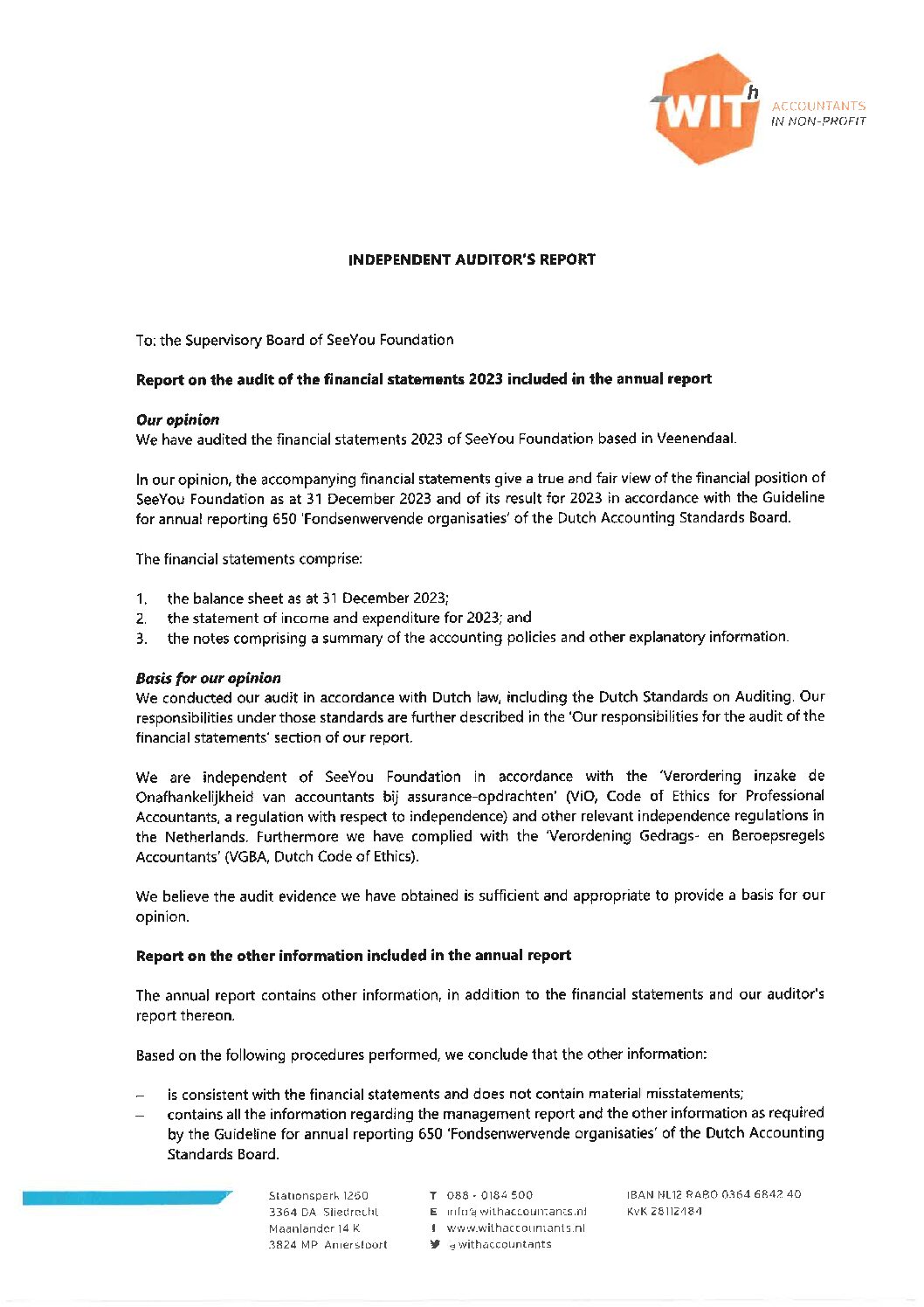
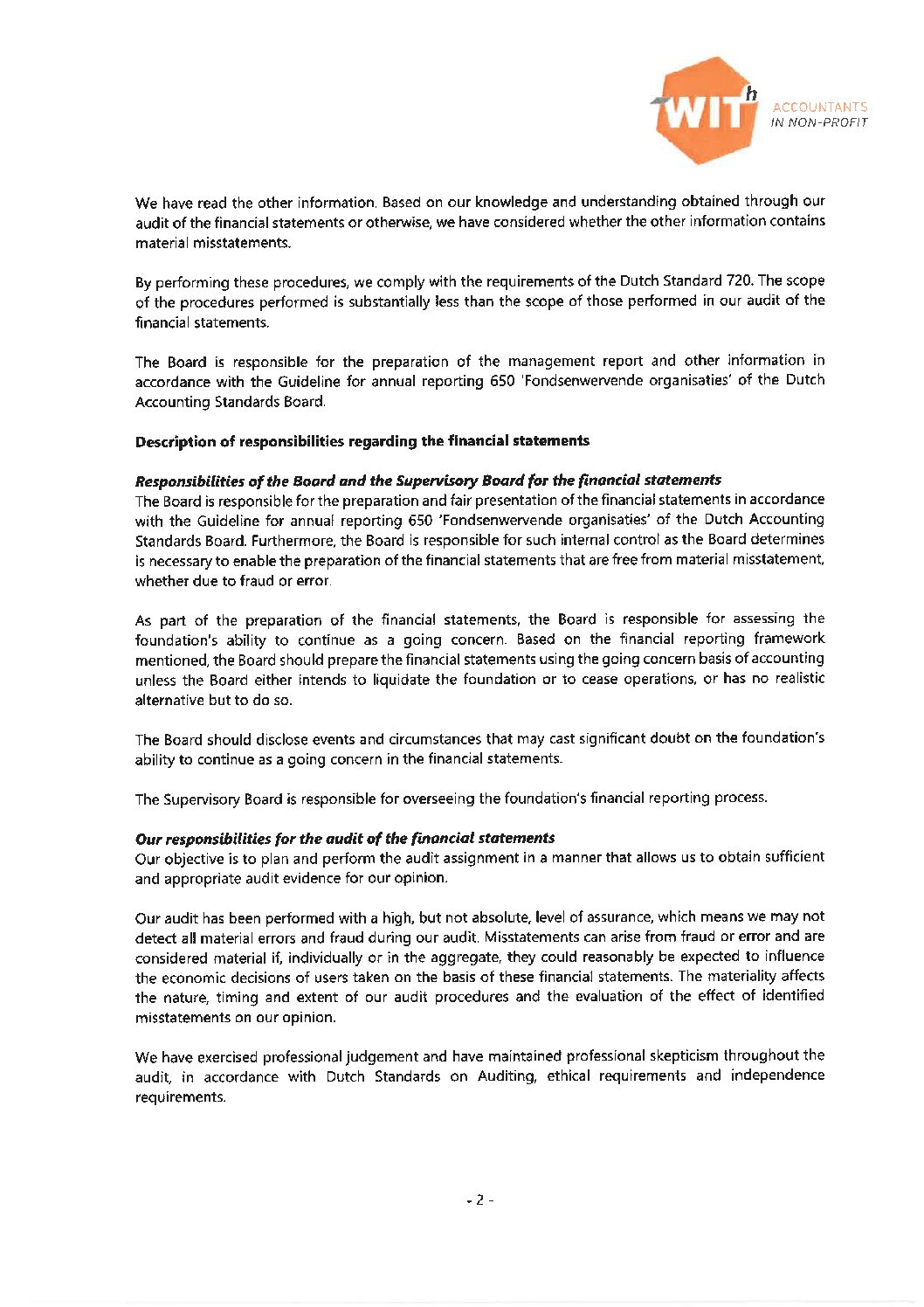
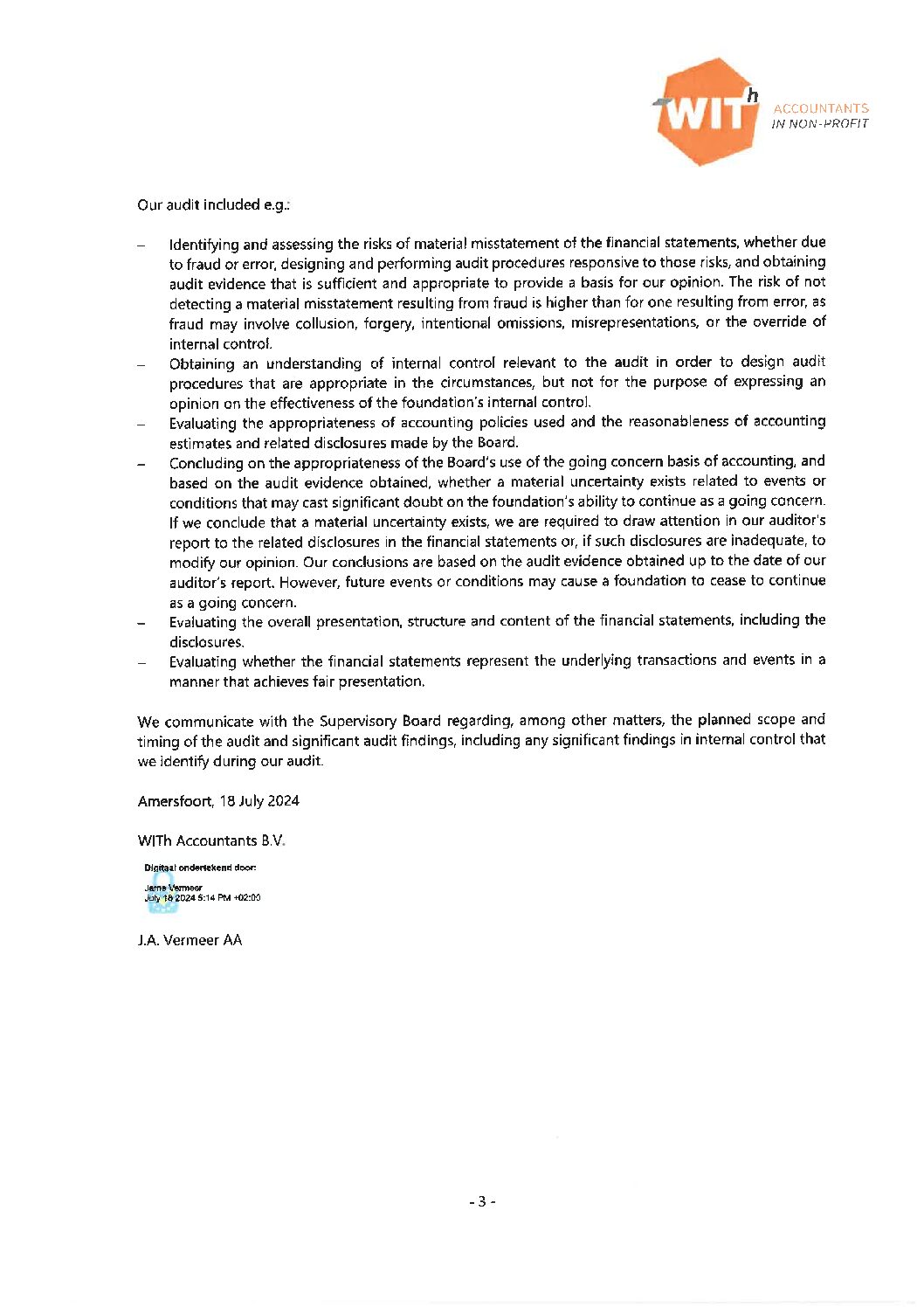
ANNEX BUDGET
| Budget 2024 | Realisation 2023 | Budget 2023 | |
|---|---|---|---|
| € | € | € | |
| Income | |||
| Income from individuals | 830,000 | 1,169,003 | 855,000 |
| Income from companies | 106,000 | 87,565 | 70,250 |
| Grants from governments | 1,223,290 | 1,105,184 | 1,198,985 |
| Income from associated not-for-profit organisations | - | - | - |
| Income from other not-for-profit organisations | 1,476,484 | 1,477,272 | 1,532,462 |
| Sum of income raised | 3,635,774 | 3,839,024 | 3,656,697 |
| Income in return for the provision of services | - | - | - |
| Other income | - | 1,124 | 500 |
| Total income | 3,635,774 | 3,840,148 | 3,657,197 |
| Expenditure | |||
| Spent on objectives | |||
| Participation of people with disabilities in developing countries | 3,066,530 | 2,927,740 | 2,539,276 |
| Awareness raising and education | 223,349 | 299,519 | 437,226 |
| 3,289,879 | 3,227,259 | 2,976,502 | |
| Fundraising | |||
| Fundraising costs | 388,875 | 454,619 | 572,097 |
| Management and administration | |||
| Management and administration costs: | 288,491 | 228,315 | 277,971 |
| Sum of expenditure | 3,967,245 | 3,910,193 | 3,826,570 |
| Balance before financial income and expenditure | -331,471 | -70,045 | -169,373 |
| Balance financial income and expenditure | 2,000 | -12,290 | -11,500 |
| Profit/loss | -329,471 | -82,335 | -180,873 |
| Target spending percentage of the income: Spending on objectives/total income | 90.5% | 84.0% | 81.4% |
| Target spending percentage of the expenditure: Spending on objectives/total expenditure | 82.9% | 82.5% | 77.8% |
| Percentage of income for fundraising Fundraising costs/sum of acquired income | 10.7% | 11.8% | 15.6% |
| Percentage of expenditure for fundraising Fundraising costs/sum of expenditure | 9.8% | 11.6% | 15.0% |
| Management and administration costs: Management and administration costs/total expenditure | 7.3% | 5.8% | 7.3% |

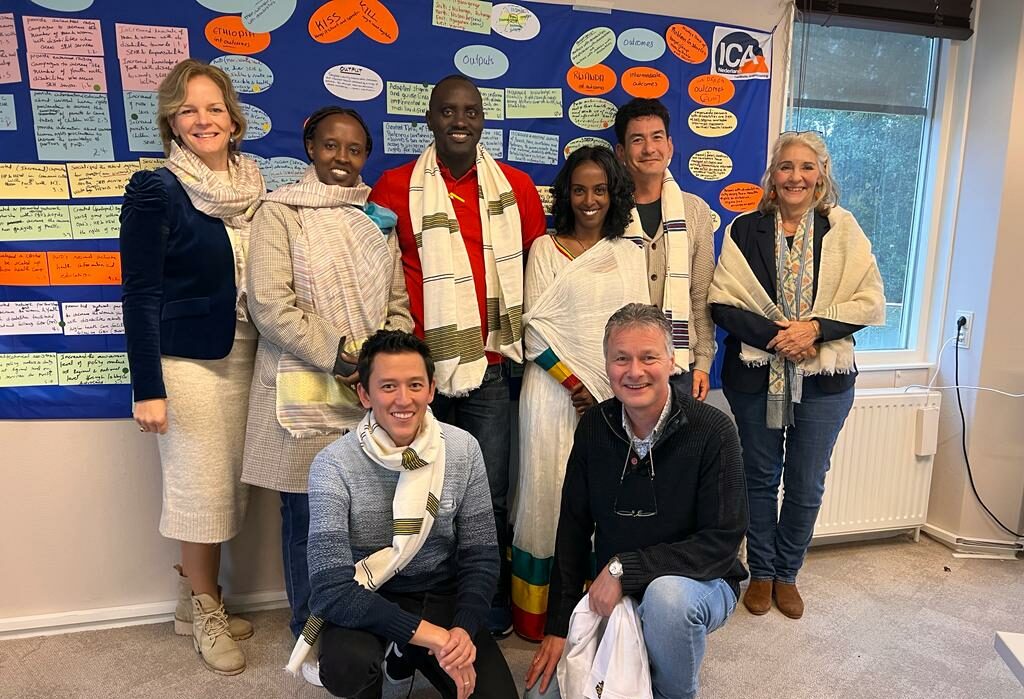
Learning and looking ahead
What we have learned from 2023
We have evaluated our projects EmployAble and Every Life Matters, and the We are Able! programme has undergone an interim evaluation. Several points emerge from these evaluations:
- At present, we still see too often that a local or international development organisation takes the lead in projects, whereas we want advocacy organisations, the representatives of persons with disabilities, to have more ownership. If we can strengthen their position, then advocacy organisations can assume a leadership role towards the government, business and other civil society organisations.
- We have observed that there are differences between projects in terms of how many persons with disabilities our interventions reach and the costs associated with this. Accordingly, we will better monitor the cost-effectiveness, investigate the causes of these differences, and focus on solutions that help more people.
- We are developing our monitoring and evaluation. Now we now have a good idea of who we reach, but less of an idea about which change these people experience thanks to our interventions. We will therefore deploy questionnaires about health, income and participation to measure the impact of projects and the quality of life of persons with disabilities in our projects. Then we will know whether our interventions actually have the intended effect.
Fundraising requires a big investment and we have noticed that we can achieve even greater focus in this area. If we concentrate more on the target groups we already have a connection with, then we can spend our resources more effectively. We will therefore stop several activities, such as door-to-door collections, in 2024.
Together with our donors and strategic partners, we have concluded that expectation management is important. As different organisations, we will benefit from regularly discussing our various approaches in an open manner and evaluating these. Therefore, mutual expectations will receive more attention next year.
Looking ahead
Looking ahead to 2024, we will continue to work on inclusive eye care, inclusive education and employment and advocacy for equal rights of people with disabilities in Africa and Asia. In 2024, we will do this by focusing on the following specific issues:
Programmes
- With a view to our strategy, we want to bring together the different themes in our project countries. In the coming year, we will therefore seek to realise more coherency between the projects in Indonesia, a country that SeeYou has long been connected with. Together with our partners PRY and CBM Global, we will continue the current projects and start a new eye care project.
- We will focus on improving the quality of our core programmes in Ethiopia, Rwanda and Indonesia. We would like to continue the programme for inclusive employment for girls and women in Rwanda, and the Every Life Matters programme may be expanded to Indonesia.
- We will invest in a strong role for advocacy organisations for persons with disabilities within our projects, together with the We are Able! consortium in Uganda, South Sudan and Sudan. In the other project countries, we will deepen the relationship with advocacy organisations.
Collaboration
- In 2024, we will conclude the pilot with the Bartiméus Fund for digital accessibility at schools in Ethiopia, with the ambition of continuing this project on a larger scale.
- We are looking for a collaborative partner who can strengthen our programmes, fundraising or operations because we consider strategic collaboration with organisations that strengthen our mission to be vital.
- We want to support partners and programmes even more effectively. Therefore, for each programme we will put together a team of employees from the departments Programmes, Fundraising and Communication, and Operations. Last year, we took the first steps in that direction, and in 2024, we will fully implement this process.
Internal developments
- Up until the end of 2023, we followed the collective labour agreement Social Work for our primary employment conditions. However, the salary increases agreed upon in that agreement do not fit developments in our organisation. We will evaluate this in 2024 and adapt our policy accordingly.
- In 2024, our fundraising will focus more on the channels with which we have a lot of experience and where we achieve good results, such as fundraising among charities, equity funds and companies.
- We will take steps to further reduce our organisation costs, for example by creating a simpler management structure. Our aim in doing this is to achieve a positive budget result in 2025.
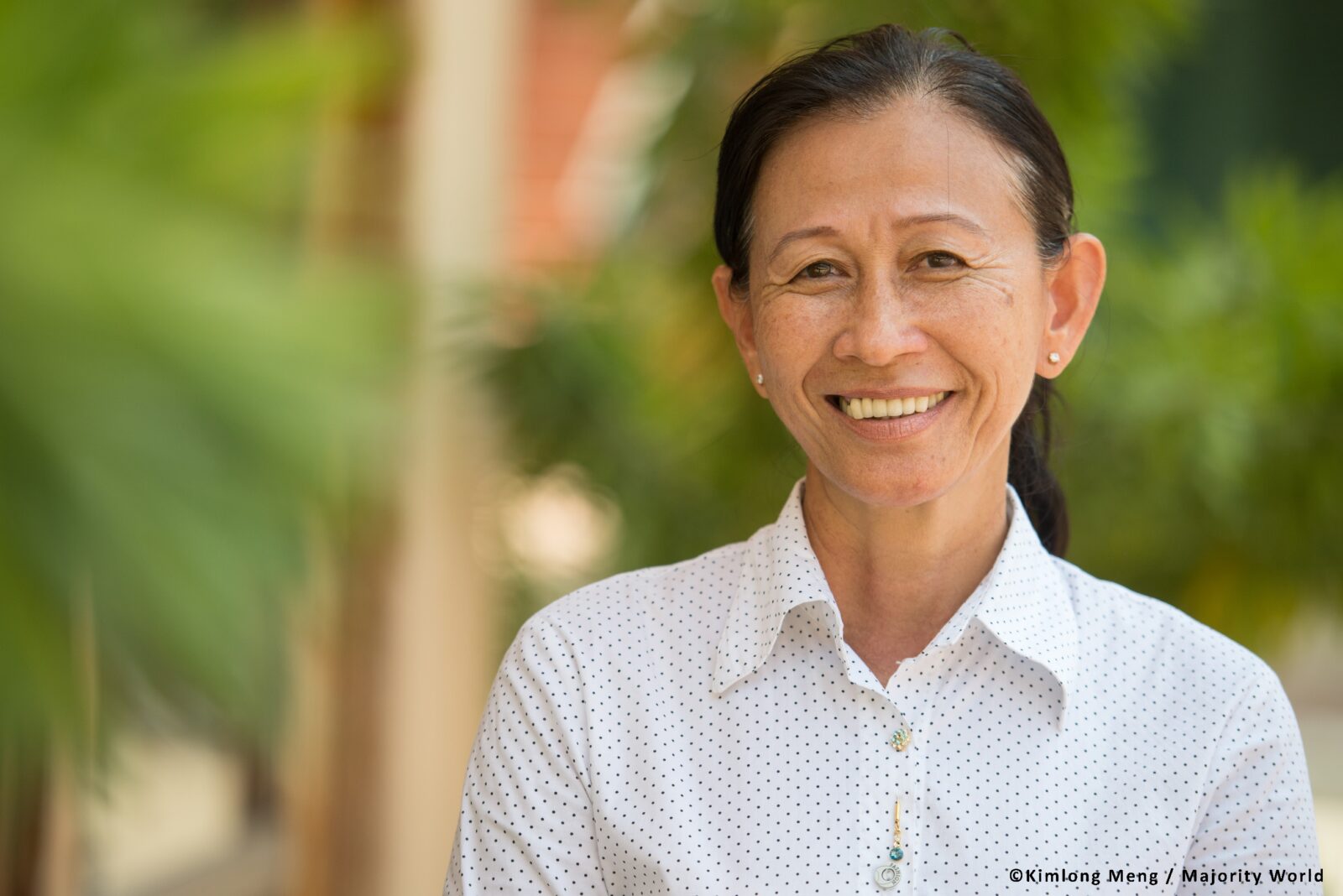
Thanks to all donors
“SeeYou has meant a lot for Krousar Thmey over the years. Many years ago you helped us to build up special education in Cambodia and develop the first Cambodian Braille alphabet and sign language. It’s great to see that SeeYou is now celebrating its 40th anniversary. I want to express my immense gratitude to SeeYou donors. Your support is incredibly important. It enables us to achieve more for children with a visual disability in Cambodia.”
Neang Phalla, educational pioneer in Cambodia
